



The 22nd conference of the Disruption Network Lab, “HATE NEWS vs. FREE SPEECH”, explored polarization and pluralism in Georgian media, opening on 12 December 2020 in partnership with the Regional Democratic Hub – Caucasus.
Introduced by Tatiana Bazzichelli and Lieke Ploeger, the Programme and Community Director of the Disruption Network Lab, the two-day-event brought together journalists, activists and experts from based in Georgia and Germany to look into the manifestations as well as the consequences of information manipulation and deliberate hate speech within the Georgian media landscape.
The conference, held at Kunstquartier Bethanien in Berlin as a combination of online and on-site formats, investigated a hyper-polarised system, in which exploitative manipulation of facts and orchestrated attempts to mislead people through delivering false information are dangerously eroding media independence, pluralism and freedom of speech. In the context of deliberate technology-fuelled disinformation, spread by news outlets of religious and political influence, hostile countries and other malign sources, the work of independent Georgian journalists is often delegitimised by public authorities and denigrated in a wave of generalisations against media objectivity, to undermine independent information and stifle criticism.
As Bazzichelli stressed in her introductory statement, independent journalists reporting on information that is in the public interest are targeted because of the role they play in ensuring an informed society. At the same time, a global process of mystification is progressively blurring the boundary between what is false and what is real, growing to such a level that traditional media seems incapable of protecting society from a tide of disinformation, and becomes part of the problem.

Opening the first panel, “Polarization and Media Ethics in Georgia”, the moderator Maya Talakhadze, Co-Founder of the Regional Democratic Hub – Caucasus explained that, similar to other former Soviet Union countries, the political environment in Georgia has been polarized since the independence of the country. This has led to highly partisan media and to a marked divergence of political attitudes to ideological extremes within the around 3.7 million Georgians. Although the widespread of the internet guaranteed access to new media outlets and social media opened the way to a more pluralistic media environment, Georgian society soon faced the new challenges of widespread online disinformation, ethics violations and hate speech.
Professor Tamar Kintsurashvili, Executive Director of the Media Development Foundation and Associate Professor at Ilia State University, referred to Georgia as the country with the most pluralistic and free media environment in South Caucasus region. Nevertheless, according to Freedom House and Reporters Without Borders, its information system appears weaker and weaker, public broadcasters have been accused of favouring the government and lawmakers have repeatedly attempted to restrict freedom of expression.
Professor Kintsurashvili stressed how such an environment cannot be considered independent and negatively contributes to the polarization of the country. In her critical analysis, Georgian media pluralism could be described as the product of competing political interests, rather than a sign of strong freedom of expression and an independent press in the country. Despite this, Georgian civil society is widely praised for its diversity and strength.
In Georgia, most media have a political affiliation and align themselves with the agenda of a candidate or a party. This results in the actual instrumentalization of mainstream media and the concentration of ownership of TV stations, online media outlets and newspapers in the hands of the dominant political parties, which are shaping the overall media environment.
Professor Kintsurashvili recalled that in 2017 the ownership of pro-opposition Georgian TV channel Rustavi 2 was transferred to the businessman Kibar Khalvashi, its previous owner, after a ruling by the European Court of Human Rights (ECHR). The case is instructive of the complexity of the Georgian media landscape. Khalvashi’s opponents accused him of having close ties to the government and warned that the new ownership could not guarantee freedom of expression and independence for journalists and broadcasts. Following the ECHR ruling, two new opposition broadcasters emerged.
Professor Kintsurashvili highlighted that, to come to a full understanding of the country, one must consider the possible sympathies of the Georgian politicians toward the Russian Federation, despite the 2008 war and its continuous interferences in domestic affairs.
Many critical voices and independent investigations observe that Russia is supporting a galaxy of media outlets active all over the Caucasus, characterised by a lack of transparency and accountability. These actors promote anti-Western propaganda and are partially responsible for the radicalisation and antagonization of the Georgian society, leveraged to disrupt social cohesion and push the country away from the EU’s Eastern Partnership with the six countries of its Eastern neighbourhood –Armenia, Azerbaijan, Belarus, Georgia, Moldova and Ukraine.
Professor Kintsurashvili points out that while outlets such as Sputnik or Russia Today are openly funded by the Russian government or by Russian oligarchs, the ownership structures of dozens of online platforms remain unclear, and many vanish after a few weeks of activity.
In addition to this, the panellist considered that economic resources for independent media are limited and a lack of transparency of financing – especially in online media – which poses a serious problem for the independence and impartiality of many media outlets, as they are not accountable to the Georgian public but to their owners. Neutral newsrooms with no political affiliation are not self-sufficient and manage to have a small impact on the overall environment; nothing compared to big TV channels, which remain the major source of information in the country.

Taking a step from such a polarized environment shaped by domestic and foreign actors with a political agenda, the second panellist Nata Dzvelishvili, Executive Director at Indigo Publishing, focused on the current state of media ethics in Georgia and the lack of media literacy among Georgians. She considered that, in such a polluted disinformation ecosystem, the majority have almost no reliable instruments to orientate and discern good independent journalism, fake news and poor-quality reporting, which means also that the capability to identify verifiable information in the public interest, and information that does not meet precise ethical standards, is limited.
Dzvelishvili is the former Executive Director of the Georgian Charter of Journalistic Ethics, the self-regulatory body of media in Georgia. She pointed out that by decoding the authenticity of online news we can see how, alongside with the so-called fake news, there is also an alarming degree of laxity and journalistic errors arising from poor research and superficial verification. She listed a few frequent unethical behaviours and violations, from the lack of accuracy to unprofessional coverage of facts reported to arouse curiosity or broad interest through the inclusion of exaggerated or lurid details. In Georgia, this last aspect is mirrored in an unfair and hyper-partisan selection of facts, too.
The Georgian Charter of Journalistic Ethics – a body composed of 400 member journalists, which processes complaints and makes decisions on issues regarding ethical standards and principles – warned that Georgian media too often spread news based on unverified facts, or even simple errors, generating misinformation. Bad information undermines the credibility of media, and unprofessional journalism opens the way for widespread disinformation and misinformation.
Dzvelishvili explained that in Georgia the most critical topics subject to manipulation due to political interest are those related to religious sentiment, LGBTQI identities, migration and nationalism. In her intervention she presented examples of campaigns fuelling homophobia, racism and reopening historic traumas, fruitful ground for the growth of ultra-nationalistic, conservative, and pro-Russian narratives.
Many of the media outlets accused of spreading anti-Western and pro-Russian propaganda acted all over the Caucasus to disseminate disinformation about Georgia’s position on the Karabakh conflict, and thus foster hostility between ethnic Armenian, Azerbaijani and Georgian populations. Rumours and fully fabricated stories about Georgian Muslims ready to gain independence led to the concrete risk of a conflict between ethnic Georgians, the religious orthodox and Muslims, and represented a new pretext to call for Russian intervention to resolve the conflict. More recently, the COVID-19 pandemic was used to fuel anti-Western feelings, provoke mistrust in science, discredit Western democracies and divide the country.
Nini Gvilia, Project Assistant for Social Media Monitoring at the International Society for Fair Elections and Democracy (ISFED), focused on social media in Georgia, which – she explained – 20 percent of the population use as their main source of information. Political activities have strongly shifted to Facebook and other social media, with the support of agencies such as The Marketing Heaven, which enables a more pluralised information environment but also sharpens the risk of misuse by malign actors.
News Front, a Georgian-language website, is one of these. Facts can be irrelevant against a torrent of abuse and hatred towards journalists and opponents, made possible by algorithms, fake accounts, coordinated bots and trolls, that generate viral postings on social media. News Front has also been active on Facebook since 2019. Analysing the interactions of its audience, it is observable that manipulation also arises by weaponizing memes to propel hate speech and denigration or creating false campaigns to distract public attention from actual news. Marginal voices and fake news can be disseminated by inflating the number of shares with automated or semi-automated accounts, which manipulate public opinion by boosting the popularity of online posts and amplifying rumours.
Many Georgians are still anchored to very traditionalist and conservative beliefs. Groups of right-wing extremists offer appealing online spaces filled with redundant rhetoric, gossip columns, sport blogs, and other apparently harmless content, which actually underpins anti-liberal, misogynistic, racist and homophobic views, pushing for a new authoritarian turnaround. Too often, mainstream TV channels and newspapers pick up staged news from such a disinformation ecosystem, enforcing a revisionist narrative built on manipulated facts and fake interactions, arrogance and violence.

Eka Rostomashvili, Advocacy and Campaigns Coordinator at Transparency International, moderated the panel “Misinformation on Social Media during Elections”. The opening contribution by Varoon Bashyakarla, Data Scientist at Tactical Tech’s Data & Politics Project, focused on how the ‘digital influence industry’operates. In addition, Bashyakarla dissected some of the dynamics that allow personal data to be weaponised for political purposes.
As he recalled, personal data of potential electors is being used constantly for political purposes – even without a precise agenda, just to spread disinformation. Hundreds of companies around the world profile people to influence and predict their political choices. Working with journalists, academics, and civil society organisations, Bashyakarla underlined how these tech firms exploit personal information as a political asset and source of political intelligence.
Many countries traditionally hold voter rolls containing basic information of their electors. Voters’ data is at the heart of modern campaigning and many of the companies working in consumers tech have opened new divisions dedicated to political technology – a term commonly used in the former Soviet states for a highly developed industry of political manipulation – to build statistical models that spy on voters to learn from their preferences and characteristics. Cambridge Analytica was just one of the many entities collecting and misusing intimate personal data to target and manipulate the electorate.
Last year, personally identifiable information of 4.9 million Georgians from 2011 appeared online. Many suspected that the leak was triggered to undermine voters’ faith in elections. However, a leak consisting of 200 million US-American voter files, with personal data including ethnicity and religion, had already demonstrated in 2017 – illustrating how risky election tech can be. The same happened in the Philippines, where the website of the government was subject to a cyber-attack and 340 gigabytes of the personal details of 55 million voters appeared online, and in Turkey, where in 2016 a leak of a 6.6 gigabyte file made available information of 50 million voters.
Bashyakarla discussed then how the extraction of value from political data works and explained the logic behind A/B testing, deployed to compare the performance of two competing advertisements. He warned that societies around the world are exposed to an unprecedented volume of testing. During the last US elections, for example, on the day of the third presidential debate a single online content could be shared in up to 175,000 different variations to test the reaction of the electorate.
Politicians test their postings, images, headlines and slogans to learn in which areas voters are more sympathetic to their messages; what causes in different regions of the country they care more about; and what topics are more likely to be appreciated by a specific audience. As Facebook suggests in one of its advertisements, these techniques allow you to “find the perfect match between your ad and your audience.”
In Georgia, the volume of unsolicited texting and even phone calls spreading political messages that electors receive before elections is overwhelming. Both pro-government political parties and opposition parties deploy similar tactics, which reach their peak point during elections. Coinciding with this very intense activity, the number of online pages spreading fake news triples, with hatred campaigns amplifying differences and fuelling polarization.

Mikheil Benidze, Chief of Party for the new Georgia Information Integrity Program at the Zinc Network, shared his observations on how social media platforms have been weaponized for electoral purposes and how Georgian civil society has risen to the challenge. In the next few years, the Georgia Information Integrity Program, run by the Zinc Network, is going to look into the activities of online users, to research why certain narratives are successful and what their actual impact is.
Benidze recalled that the web is full of traps, like fake news websites that look like the online version of mainstream newspapers, and TV channels, which deceive readers. These fake websites are used to co-ordinate campaigns and networks of political influence, propagate nationalistic, xenophobic, and homophobic content and to undermine the development of a multicultural liberal democracy. The panellist considered that algorithms amplify those messages even more, and praised Georgian civil society organisations for constantly debunking, exposing and analysing facts to protect a free, democratic and open debate. People get spontaneously together and mobilise to strengthen independent fact-checking initiatives and encourage the co-operation with social networks to monitor and delate online harmful content.
The panel was concluded by the contribution of Rafael Goldzweig, Research Coordinator at Democracy Reporting International, an independent non-profit organisation based in Berlin, which promotes political participation of citizens, accountability of state bodies and the development of democratic institutions worldwide. Goldzweig compared the trends observed in Georgia described throughout the first day of the conference with what happens in other countries. He offered an overview of regulatory approaches and initiatives – particularly those debated in the European Union – for making the online environment more resilient against disinformation, hate speech and other challenges.
The digital sphere and its interactions proved to be able to determine the course of elections and host activities, which can undermine the stability of a fragile institutional system. The researcher pointed out that, all over the world, social media has become subject to electoral observation, too, to monitor the rights of candidates and of the electorate.
Goldzweig is confident that more organisations and actors around the world can replicate the monitoring activities of Democracy Reporting International. He suggested that transparency and monitoring are fundamental to understand what happens online, and that we are facing a multi-stakeholder responsibility, since tech companies are asked to provide solutions and governments to maintain a central role. These actors must facilitate the monitoring by civil society and implement tech that enforces community standards able to guarantee individual and collective rights.
The first day’s guests presented a clearer image of the complex situation in the Georgian media landscape, in which disinformation and propaganda seek to animate people into becoming conduits of divisive messages and violence. All panellists expressed concern about the alarming levels of homophobia and xenophobia. Several contributions suggested that journalistic self-regulation and a respect for precise ethical principles appear to be the only way to guarantee strong and free information systems, keeping in mind that Georgian democratic institutions are still fragile and that lawmakers will try to implement new regulations as a leverage to limit freedom of expressions.

The conference’s closing panel, “Hate Speech & Human Rights”, was moderated by performer and journalist Azadê Peşmen. The talk opened with a focus on hate speech, violence and discrimination based on sexual orientation and gender identity in Georgia.
Giorgi Tabagari, Co-Founder and Director of Tbilisi Pride, gave the audience the chance to learn more about LGBTQI rights in the country. Georgian legislation directly prohibits discrimination against all LGBTQI people, nevertheless – as set out in the previous panels of the conference – there is a high level of hostility against queer people everywhere in Georgian society. Gay and transgender people, along with Jehovah Witnesses, Muslims and Armenians, are publicly presented as national enemies and homosexuality is considered an inexcusable moral corruption.
In Georgia the simple existence of LGBTQI people is a taboo. The mainstream media do not consider sexual and gender identity outside the binary representation of heterosexual men and women. Queer people appear to be the most despised group in the society, which is a fact taken for granted as a normal aspect by most Georgians. Tabagari recalled that an effective way to inflict a damaging insult and to ruin the reputation of a Georgian is to accuse that person of being homosexual: a moral corruption, worse than being a criminal.
The Georgian Orthodox Church has played a defining role in this. Not only does it condemn homosexuality as a sin, but it is also the front line of a violent mobilisation of individuals against queer people. For years, homophobic views have been encouraged by public officials and deployed to delegitimise and discredit political opponents. Investigations found that far-right and hate groups behind these actions were often linked to official parties sitting in the institutions.
By and large, Georgia is a conservative, homophobic country. Many participants of the conference could confirm that less hateful content has been hosted on traditional media in these last two years, whilst social media has been used to build a network of hateful content and online misinformation campaigns targeting LGBTQI activists. Hate and violence have been increasing for a long time, Tabagari warned. Due to more frightening levels of stigma and hatred, LGBTQI people and activists face constant and enormous challenges in Georgian society. Hate crimes and abuses revealed also to significantly increase the risk of poor mental health, from which many queer people suffer. As of today, no statistics about crimes conducted on sexual orientation or gender identity grounds in the country are available. However, it is obvious that the Georgian law prohibiting hate crimes, alone, is not sufficient.

The second panellist, Nino Danelia, Head of Journalism and Media Research at Ilia State University and Founder of the Coalition for Media Advocacy, discussed the implementation of existing national and international human rights standards to combat online hate speech in Georgia.
As described throughout the conference, the Georgian media landscape appears to be a competitive pluralistic system, but highly polarized. Danelia reported that television remains the main source of news and information for the majority of the country, whilst 25 percent of Georgians use internet – and particularly Facebook – to get informed.
On paper, Georgian laws meet international standards, as the country sanctions all forms of expression promoting or justifying racial hatred, xenophobia, and religious based intolerance, including aggressive nationalism and hostility against minorities and migrants.
Hate speech is not criminalised and it is regulated de facto by the Law on Broadcasting and by the Code of Conduct for Broadcasters. Danelia also warned that – in the fragile Caucasian democracy – a new regulation of hate speech could be a threat to media and editorial independence.
Danelia concluded her intervention by explaining that, in her opinion, the issue of polarised, controlled and impartial media can be tackled by strengthening existing self-regulatory mechanisms and funding professional training for journalists. According to the Georgian Charter of Journalistic Ethics, reporters must exert every effort to avoid hate speech that can cause fragmentation and radicalisation of the society.
Political leaders are asked to be careful and avoid violent and ambiguous expressions in their public speeches – not to facilitate, incite or justify hatred founded on intolerance and identity-based convincement. A delicate aspect is still represented by those political groups that propose to prohibit “offending the religious sensibilities or feelings”, which would constitute an area of legal uncertainty and arbitrariness, negatively affecting free speech.

Josephine Ballon, Legal Head at Hate Aid, gave an overview of the German legal perspective on hate speech, beginning from the fact that 78 percent of German internet users have already witnessed hate speech on the internet, whilst 17 percent have been a direct victim of these practices. Researchers calculate that, also in Germany, only 5 percent of users are responsible for almost 50 percent of hateful content.
Balloon recounted an example of neo-Nazis, united under the label “Reconquista Germanica”, and the Austrian Identitarian Movement, pointing out that an official 2019 investigation proved that 70 percent of the hate crimes and hate comments on the internet reported to the authorities were executed by far-right movements.
Such a violent spread of hate intimidates people. Not just those directly targeted, but the majority of internet users admit to being afraid of expressing their political opinions on the internet, fearing the campaigns targeting those who speak out. More precisely, Ballon reported that more than half of the people interviewed do not dare to express political opinions online, as they are afraid of the possible consequences.
The lawyer gives counselling to those who are affected by hatred and discrimination online and teaches them how to protect their data. Personality rights can be defended by directly suing the person responsible of the offence.
Georgian far-right and anti-liberal groups are strong enough to try to influence public opinion, backed by Russian propaganda, and this radicalisation seeks to fragment society even more. Both in Germany and in Georgia, journalistic standards are not applicable to social media and to user-generated content. In 2017, Germany introduced one of the most advanced laws regulating online hate speech at the time, the Network Enforcement Act (NetzDG), requiring internet companies to remove offensive content within 24 hours, or to face up to 50 million euros in fines. Other countries that tried to regulate the same subject ended up approving unconstitutional laws.
The importance of tolerance between diverse groups is stressed in the Georgian national Constitution, which guarantees and defends citizens’ fundamental rights and freedoms. Moreover, the law on broadcasting foresees a ‘National Communications Commission’ to regulate telecommunications and broadcast media. The Commission is supposed to be an independent regulatory body accountable to the legislative, but its practices are often criticised, and it is accused of being loyal to the executive branch.
In Georgia, 80 percent of the population who use the internet have a Facebook account. Zuckerberg’s company is the most popular social network in the country. During the last elections, the tech firm came under a lot of pressure from civil society asking to enforce effective measures to stop hate speech and fake news interfering with the democratic process. Twitter is less popular in Georgia, hosting more international users, who mostly write in English. Recently, social media platforms demonstrated themselves to be able to co-operate with local non-governmental organisations to monitor online content. These activities led to ban, and the shut-down of many pages. However, concerns have arisen considering that, between elections, as civil society lets its guard down, those same groups are free to proliferate and spread their content again.

Some keywords resonated throughout the conference, as a fil rouge connecting the speakers and debates held during the panels and commentaries by the public. Participants warned that the era of self-regulation of online social media platforms must come to end, as they have proved that their ruthless interest in clicks, interactions and profit comes before democracy and human rights. For almost a decade now, the spread of disinformation and misinformation through websites, social networks and social messaging has been begging the question of the extent of regulation and self-regulation of the companies providing these services.
On the other hand, the executive and legislative interference in the Georgian courts remains a substantial problem in the country, as does a lack of transparency and professionalism surrounding judicial proceedings. For these reasons, self-regulation remains the only plausible option for editors and journalists.
Media literacy and awareness-raising have been widely recognised as effective and reliable tools to oppose the spread of harmful content and, at the same time, tackle the system of disinformation and violence threatening Georgia. Education, together with strong independent journalists, who know and respect journalistic standards.
On the other hand, we see that economic uncertainties – fear, anger, and resentment – are leveraged to spread campaigns of hatred, attack opponents, discriminate minorities and activists. Conspiratorial, paranoid thinking and violent interactions act like a catalyst, provoking participation and fascinating individuals. Considering that it is all about the benefits of personalised advertising, and ultimately the need for clicks, many observers think that social media will never renounce to such a source of profit.
The collaborative project “HATE NEWS vs. FREE SPEECH: Polarization and Pluralism in Georgian Media” had its first phase between September and October 2020, with two trainings in Georgia on traditional and non-traditional journalism, organised by the Regional Democratic Hub – Caucasus. The announcement of the training triggered high interest, with 120 applications received for 30 places. The first training in Georgia was held in the Kakheti Region involving journalists, (social) media representatives and bloggers from the eastern regions of Georgia. The second training, which took place in October in the Samtskhe Javakheti Region, was held for the students of journalistic faculties with special focus on the regional universities. The training sessions addressed several key areas, among them digital and media literacy, media ethics, hate news and hate speech.
The project ended with this conference and a workshop in Berlin titled “Anatomy of a Conspiracy Theory”, run on December 13 by researcher, trainer and consultant Alistair Alexander, with participants from both Tbilisi and Berlin. The workshop discussed several conspiracy fantasies from around the world, to understand what makes them work and how to challenge their circulation.
HATE NEWS vs. FREE SPEECH provided a forum for discussion and on complex issues, with particular attention for different perspectives of the international guests – especially women – who animated the debate.

For further details of our speakers and topics, please visit the event page: https://www.disruptionlab.org/hate-news-vs-free-speech
The 23rd conference of the Disruption Network Lab, curated by Tatiana Bazzichelli, was titled “Behind the Mask: Whistleblowing During the Pandemic.“ It took place on 18-20 March, 2021.
You can re-watch the panels here: https://www.disruptionlab.org/behind-the-mask
To follow the Disruption Network Lab sign up for the newsletter and get informed about its conferences, meetups, ongoing researches and projects.
The Disruption Network Lab is also on Twitter, Facebook and Instagram.
The 21st conference of the Disruption Network Lab “Borders of Fear” was held on the 27th, 28th, and 29th November 2020 in Berlin’s Kunstquartier Bethanien. Journalists, activists, advocates, and researchers shed light on abuses and human rights violations in the context of migration management policies. Keynote speeches, panel discussions and several workshops were held involving a total number of 18 speakers and bringing together hundreds of online viewers.
Drawing on insights from humanities, science and technology studies, participants analysed from different perspectives the spread of new forms of persecution and border control targeting people on the move and those seeking refuge. They reflected collectively on forms of social justice and discussed the politics of fear that crystalize the stigmatisation of migrants. By concretely addressing these issues the conference also investigated the deployment of technology and the role of media to consolidate a well-defined structure of power, and outlined the reasons behind the rise of borders and walls, factors that lead to cultural and physical violence, persecution, and human rights violations.
In her introductory statement Dr. Tatiana Bazzichelli, founder and director of the Distruption Network Lab, presented the programme of the conference meant to address the discourse of borders both in their material function, and in their defining role within a strategy of dehumanization and racialisations of individuals. Across the globe, an unprecedented number of people are on the move due to war, economic and environmental factors. Bazzichelli recalled the urgent need to discuss human-right-related topics such as segregation and pushbacks, refugee camps and militarization of frontiers, considering the new technological artilleries available for states, investigating at the same time how border policing and datafication of society are affecting the narrative around migrants and refugees in Europe and the in the West.
The four immediate key content takeaways of the first day were the will to prevent people from reaching countries where they can apply for refugee status or visa; the externalisation polices of border control; the illegal practice of pushbacks; and systematic human rights violations by authorities, extensively documented but difficult to prove in court.

The conference opened with the short film by Josh Begley “Best of Luck with the Wall” – a voyage across the US-Mexico border – stitched together from 200,000 satellite images, and a talk by lawyer Renata Avila, who gave an overview of the physical and socio-economic barriers, which people migrating encounter whilst crossing South and Central America.
Avila took step from the current crises in South and Central America, to describe the dramatic migration through perilous regions, a result of an accumulation of factors like inequality, corruption, mafia, and violence. Avila pointed out that oligarchic systems from different countries appear to be interconnected in complicated architectures of international tax evasion, ruthless exploitation of resources, oppression, and the use of force. In those same places, people experience the most brutal inequality, poverty and social exclusion.
Since the ‘90s the regional free trade agreement meant open borders for products but not for people. In fact, it was an international policy with devastating effects on local economies and agriculture. People on the move in search for a better future somewhere else found closed borders and security forces attempting to block them from heading north towards Mexico and the U.S. border. In these years, the police forceful response to the migrants crossing borders have been widely praised by the governments in the region.
The fact of travelling alone is a red flag, especially for women, and the first wall people meet is in their own country. People on their way to the north experience every kind of injustice. Latin America has often been regarded as a region with deep ethnic and class conflicts. Abandoning possible stereotypical representations, we see that the bodies of the people on the move are at large sexualised and racialized for political reasons. Race, therefore, is another factor to consider, especially when we look at the journey of individuals on the move. Aside, languages in South America could also represent a barrier for those who travel without translators in a continent with dozens of indigenous languages.
Avila concluded her intervention mentioning the issue of digital colonialism and the relevance of geospatial data. Digital is no longer a separated space, she warned, but a hybrid one relevant for all individuals and whose rules are dictated by a small minority. People and places can be erased by those very few companies that can collect data, and –for example– draw and delete borders.

The panel on the first day titled “Migration, Failing Policies & Human Rights Violations,” was moderated by Roberto Perez-Rocha, director for the international anti-corruption conference series at Transparency International, and delivered by Philipp Schönberger and Franziska Schmidt, coordinators of the Refugee Law Clinic Berlin, together with investigative journalist and photographer Sally Hayden. The panellists referred to their direct experience and work, and reflected on how the EU migration policy is factually enforcing practices that cause violation of human rights, suffering, and desperation.
The Refugee Law Clinic Berlin e. V. is a student association at the Humboldt University of Berlin, providing free of charge and independent legal help for refugees and people on the move in Berlin and on the Greek island of Samos. The organisation also offers training on asylum and residence law in Berlin and runs the website ihaverights.eu, designed to allow access to justice to those in marginalised communities.
Through a legal counselling project on the Greek island of Samos, the collective helps people suffering from European illegal practices at the Union’s borders, providing the urgent need of effective ways to guarantee them access to justice and protection. As Schönberger and Schmidt recalled, refugees, and people on the move within the EU find several obstacles when it comes to the enforcement of their rights. For such a reason, they shall be guaranteed procedural counselling by the law to secure, among other services, a fair asylum procedure. However, the Clinic confirmed that such guarantees are not being completely fulfilled in Germany, nor at Europe’s borders, in Samos, Lesvos, Leros, Kos, or Kios.
The panellists explained how their presence on the island gives a chance to document that these camps of human suffering are actually a structural part of an EU migration policy aimed at deterring people from entering the Union, result of deliberate political decisions taken in Brussels and Berlin. Human rights violations occur before arriving on the island, as people are intercepted by the Greek coastguard or by the European Border and Coast Guard Agency (Frontex), and then pushed back to the Turkish border.
The camp in Samos, with a capacity of a maximum 648 people, is instead the home to 4,300 residents, with no water, no sanitary services, poisonous food, and no medical services. Even very serious cases documented to local health authorities remain unattended. The list of violations is endless and the complete lack of adequate protection for unaccompanied minors represents another big issue in this like in all others Greek hotspots, together with the precarity of vulnerable groups, whose risks increase with race, gender, and sexual identity.
The legal team from Berlin prepares applications to the EUCHR court and in these years has filed also 60 requests for urgent procedure due to the risk of irreparable harm, which were granted, ordering adequate accommodation and medical treatment for people in extreme danger.

Many observers criticise that the sufferings in the Aegean and on the Greek islands is the result of precise political decisions. Agreed in March 2016, the EU-Turkey deal is a statement of cooperation that seeks to control the crossing of people from Turkey to the Greek islands. According to the deal, every person arriving without documents by boat or without official permission or passage to the Greek islands would be returned to Turkey. In exchange, EU Member States would take Syrian refugees from Turkey. NGOs and international human rights agencies denounce that Turkey, Greece, and the EU have completely failed on humanitarian grounds and dispute the wrong premise that Turkey is a safe country for refugees and asylum-seekers.
Journalist and photographer Sally Hayden looked at the EU-Turkey deal, defining it as a prototype for what would then happen in the central Mediterranean. Libya, a country at war with multiple governments, is the destination of people on move and refugees from all over Africa, willing to cross the Mediterranean Sea. As it is illegal to stop and push people back, for years now the EU has been financing the Libyan coastguard to intercept and pull them back. What follows is a period of arbitrary and endless detention.
Hayden writes about facts; she is not an activist. When she talks about Libya, she refers to objective events she can fact check, and individual stories she has personally collected. Her reports represent a country at war, unsafe not just for refugees and people on the move but for Libyans too. With her work, the journalist has extensively documented how refugees and migrants smuggled into Libya are subject to human trafficking, forced labour, sexual exploitation and tortures, trapped in an infernal circle of violence and death. She recalled her experience with the detainees in Abu Salim, where 500 hundred people suffer from illegal and brutal incarceration inside a centre affiliated with the government in Tripoli. In July 2020, during the conflict, one of these many prisons not far from the city was bombed. At least 53 illegally detained people were killed.
Hayden’s work provides a picture of the results of Europe’s management of the migration crises in the Mediterranean and Northern Africa. EU funds are employed for militarization of borders and externalisation of frontiers control. The political context, in which this occurs, is the cause of years and sometimes decades of lack of investment in reception and asylum systems in line with EU-State’s generic obligations to respect, protect and fulfil human rights.
All panellists called for the immediate intervention to evacuate camps and prisons that were the result of the EU migration policies, to allow migrant victims of abuses and refugees to seek justice and safety elsewhere.
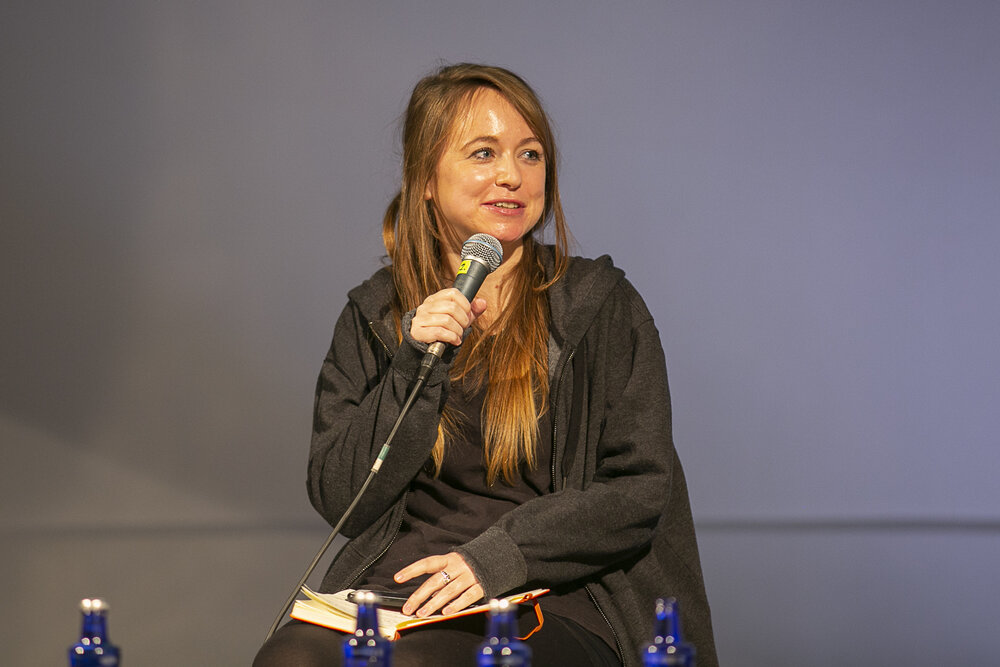
The evening closed with the panel discussion titled “Illegal Pushbacks and Border Violence” and moderated by Likhita Banerji, a human rights and technology researcher at Amnesty International. Banerji reminded the audience that in the first nine months of 2020 there had already been 40 pushbacks, illegal rejections of entry, and expulsions without individual assessment of protection needs, had been documented within Europe or at its external borders. Since these illegitimate practices are widespread, and in some countries systematic, these pushbacks cannot be defined as incidental actions. They appear, instead, to be institutionalised violations, well defined within national policies.
People who shall receive asylum or be rescued, are instead pushed back by police forces, who make sure that the material crossing of the borders remains undocumented. EU member States want to keep undocumented migrants, asylum seekers and refugees outside of their jurisdiction to avoid moral responsibilities and legal obligations. During the second panel of the day, Hanaa Hakiki, legal advisor at the ECCHR Migration Program, filmmaker and reporter Nicole Vögele, and Dimitra Andritsou, researcher at Forensic Architecture, had the chance to go in-depth and to consider the different aspects of these violations.
Hanaa Hakiki, in her intervention “Bringing pushbacks to justice” presented the difficulties that litigators experience in court to materially document pushbacks, which are indeed not meant to be proven. She defined pushbacks as a set of state measures, by which refugees and migrants are forced back over the border – generally shortly after having crossed it – without consideration of their individual circumstances and without any possibility for them to apply for asylum or to put forward arguments against the measures taken.
There are national and international laws that need to be considered in these cases, constituting binding legal obligations for all EU Member States. As a general principle, governments cannot enact disproportionate force, humiliating and degrading treatment or torture, and must facilitate the access to asylum, guarantee protection to people, and provide them access to individualised procedures in this sense.
Member States know that pushbacks have been illegal since a 2012 ECtHR judgment, known as the “Hirsi Jamaa Case,” which found that Italy had violated the law in forcing people back to Libya. However, the effective ban on direct returns led European countries to find other ways to avoid responsibility for those at sea or crossing their borders without documents, and concluded agreements with neighbouring countries, which are requested to prevent migrants from leaving their territories and paid to do so, by any means and without any human rights safeguards in place. By outsourcing rescue to the Libyan authorities, for example, pushbacks by EU countries turned into pullbacks by Libyan coastguard.
Land-pushbacks are still common practice. Hakiki explained that the European Centre for Constitutional and Human Rights (ECCHR) has worked with communities of undocumented migrants since 2014, considering potential legal interventions against the practice of pushbacks at EU borders, and assisting affected persons with individual legal proceedings. She presented three cases the ECCHR litigated in Court (N.D. and N.T. v. Spain; AA vs North Macedonia; SB vs. Croatia) proving that European countries illegally push people back, in violation of human rights laws. Despite the fact that this is still a common practice, it is very difficult to document these violations and have the authorities condemned.
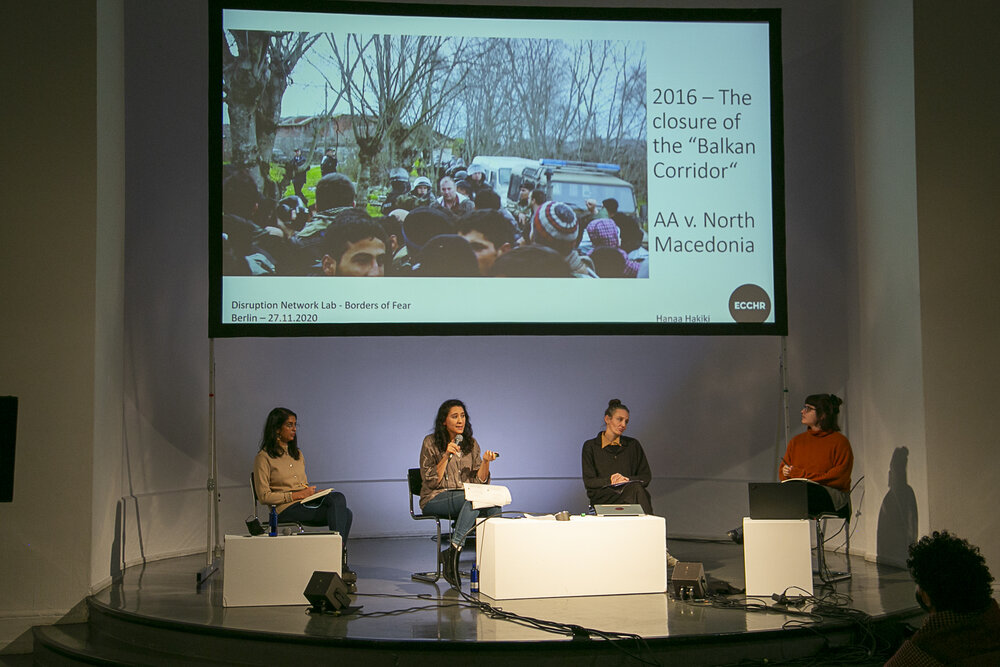
During the beginning of the Syrian conflict, in 2015, refugees were able to travel via Serbia and Hungary into Central and Northern Europe. A couple of years later the EU decided to close down again this so-called Balkan Route, with the result that more and more people found themselves stuck in Bosnia-Herzegovina, prevented from continuing onward to Europe’s territories. From there a person can try to enter the European Union dozens of times, and each time is stopped by Croatian security forces, beaten, and then dragged back across the border to Bosnia-Herzegovina.
After having seen the effects of these illegal practices and met victims of dozens of violent pushbacks in Sarajevo, in 2019 the reporter Nicole Vögele and her crew succeeded in filming a series of these cross-border expulsions from Croatia to Bosnia Herzegovina near the village of Gradina, in the municipality of Velika Kladuša. The reporter, one of the few who succeeded in documenting this practice, also interviewed those who had just been pushed back by the Interventna Policija officers. The response of the Bosnian authorities to her reportage was a complete denial of all accusations.
Vögele then presented footage taken at the EU external border in Croatia, in March 2020, showing masked men beat up refugees and illegally pushing them back to Bosnia. The journalist and her team found the original video, analysed its metadata, and interviewed the man captured on it. Once again, their work could prove that these practices are not isolated incidents.
The panel closed with the investigation by Forensic Architecture part of a broader project on cases of pushbacks across the Evros/Meriç river. Team member Dimitra Andritsou presented the organisation founded to investigate human rights violations using a range of techniques, flanking classical investigation methods including open-source investigation video analysis, spatial and architectural practice, and digital modelling.
Forensic Architecture works with and on behalf of communities affected by state and military violence, producing evidence for legal forums, human rights organisations, investigative reporters and media. A multidisciplinary research group – of architects, scholars, artists, software developers, investigative journalists, archaeologists, lawyers, and scientists – based at the University of London, works in partnership with international prosecutors, human rights organisations, political and environmental justice groups, and develops new evidentiary techniques to investigate violations of human rights around the world, armed conflicts, and environmental destruction.
The Evros/Meriç River is the only border between Greece and Turkey that is not sea. For years migrants and refugees trying to cross it to enter Europe have been reporting that unidentified and generally masked men catch, detain, beat, and push people back to Turkey. Mobile phones, documents, and the few personal things they travel with are confiscated or thrown into the river, not to leave any evidence of these violations behind. As Andridsou described, both Greek and EU authorities systematically deny any wrongdoing, refusing to investigate these reports. The river is part of a wider ecosystem of border defence and has been weaponised to deter and let die those who attempt to cross it.
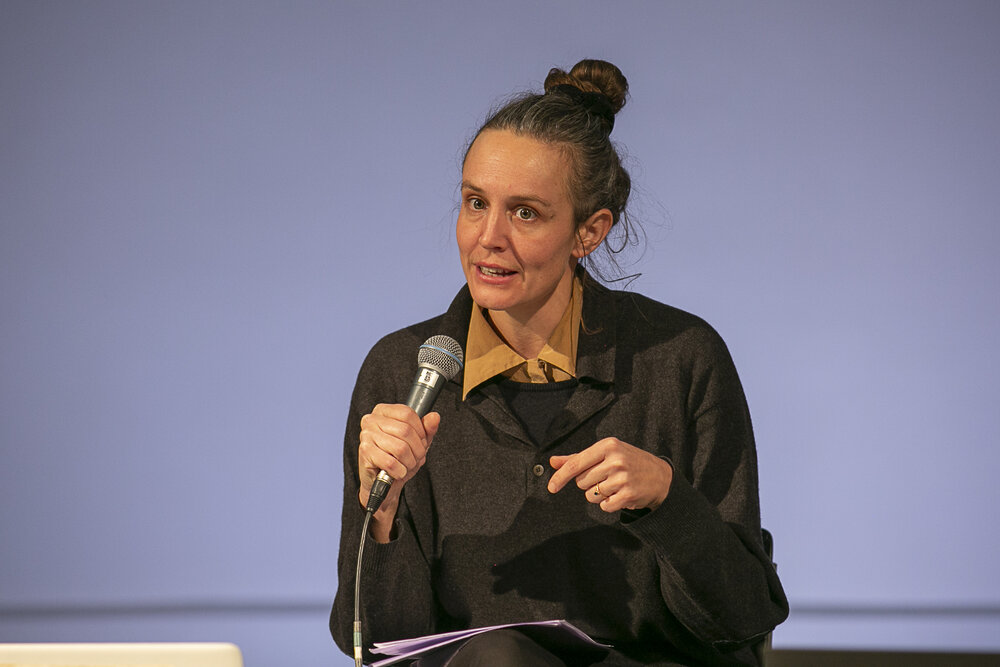
In December 2019, the German magazine Der Spiegel obtained rare videos filmed on a Turkish Border Guard’s mobile phone and on a surveillance, camera installed on the Turkish banks of the river, which apparently documented one of these many pushback operations. Forensic Architecture was commissioned to analyse the footages. A team of experts was then able to geolocate and timestamp the material and could confirm that the images were actually taken few hundred metres away from a Greek military watchtower in Greece.
Andritsou then presented the case of a group of three Turkish political asylum seekers, who entered Greek territory on 4 May 2019, always crossing the Evros/Meriç river. In this case a team of Forensic Architecture could cross-reference different evidence sources, such as new media, remote sensing, material analysis, and witness testimony and verify the group’s entry and their illegal detention in Greece. A pushback to Turkey on the 5 May 2019 led to their arrest and imprisonment by the Turkish authorities.
Ayşe Erdoğan, Kamil Yildirim, and Talip Niksar had been persecuted by the Turkish government on allegations of involvement in Fettulah Gulen’s movement. The group on the run had shared a video appealing for international protection against a possible forced return to Turkey and digitally recorded the journey via WhatsApp. All their text messages with location pins, photographs, videos and metadata prove their presence on Greek soil, prior to their arrest by the Turkish authorities. The investigation could verify that the three were in a Greek police station too, a fact that matches their statement about having repeatedly attempted to apply for asylum there. Their imprisonment is a direct result of the Greek authorities contravening the principle of non-refoulement.
Some keywords resonated throughout the first day of the conference, as a fil rouge connecting the speakers and debates held during the panels and commentaries by the public. Violence, arbitrariness and lawlessness are wilfully ignored –if not backed– by EU Member States, with authorities constantly trying to hide the truth. Thousands of people live under segregation, with no account or trace of being in custody of authorities free to do with them whatever they want.
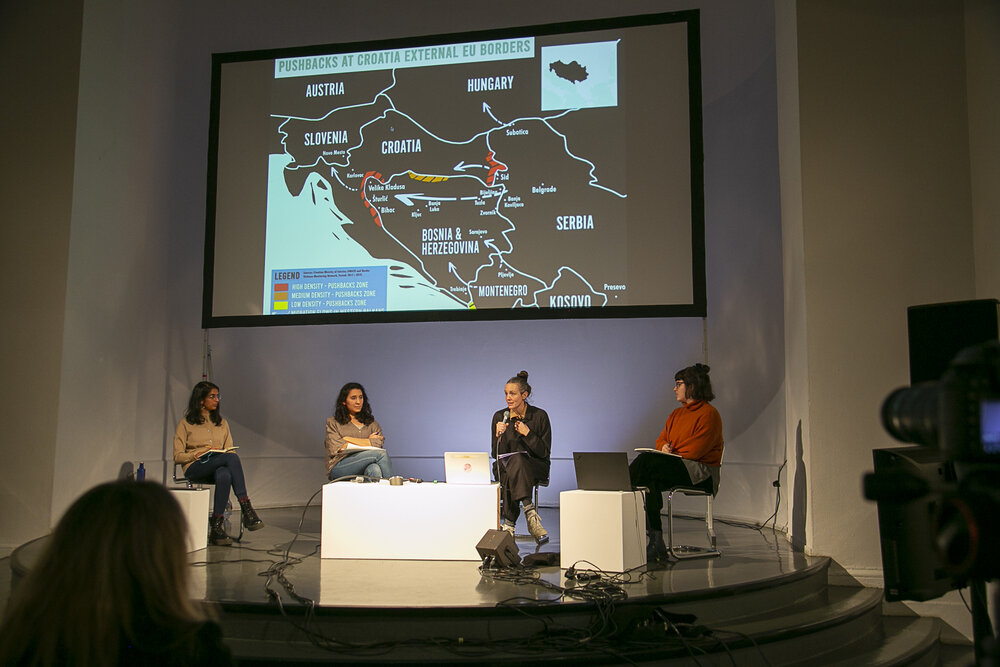
Technology has always been a part of border and immigration enforcement. However, over the last few years, as a response to increased migration into the European Union, governments and international organisations involved in migration management have been deploying new controversial tools, based on artificial intelligence and algorithms, conducting de facto technological experiments and research involving human subjects, refugees and people on the move. The second day of the conference opened with the video contribution by Petra Molnar, lawyer and researcher at the European Digital Rights, author of the recent report “Technological Testing Grounds” (2020) based on over 40 conversations with refugees and people on the move.
When considering AI, questions, answers, and predictions in its technological development reflect the political and socioeconomic point of view, consciously or unconsciously, of its creators. As discussed in the Disruption Network Lab conference “AI traps: automating discrimination” (2019)— risk analyses and predictive policing data are often corrupted by racist prejudice, leading to biased data collection which reinforces privileges of the groups that are politically more guaranteed. As a result, new technologies are merely replicating old divisions and conflicts. By instituting policies like facial recognition, for instance, we replicate deeply ingrained behaviours based on race and gender stereotypes, mediated by algorithms. Bias in AI is a systematic issue when it comes to tech, devices with obscure inner workings and the black box of deep learning algorithms.
There is a long list of harmful tech employed at the EU borders is long, ranging from Big Data predictions about population movements and self-phone tracking, to automated decision-making in immigration applications, AI lie detectors and risk-scoring at European borders, and now bio-surveillance and thermal cameras to contain the spread of the COVID-19. Molnar focused on the risks and the violations stemming from such experimentations on fragile individuals with no legal guarantees and protection. She criticised how no adequate governance mechanisms have been put in place, with no account for the very real impacts on people’s rights and lives. The researcher highlighted the need to recognise how uses of migration management technology perpetuate harms, exacerbate systemic discrimination, and render certain communities as technological testing grounds.
Once again, human bodies are commodified to extract data; thousands of individuals are part of tech-experiments without consideration of the complexity of human rights ramifications, and banalizing their material impact on human lives. This use of technology to manage and control migration is subject to almost no public scrutiny, since experimentations occur in spaces that are militarized and so impossible to access, with weak oversight, often driven by the private sector. Secrecy is often justified by emergency legislation, but the lack of a clear and transparent regulation of the technologies deployed in migration management appears to be deliberate, to allow for the creation of opaque zones of tech-experimentation.
Molnar underlined how such a high level of uncertainty concerning fundamental rights and constitutional guarantees would be unacceptable for EU citizens, who would have ways to oppose these liberticidal measures. However, migrants and refugees have notoriously no access to mechanisms of redress and oversight, particularly during the course of their migration journeys. It could seem secondary, but emergency legislation justifies the disapplication of laws protecting privacy and data too, like the GDPR.
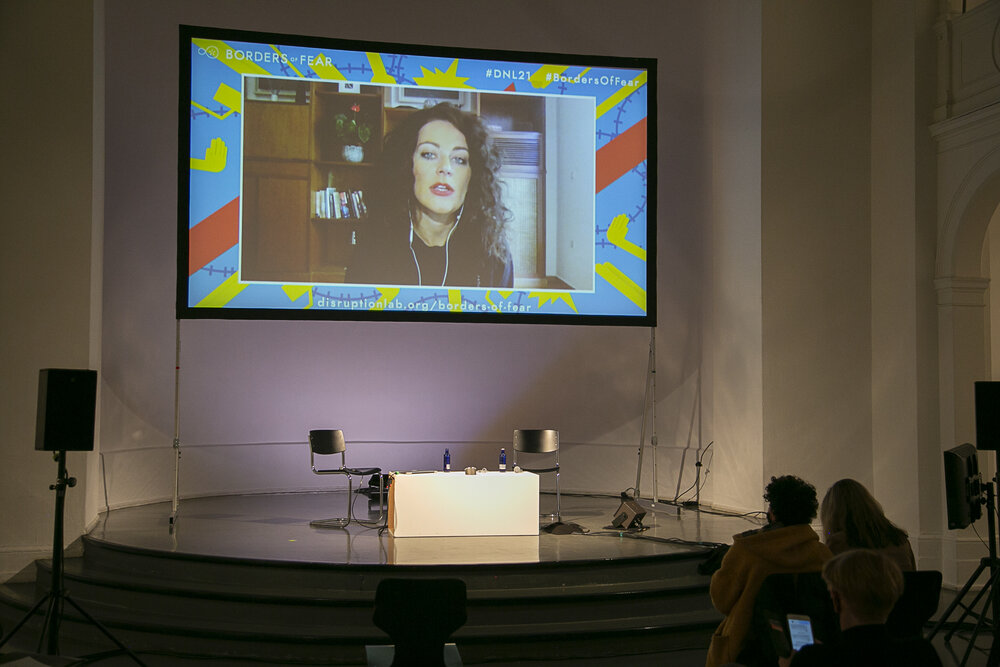
The following part of the conference focused on the journey through Sub-Saharan and Northern Africa, on the difficulties and the risks that migrants face whilst trying to reach Europe. In the conversation “The Journey of Refugees from Africa to Europe,” Yoseph Zemichael Afeworki, Eritrean student based in Luxemburg, talked of his experience with Ambre Schulz, Project Manager at Passerell, and reporter Sally Hayden. Afeworki recalled his dramatic journey and explained what happens to those like him, who cross militarized borders and the desert. The student described that migrants represent a very lucrative business, not just because they pay to cross the desert and the sea, but also because they are used as cheap labour, when not directly captured for ransom.
Once on the Libyan coast, people willing to reach Europe find themselves trapped in a cycle of waiting, attempts to cross the Mediterranean, pullbacks and consequent detention. Libya is a country at war, with two governments. The lack of official records and the instability make it difficult to establish the number of people on the move and refugees detained without trial for an indefinite period. Libyan law punishes illegal migration to and from its territory with prison; this without any account for individual’s potential protection needs. Once imprisoned in a Libyan detention centre for undocumented migrants, even common diseases can lead fast to death. Detainees are employed as forced labour for rich families, tortured, and sexually exploited. Tapes recording inhuman violence are sent to the families of the victims, who are asked to pay a ransom.
As Hayden and Afeworki described, the conditions in the buildings where migrants are held are atrocious. In some, hundreds of people live in darkness, unable to move or eat properly for several months. It is impossible to estimate how many individuals do not survive and die there. An estimated 3,000 people are currently detained there. The only hope for them is their immediate evacuation and the guarantee of humanitarian corridors from Libya –whose authorities are responsible for illegal and arbitrary detention, torture and other crimes– to Europe.
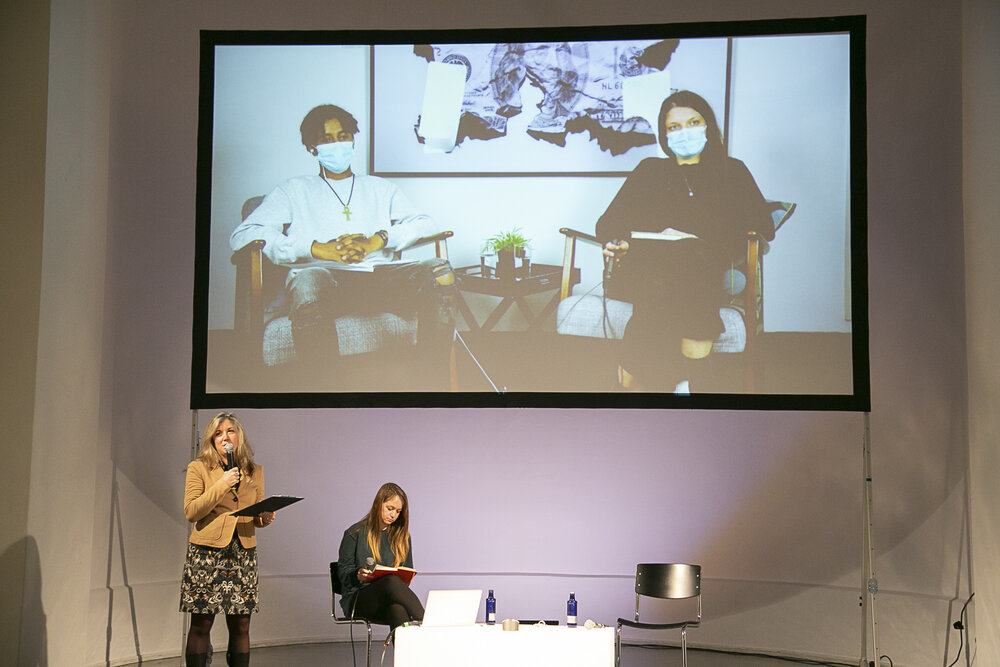
The second day closed with the panel “Politics & Technologies of Fear” moderated by Walid El-Houri, researcher, journalist and filmmaker. Gaia Giuliani from the University of Coimbra, Claudia Aradau, professor of International Politics at King’s College in London, and Joana Varon founder at Coding Rights, Tech and Human Rights Fellow at Harvard Carr Center.
Gaia Giuliani is a scholar, an anti-racist, and a feminist, whose intersectional work articulates the deconstruction of public discourses on the iconographies of whiteness and race, questioning in particular the white narrative imaginary behind security and borders militarization. In her last editorial effort, “Monsters, Catastrophes and the Anthropocene: A Postcolonial Critique” (2020), Giuliani investigated Western visual culture and imaginaries, deconstructing the concept of “risk” and “otherness” within the hegemonic mediascape.
Giuliani began her analyses focusing on the Mediterranean as a border turned into a biopolitical dispositive that defines people’s mobility –and particularly people’s mobility towards Europe– as a risky activity, a definition that draws from the panoply of images of gendered monstrosity that are proper of the European racist imaginary, to reinforce the European and Western “we”. A form of othering, the “we” produces fears through mediatized chronicles of monstrosity and catastrophe.
Giuliani sees the distorted narrative of racialized and gendered bodies on the move to Europe as essential to reinforce the identification of nowadays migrations with the image of a catastrophic horde of monsters, which is coming to depredate the wealthy and peaceful North. It´s a mechanism of “othering” through the use of language and images, which dehumanizes migrants and refugees in a process of mystification and monstrification, to sustain the picture of Europe as an innocent community at siege. Countries of origins are described as the place of barbarians, still now in post-colonial times, and people on the move are portrayed as having the ability to enact chaos in Europe, as if Europe were an imaginary self-reflexive space of whiteness, as it was conceived in colonial time: the bastion of rightfulness and progress.
As Giuliani explained, in this imaginary threat, migrants and refugees are represented as an ultimate threat of monsters and apocalypse, meant to undermine the identity of a whole continent. Millions of lives from the South become an indistinct mass of people. Figures of race that have been sedimented across centuries, stemming from colonial cultural archives, motivate the need to preserve a position of superiority and defend political, social, economic, and cultural privileges of the white bodies, whilst inflicting ferocity on all others.
This mediatized narrative of monsters and apocalypse generates white anxiety, because that mass of racialized people is reclaiming the right to escape, to search for a better life and make autonomous choices to flee the objective causes of unhappiness, suffering, and despair; because that mass of individuals strives to become part of the “we”. All mainstream media consider illegitimate their right to escape and the free initiative people take to cross borders, not just material ones but also the semiotic border that segregate them in the dimension of “the barbarians.” An unacceptable unchained and autonomous initiative that erases the barrier between the colonial then and the postcolonial now, unveiling the coloniality of our present, which represents migration flows as a crisis, although the only crisis undergoing is that of Europe.
On the other side, this same narrative often reduces people on the move and refugees to vulnerable, fragile individuals living in misery, preparing the terrain for their further exploitation as labour force, and to reproduce once again racialized power relations. Here the process of “othering” revivals the colonial picture of the poor dead child, functional to engender an idea of pity, which has nothing to do with the individual dignity. Either you exist as a poor individual in the misery –which the white society mercifully rescues– or as a part of the mass of criminals and rapists. However, these distinct visual representations belong to the same distorted narration, as epitomized in the cartoons published by Charlie Hebdo after the sexual assaults against women in Cologne on New Year’s Eve 2015.
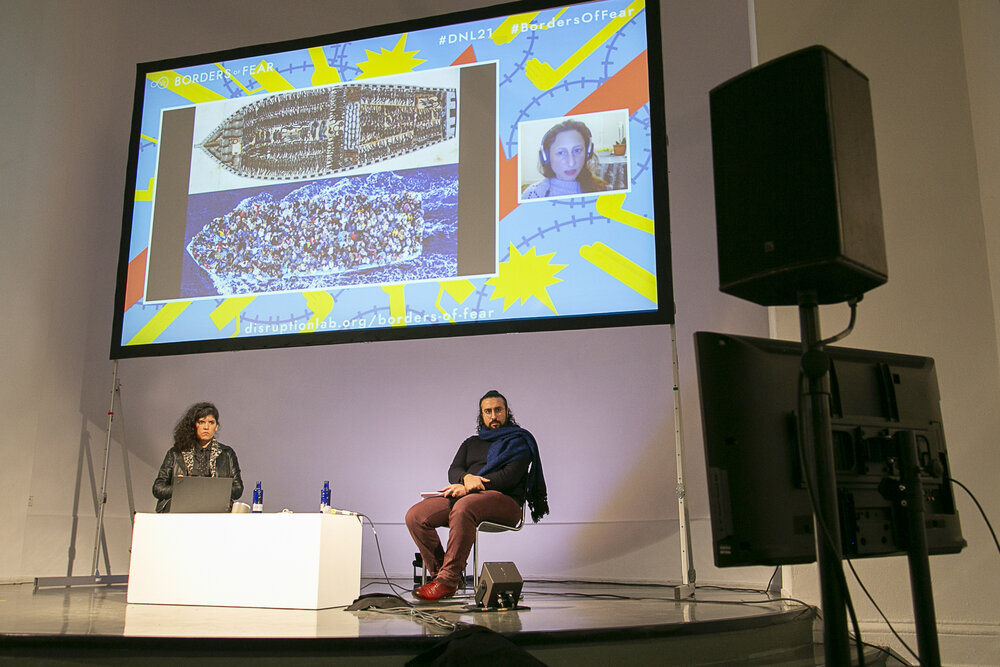
Borders have been rendered as testing ground right for high-risk experimental technologies, while refugees themselves have become testing subjects for these experiments. Governments and non-state actors are developing and deploying emerging digital technologies in ways that are uniquely experimental, dangerous and discriminatory in the border and immigration enforcement context. Taking step from the history of scientific experiments on racialized and gendered bodies, Claudia Aradau invited the audience to reconsider the metaphorical language of experiments that orients us to picture high-tech and high-risk technological developments. She includes instead also tech in terms of obsolete tools deployed to penalise individuals and recreate the asymmetries of the digital divide mirroring the injustice of the neoliberal system.
Aradau studies technologies and the power asymmetries in their deployment and development. She explained that borders have been used as very profitable laboratories for the surveillance industry and for techniques that would then be deployed widely in the Global North. From borders and prison systems –in which they initially appeared– these technologies are indeed becoming common in urban spaces modelled around the traps of the surveillance capitalism. The fact that they slowly enter our vocabularies and daily lives makes it difficult to define the impact they have. When we consider for example that inmates’ and migrants’ DNA is collected by a government, we soon realise that we are entering a more complex level of surveillance around our bodies, showing tangibly how privacy is a collective matter, as a DNA sequence can be used to track a multitude of individuals from the same genealogic group.
Whilst we see hyper-advanced tech on one side, on the other people on the move walk with nothing to cross a border, sometimes not even shoes, with their personal belongings inside plastic bags, and just a smartphone to orientate themselves, and communicate and ask for help. An asymmetry, which is –once again– being deployed to maintain what Aradau defined as matrix of domination: no surveillance on CO2 emissions and environmental issues due to industrial activities, no surveillance on exploitations of resources and human lives; no surveillance on the production of weapons, but massive deployment of hi-tech to target people on the move, crossing borders to reach and enter a fortress, which is not meant for them.
Aradau recalled that in theory, protocols ethics and demands for objectivity are necessary when it comes to scientific experiments. However, the introduction in official procedures of digital tech devices and software such as Skype, WhatsApp or MasterCard or a set of apps developed by either non-state or state actors, required neither laboratories nor the randomized custom trials that we usually associate with scientific experimentation. These heterogeneous techniques specifically intended to work everywhere and enforced without protocols, need to be understood under neoliberalism: they rely on pilot projects trials and cycles of funds and donors, whose goal is every time to move to a next step, to finance more experiments. Human-rights-centred tech is far away.
Thus, we see always more experiments carried out without protocols, from floating walls tech to stop migrants reaching the Greek shores, to debit cards used as surveillance devices. Creative experiments come also with the so-called refugees’ integration, conceived by small-scale injections of devices into their reality for limited periods, with the purpose of speculatively recompose rotten asymmetries of power and injustice. In Greece, as Aradau mentioned, the introduction of Skype in the process of the asylum application became an obstacle, with applicants continually experiencing debilitation through obsolete technology that doesn’t work or devices with limited access, disorientation through contradictory and outdated information.
There is also a factual aspect: old and slow computers, documents that have not been updated or have been updated at different times, and lack of personnel are justified by saying that resources are limited. A complete lack or shortage of funds, which is one other typical condition of neoliberalism, as we can see in Greece. In this, tech recomposes relations of precarity in a different guise.
Aradau concluded her contribution focusing on the technologies that are deployed by NGOs, completely or partially produced elsewhere, often by corporate actors who remain entangled in the experiments through their expertise and ownership. Digital platforms such as Facebook, Microsoft, Amazon, or Google not only shape relations between online users, she warned, but concerning people on the move and refugees too. Google and Facebook –for example– dominate the relations that underpin the production of refugee apps by humanitarian actors.
Google is at the centre of a sort of digital humanitarian ecosystem, not only because it can host searches or provide maps for the apps, but also because it simultaneously intercepts data flows so that it acts as a surplus data extractor. In addition, social networks reshape digital humanitarianism through data extractive relations and provide big part of the infrastructure for digital humanitarianism. Online humanitarianism becomes thus a particularly vulnerable site of data gathering and characterised by an overall lack of resources –similarly to the Greek state. As a result, humanitarian actors cannot tackle the depreciation messiness and obsolescence of their tech and apps.
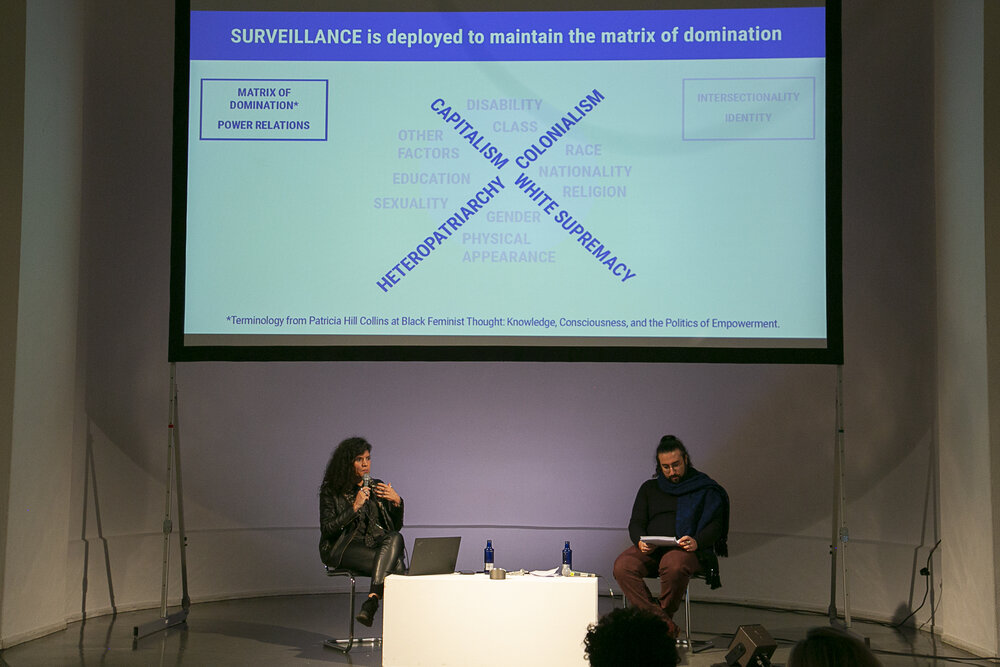
The last day of the conference concentrated on the urgent need to creating safe passages for migration, and pictured the efforts of those who try to ensure safer migration options and rescue migrants in distress during their journey. Lieke Ploeger, community director of the Disruption Network Lab, presented the panel discussion “Creating Safe Passages”, moderated by Michael Ruf, writer and director of documentary and theatre plays. Ruf´s productions include the “Asylum Dialogues” (2011) and the “Mediterranean Migration Monologues” (2019), which have been performed in numerous countries more than 800 times by a network of several hundred actors and musicians. This final session brought together speakers from the Migrant Media Network (MMN), the Migrant Offshore Aid Station (MOAS), and SeaWatch e.V. to discuss their efforts to ensure safer migration options, as well as share reliable information and create awareness around migration issues.
The talk was opened by Thomas Kalunge, Project Director of the Migrant Media Network, one of r0g_agency’s projects, together with #defyhatenow. Since 2017 the organisation has been working on information campaigns addressed to people in rural areas of Africa, to explain that there are possible alternatives for safer and informed decisions, when they choose to reach other countries, and what they may come across if they decide to migrate.
The MMN team organises roundtable discussions and talks on various topics affecting the communities they meet. They build a space in which young people take time to understand what migration is nowadays and to listen to those, who already personally experienced the worst and often less discussed consequences of the journey. To approach possible migrants the MMN worked on an information campaign on the ethical use of social media, which also helps people to learn how to evaluate and consume information shared online and recognise reliable sources.
The MMN works for open culture and critical social transformation, and provides young Africans with reliable information and training on migration issues, included digital rights. The organisation also promotes youth entrepreneurship “at home” as a way to build economic and social resilience, encouraging youth to create their own opportunities and work within their communities of origin. They engage on conversations on the dangers of irregular migration, discussing together rumours and lies, so that individuals can make informed choices. One very relevant thing people tend to underestimate, is that sometimes misinformation is spread directly by human smugglers, warned Kalunge.
The MMN also provides people from remote regions with offline tools that are available without an internet connection, and training advisors and facilitators who are then connected in a network. The HyracBox for example is a mobile, portable, RaspberryPi powered offline mini-server for these facilitators to use in remote or offline environments, where access to both power and Internet is challenging. With it, multiple users can access key MMN info materials.
An important aspect to mention is that the MMN does not try to tell people not to migrate. European government have outsourced borders and migration management, supporting measures to limit people mobility in North and Sub-Saharan Africa, and it is important to let people know that there are real dangers, visible and invisible barriers they will meet on their way.
Visa application processes –even for legitimate reasons of travel– are very strict for some countries, often without any information being shared, even with people who are legitimately moving for education, to work or get medical treatment. The ruling class that makes up the administrative bureaucracy and outlines its structures, knows that who controls time has power. Who can steal time from others, who can oblige others to waste time on legal quibbles and protocol matters, can suffocate the others’ existence in a mountain of paperwork.
Human smugglers then become the final resort. Kaluge explained also that, at the moment, the increased outsourcing of the European border security services to the Sahel and other northern Africa countries is leading to diversion of routes, increased dangerousness of the road, people trafficking, and human rights violations.
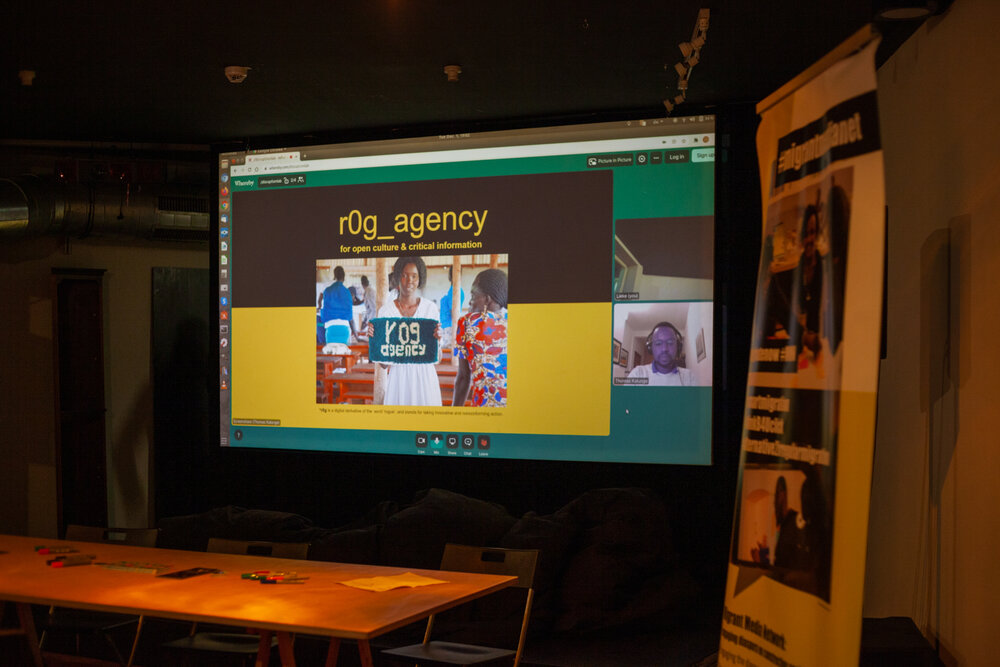
Closing the conference, Regina Catrambone presented the work that MOAS does around the world and the campaign for safe and legal routes that is urging governments and international organisations to implement regular pathways of migration that already exist. Mattea Weihe presented instead the work of SeaWatch e. V., an organisation which is also advocating for civil sea rescue, legal escape routes and a safe passage, and which is at sea to rescue migrants in distress.
The two panellists described the situation in the Central Mediterranean. Since the beginning of the year, over 500 migrants have drowned in the Mediterranean Sea (November 2020). While European countries continue to delegate their migration policy to the Libyan Coast Guard, rescue vessels from several civilian organisations have been blocked for weeks, witnessing the continuous massacre taking place just a few miles from European shores. With no common European rescue intervention at sea, the presence of NGO vessels is essential to save humans and rescue hundreds of people who undertake this dangerous journey to flee from war and poverty.
However, several EU governments and conservative and far right political parties criminalise search and rescues activities, stating that helping migrants at sea equals encouraging illegal immigration. A distorted representation legitimised, fuelled and weaponised in politics and across European society that has led to a terrible humanitarian crisis on Europe’s shores. Thus, organisations dedicated to rescuing vessels used by people on the move in the Mediterranean Sea see all safe havens systematically shut off to them. Despite having hundreds of rescued individuals on board, rescue ships wait days and weeks to be assigned a harbour. Uncertainty and fear of being taken back to Libya torment many of the people on board even after having been rescued. After they enter the port, the vessels are confiscated and cannot get back out to sea.
By doing so, Europe and EU Member States violate human rights, maritime laws, and their national democratic constitutions. The panel opened again the crucial question of humanitarian corridors, human-rights-based policy, and relocations. In the last years the transfer of border controls to foreign countries, has become the main instrument through which the EU seeks to stop migratory flows to Europe. This externalisation deploys modern tech, money and training of police authorities in third countries moving the EU-border far beyond the Union’ shores. This despite the abuses, suffering and human-rights violations; willingly ignoring that the majority of the 35 countries that the EU prioritises for border externalisation efforts are authoritarian, known for human rights abuses and with poor human development indicators (Expanding Fortress, 2018).
It cannot be the task of private organizations and volunteers to make up for the delay of the state. But without them no one would do it.
States are seeking to leave people on the move, refugees, and undocumented migrants beyond the duties and responsibilities enshrined in law. Most of the violations, and the harmful technological experimentation described throughout the conference targeting migrants and refugees, occurs outside of their sovereign responsibility. Considering that much of technological development occurs in fact in the so-called “black boxes,” by acting so these state-actors exclude the public from fully understanding how the technology operates.
The fact that the people on the move on the Greek islands, on the Balkan Route, in Libya, and those rescued in the Mediterranean have been sorely tested by their journeys, living conditions, and, in many cases, imprisoned, seems to be irrelevant. The EU deploys politics that make people who have already suffered violence, abuse, and incredibly long journeys in search of a better life, wait a long time for a safe port, for a visa, for a medical treatment.
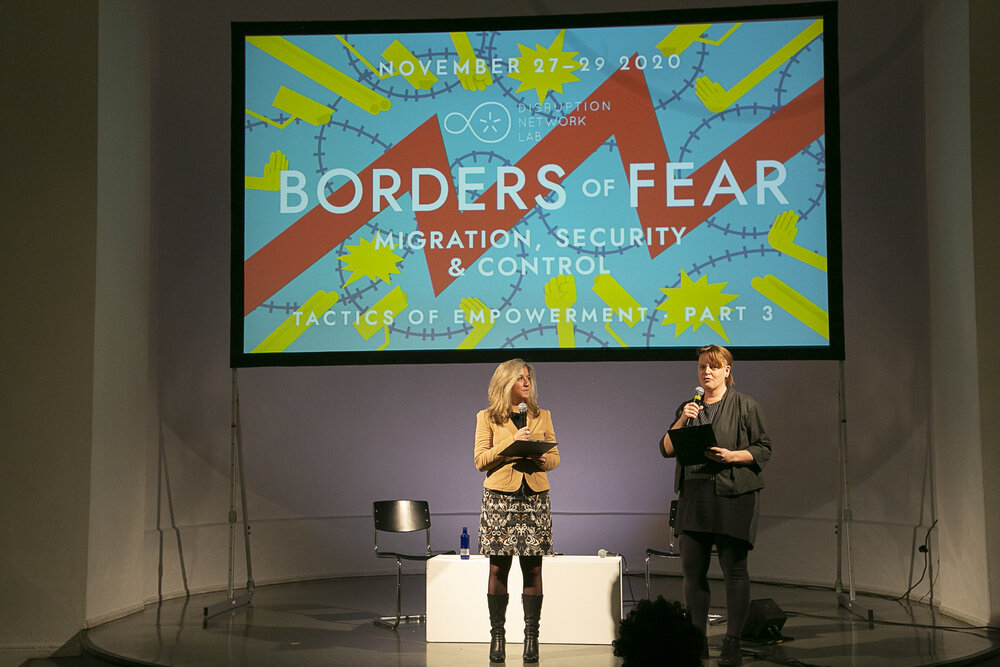
All participants who joined the conference expressed the urgent need for action: Europe cannot continue to turn its gaze away from a humanitarian emergency that never ends and that needs formalised rescue operations at sea, open corridors, and designated authorities enacting an approach based on defending human rights. Sea rescue organisations and civil society collectives work to save lives, raise awareness and demand a new human rights-based migration and refugee policy; they shall not be impeded but supported.
The conference “Borders of Fear” presented experts, investigative journalists, scholars, and activists, who met to discuss wrongdoings in the context of migration and share effective strategies and community-based approaches to increase awareness on the issues related to the human-rights violations by governments. Here bottom-up approaches and methods that include local communities in the development of solutions appear to be fundamental. Projects that capacitate migrants, collectives, and groups marginalized by asymmetries of power to share knowledge, develop and exploit tools to combat systematic inequalities, injustices, and exploitation are to be enhanced. It is imperative to defeat the distorted narrative, which criminalises people on the move, international solidarity and sea rescue operations.
Racism, bigotry and panic are reflected in media coverage of undocumented migrants and refugees all over the world, and play an important role in the success of contemporary far-right parties in a number of countries. Therefore, it is necessary to enhance effective and alternative counter-narratives based on facts. For example, the “Africa Migration Report” (2020) shows that 94 per cent of African migration takes a regular form and that just 6 per cent of Africans on the move opt for unsafe and dangerous journeys. These people, like those from other troubled regions, leave their homes in search of a safer, better life in a different country, flee from armed conflicts and poverty. It is their right to do so. Instead of criminalising migration, it is necessary to search for the real causes of this suffering, war and social injustice, and wipe out the systems of power behind them.
Videos of the conference are also available on YouTube via:
For details of speakers and topics, please visit the event page here: https://www.disruptionlab.org/borders-of-fear
Upcoming programme:
The 23rd conference of the Disruption Network Lab curated by Tatiana Bazzichelli is titled “Behind the Mask: Whistleblowing During the Pandemic.“ It will take place on March 18-20, 2021. More info: https://www.disruptionlab.org/behind-the-mask
To follow the Disruption Network Lab sign up for the newsletter and get informed about its conferences, meetups, ongoing researches and projects.
The Disruption Network Lab is also on Twitter, Facebook and Instagram.
On May 29, 2020, the Disruption Network Lab opened its 19th conference, “Evicted by Greed: Global Finance, Housing & Resistance”. The three-day-event was supposed to take place in Berlin in March, on the days of the global call for the Housing Action Days. Instead, it took place online due to ongoing safety concerns relating to the coronavirus pandemic.
Chaired by Tatiana Bazzichelli and Lieke Ploeger, programme and community director of the Disruption Network Lab, the interactive digital event brought together speakers and audience members from their homes from all over the world to investigate how speculative finance drives global and local housing crises. The topic of how aggressive speculative real-estate purchases by shell companies, anonymous entities, and corporations negatively impacts peoples’ lives formed the core conversation for the presentations, panel discussions, and interactive question and answer sessions. The conference served as a platform for sharing experiences and finding counter-strategies.
In her introductory statement, Bazzichelli took stock of the situation. As the pandemic appeared, it became clear worldwide that the “stay-at-home” order and campaigns were not considering people who cannot comply since they haven’t got any place to stay. Tenants, whose work and lives have been impacted, struggle to pay rent, bills, or other essentials, and in many cases had to leave their homes or have been threatened with forced eviction. People called on lawmakers at a national and local level to freeze rent requirements as part of their response to the pandemic, but very few measures have been put in place to protect them. However, scarce and unaffordable housing is neither a new, nor a local problem found in just a few places.
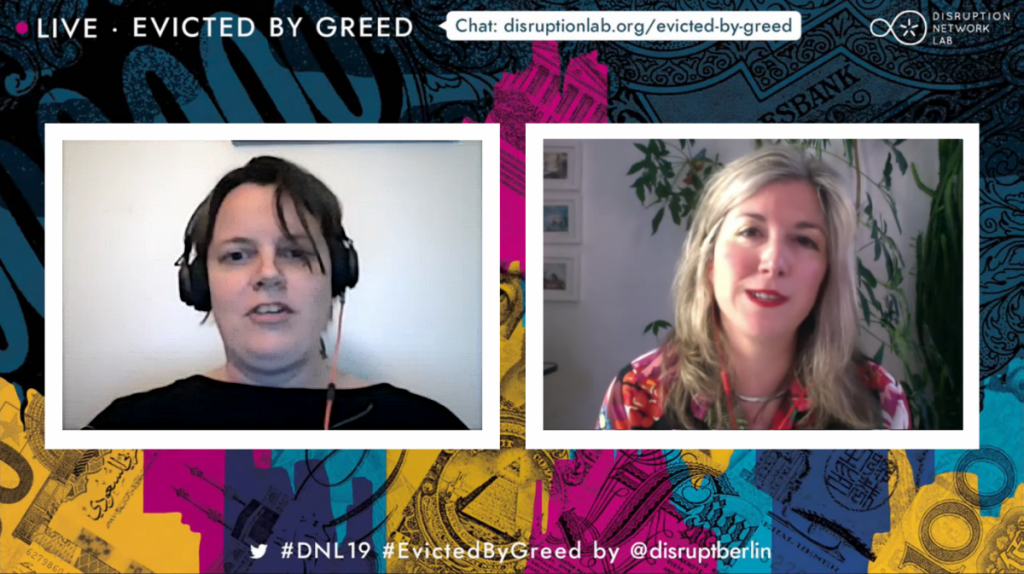
Christoph Trautvetter, public policy expert and German activist of
Netzwerk Steuergerechtigkeit (Network for Tax Justice) and Wem gehört
die Stadt (Who Owns the City) of the Rosa-Luxemburg Foundation, and Manuel Gabarre de Sus, Spanish lawyer and activist from the Observatory Against Economical Crime, delivered the opening keynote “Anonymous & Aggressive Investors: Who owns Berlin & Barcelona?” moderated by Eka Rostomashvili, advocacy and campaigns coordinator at Transparency International.
In the last decade waves of private equity real estate investments have reshaped the rental housing markets in cities like Berlin and Barcelona. Housing and real estate have been deformed by global capital markets and financial excess, treated as a commodity, a vehicle for predatory investment and wealth rather than a social good reflecting a human right. This led to evictions, discriminations in the housing sphere, and lack of access to basic housing-related services, all put in place by aggressive real estate investors.
Trautvetter is co-author of a recent study tracing the ownership of 400 companies owning real estate in Berlin. He explained that in the city, where about 85% of the population are renters, exploding house prices and rentals have been guaranteeing investors returns far beyond 10% per year after the financial crises of 2009. Here the emergence of corporate landlords changed the city. They are entities that own and operate rental housing on a massive scale, replacing the traditional “gentle old lady” landlord. At 17.5%, Berlin has a law proportion of direct investors renting out their properties.
Activists, politicians, and organisations of tenants are trying to fight unlawful evictions and speculative investments reshaping the German capital, but often face anonymity. Almost half of the city is in the hands of listed companies, professional investors, or indirect investors shielded by property management firms and lawyers that operate on their behalf. International private equity companies are one of the most obscure and greedy embodiments of policy failure in this context.
Gabarre de Sus focused on the problem of the opportunistic investment funds that appeared in Spain due to strong deregulation. After the global financial crisis of 2009, the rescue of the Spanish financial system ensured that hundreds of thousands of households were indirectly under public control. But the European Union and the Spanish Government decided in 2012 to sell these properties to opportunistic investors. Many say that if public ownership of these real estates had been maintained for social renting, the rent bubble of recent years would not have occurred. As a result, many vulture funds, particularly from the United States like Blackstone, Hayfin, TPG, and millionaires like the Mexican Carlos Slim, made huge profits. Since then, rent prizes have increased of more than the 50% in the main Spanish cities, more than 30 times faster than wages.
Whilst describing this process, Gabarre de Sus focused on the political and legal ties of big investment funds that invest in real estate. There are structures of political and economic interest that allow companies like Blackstone Group Inc. — one of the largest real estate private equity and investment management firms in the world declaring $140 billion of real estate assets under management, 25% of its total assets — to scale business models in which properties are bought, renovated, and then put back on the market at rents that tenants cannot afford. These actors are influential, with economic partners at international level, including banks from the world’s largest economies.
In many cases, real estate registers do not contain any information on beneficial owners or there is no way to link legal and beneficial owners, so that both authorities and citizens know very little about who owns their cities. EU legislation obliges information on real estate holders to be available to authorities and specifies that the general public shall receive access to beneficial ownership information of EU based companies. The problem is that such registers are usually maintained under self-disclosure principles based on data internally identified by the reporting entity. Access to data is often difficult and expensive. Once you get the information, it can take time to check it and find out contradictory data. Moreover, an articulated system of international shell companies, secrecy legislation, and strategic financial loopholes provides immunity and contributes to global inequality, consolidating the incessant shift of wealth from the poor to the rich.

In Berlin nearly half of the real estate investors remain anonymous and there is no certainty of how much dirty money hides behind their investments, which is something common to many places around the world. The current situation — revealed also by the Panama Papers investigation — shows that governments profit from illegal wealth from transnational money-laundering, hosting international criminal enterprises within their territories and capital cities, thus providing a grey area for illegal practices where false or inappropriate identification represents the other face of fraudulent records and corruption.
The panel “Foggy Properties & Golden Sands: Money Laundering in London & Dubai” moderated by Rima Sghaier, outreach and research fellow at the Hermes Centre for Transparency and Digital Human Rights, made clear how easy and common it is for global elites and organised criminality to open offshore companies, move assets, and buy real estate in big capital cities, with investments that integrate illegal funds into the financial system and legitimate economy.
Sam Leon, data investigations lead at Global Witness, referred to the relations between satellite fiscal havens such as the Virgin Islands, the Cayman, and the Channel Islands, and the City of London. These countries are linked through commercial and legal ties with high probabilities for dark money to flow through the UK’s Overseas territories and Crown Dependencies undetected.
The UK has a public land registry, but it is difficult to effectively scrutiny data. Companies are obliged to file good quality information, but many do not and authorities are not able to check it accurately. Britain is defined by detractors as the world’s greatest enabler of corporate tax avoidance. Considering real estate, Leon explained that tens of thousands of tenants in England and Wales are in the hands of unscrupulous owners, who hide behind anonymous companies and trusts.
One loophole real estate investors use is acquiring shares in a company that owns real estate, rather than the real estate itself; the property can be then sold by selling the shares in the company with no UK corporate tax. If the company is registered in a country that guarantees secrecy and free hands, no name appears. According Global Witness in England and Wales 87,000 properties with an estimated value of more than 1 billion pounds are owned by companies incorporated in secrecy jurisdictions, which keep secret the information about the real owners. Scotland suffers from the same problem, and in this context Scottish Limited Partnerships are a major concern too.
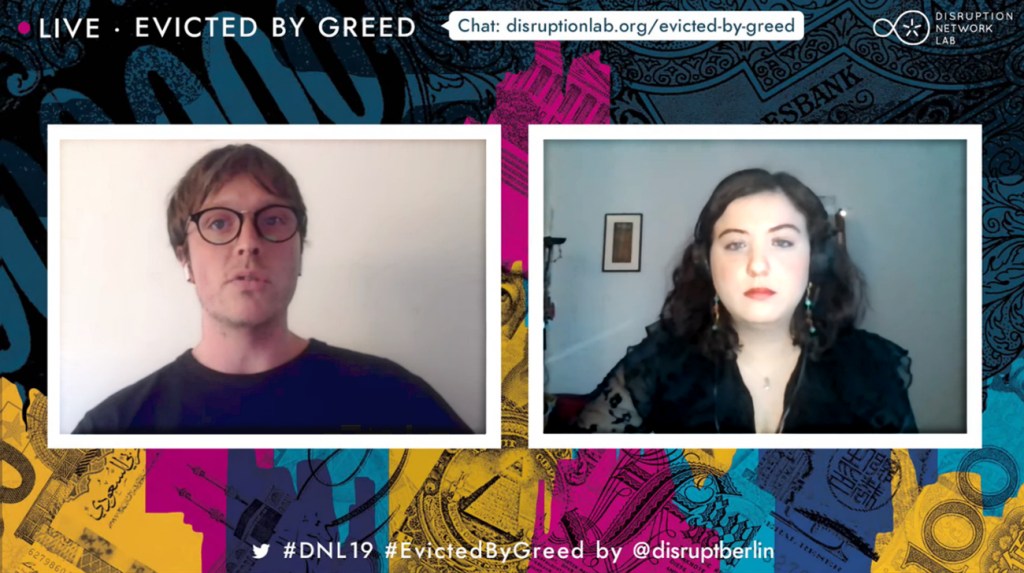
Companies avoid inheritance tax and capital gain tax, riding fiscal loopholes. The use of firms based in countries which are known tax havens to purchase property is being observed all around the world, with concerns about how much property is owned by unaccountable offshore entities.
The analyses of Leon introduced topics covered by the second panellist Karina Shedrofsky, who presented her work as head of OCCRP’s research team “Dubai’s Golden Sands.” Recently leaked datasets of property and residency details were obtained by the non-profit group C4ADS, and provided to the international investigative journalists of the OCCRP as part of the Global Anticorruption Consortium, in collaboration with Transparency International.
International criticism of governments and independent organisations pointed out that Dubai has become an open market for money laundering and a safe haven for the corrupt at a global level, due to the lack of controls along with very profitable conditions. The United Arab Emirates are accused of weakly regulating the financial sector, guaranteeing secrecy, and offering the world’s criminals a range of services. The country’s land registry is not open to the public and a lack of enforcement and oversight in the property sector is ideal to stash vast amounts of dirty money.
Shedrofsky pointed out that Dubai is an absolute monarchy ruled as a business. Several transnational investigations show that its laws seem to be a facilitator for international money laundering, corruption, and other financial crimes.
The emirate has been attracting secretive real estate purchases by foreign companies and individuals for years. Construction and real estate sector represents 20% of the country’s gross domestic product (2016). In the country it is possible to move money with very little regulatory scrutiny, cash-based transactions are incentivised, and the volume of gold trafficked accounts for around 25% of global trade, with almost no questions about its origins. Wealthy investors are offered a property investment visa by an investment in real estate of minimum $272,000 dollars, and get the benefits of light financial regulation, anonymity, and banking secrecy.
Shedrofsky explained how researchers from 8 countries worked on thousands of spreadsheets maintained by real estate professionals, in an accurate cross-border investigation that led to the publication of a hundred names of wealthy people, who have invested millions in Dubai. The non-official records from the years 2014-2016 provided more than 129,000 owner’s data, which the team organised per country and verified, revealing only information that could be proven beyond doubt. A website hosting an interactive map with the detected properties is online, and anyone can check it (occrp.org/en/goldensands/).
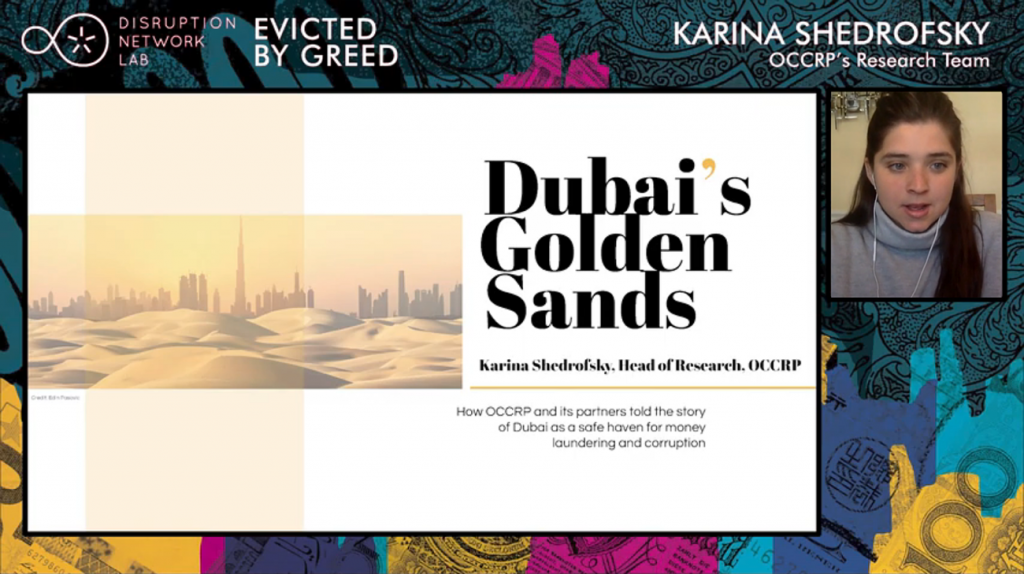
The first day of the conference closed with filmmaker and journalist Fredrik Gertten and Leilani Farha, former UN Special Rapporteur on the right to housing, in a live conversation moderated by Tatiana Bazzichelli. Gertten’s latest documentary investigates the factors that push people out from their own city, turning it into an unaffordable place that is more and more difficult to live in due to the extreme difference between housing prices and wage development.
From New York to Barcelona “Push: The Film” narrates how corporations and financial elites are speculating on people’s lives. Renters worldwide are drowning in a sea of self-doubt, with feelings of inadequacy and fears, because they think they are unable to keep up with life. But the documentary shows that this condition is the consequence of a system intended to harm, marginalise, and discriminate them. Even if residents should be able to afford to live in their own cities, this process inexorably condemns them to move away.
The work of the speakers on the first day of the conference reinforced the idea that crowd-based and data-driven research projects, together with independent and cross-border investigations, can allow a glimpse behind the curtain of the real estate market. Anonymity and secrecy in juxtaposition to openness and transparency, obtained through collective mobilisation, collecting, sharing, and analysing data.
A depressingly similar pattern emerges in countries all over the world. Housing has been financialised and turned into an investment vehicle, which has caused an oversupply of luxury estates and empty buildings in many cities, and a chronic shortage of adequate housing for the least advantaged, for the working class, and often for the middle class too. A process often encouraged by governments.
In this context, “financialisation” refers to tendencies within the economic system characterised by the expansion and proliferation of financial markets penetrating into a range of both economic and social sectors, and consequently affecting human rights related goods — such as housing, pensions and healthcare — making huge profits out of basic needs and human sufferings.
With regard to the financialisation of housing, not just banks, corporations, and big investment funds play this ruthless game. Fraudsters, money launderers, and organised crime are very active internationally, and look for weak financial systems and a moment of crisis to speculate on the property market.

Ela Kagel, digital strategist and founder of Supermarkt Berlin, discussed collective solutions to tackle housing, social, and economic injustices with the sociologist Volkan Sayman, promoter of the campaign “Expropriate Deutsche Wohnen & Co!”. This movement is an example of how residents can involve themselves to determine and achieve their own objectives, acting on their rights to create a space for their perspectives and needs within an urban context.
After a majority of citizens were found to be in favour of the initiative in early 2019, a city-wide referendum could be now called on the expropriation of private housing companies with more than 3,000 housing units. Local political parties have not managed to find agreement yet and, as a result, the effects of the referendum in Berlin are likely to be minor if people do not keep on supporting it. The expropriation would put 240,000 flats under public control.
As outlined, investors from the international capital market made huge purchases in Berlin’s residential and commercial real estate: the company Deutsche Wohnen alone owns 111,500 apartments in the city. Together with Vonovia, BlackRock, Akelius, Blackstone, Carlyle, Optimum Evolution, and others, these companies own almost one fourth of the city. In the early 2000s Berlin’s government sold many public housing units and areas to these companies, instead of offering them to residents as development project to focus on local communities and their needs. The Expropriate Deutsche Wohnen & Co! community has forced large real estate companies and politicians from all parties to address the issue and successfully raised awareness among Berliners who engaged in it.
In Berlin exasperated renters successfully came together and organised themselves in several ways. They are also appealing to the local council to stop the sale of their homes, and the “Rent Price Cap,” a new policy in force since 2020, has frozen rents on around 1.4 million homes in the German capital. The “Mietendeckel” is supposed to last for 5 years. Twelve constitutional complaints have already been filed against it.
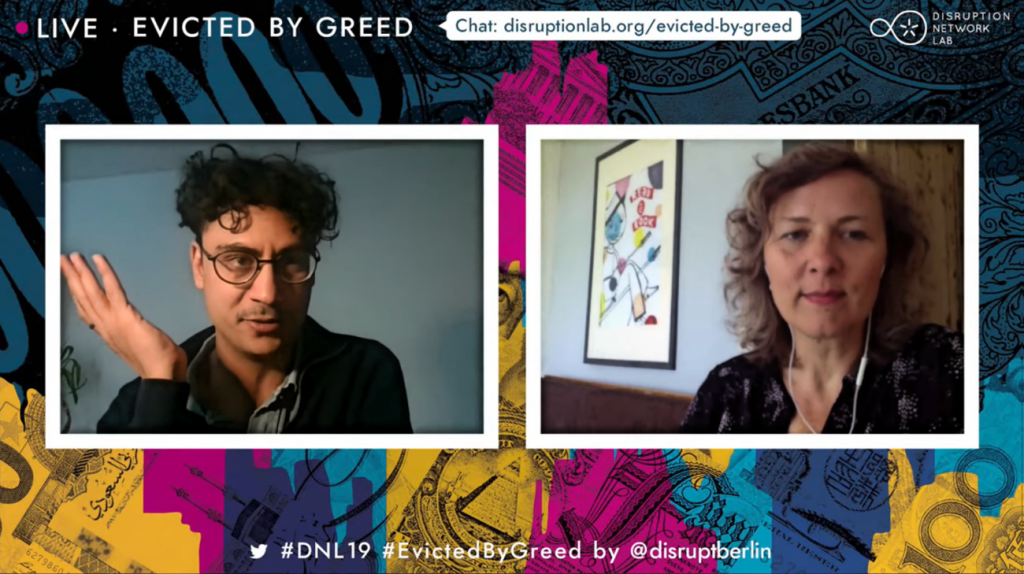
The keynote on the second day “The Human Rights Solution: Tackling the housing crisis” focused on the work of Leilani Farha, UN former Special Rapporteur on adequate housing, in conversation with Justus von Daniels, Editor-in-Chief of CORRECTIV, non-profit newsroom for investigative journalism. Opening the keynote Von Daniels presented the German crowdsourced project he runs — Who owns the city? — which is based on community-powered investigations collecting data to gain a better understanding of the German housing market.
Farha recalled that international human rights law recognizes everyone’s right to an adequate housing and living conditions. Global real estate today represents nearly 60% of the value of all global assets; with housing comprising nearly 75%. That´s more than twice the world’s total gross domestic product. The aspect to consider is that such a vast amount of wealth seems to have left governments accountable to real estate investors rather than to their international human rights obligations.
Farha criticised Blackstone Group Inc. and its subsidiaries for a practice she also confirms has become common throughout the industry in many countries around the world. These companies are targeting multi-family residences in neighbourhoods deemed to be “undervalued,” so a building or several buildings from an area of poor and low-income tenants. The former UN rapporteur described how Blackstone purchases a building, undertakes repairs or renovation, and then increases the rent driving existing tenants out, and replacing them with higher income ones.
As the speakers pointed out, there has been little attention given to the impact of financialisation on housing, which has caused displacement and evictions, changing urban areas forever. Until the massive financial deregulation of the 1980s, housing was built and paid for locally. Governments, local savings, and loan institutions were supposed to provide the bulk of financing for housing up. Due to an ideological shift, determined by the impact of the dominance on financial markets of big investment funds, banks and corporations, housing is increasingly intertwined with flows of global capital. Housing markets are now more responsive to these flows than to local conditions becoming a global industry.
With roots in the 2008 financial crisis, the recent massive wave of investments by international corporations, banks, and big investment funds completed the shift from housing as a place to build a home, to housing as an investment, with devastating consequences for millions of people. The current real-estate cycle started in 2009 and led to significant price increases for residential property in many cities all over the world. Among several factors, the proliferation of predatory equity funds sifting through the world searching for undervalued investment opportunities and finding them in housing.
The global goal is to guarantee everybody legal security and protection against unlawful forced evictions, harassment and other threats, to make sure that personal or household financial costs associated with housing do not threaten or compromise the attainment and satisfaction of other basic needs. We see instead that the needs of disadvantaged and marginalized groups are not taken into account at all. In urban areas public spaces and social facilities disappear together with the expression of cultural identities and ways of life of the original residents.

Statistics show that many of the less advantaged are renters, not owners. And rents have increased even faster than housing prices in many metropolitan areas. Some call for more expansion at the urban peripheries with sustainable and modern public housing projects and better infrastructures. Others call for empowering neighbourhoods and local communities to reverse the financialisation process and to improve the conditions of the areas, that are most affected by this process, building more housing for themselves, and distributing those empty ones.
The conclusive panel on the second day was moderated by Iva Čukić, cofounder of the urban development organisation Ministry of Space, set up to occupy abandoned and neglected urban spaces and fill them with projects, workplaces, housing, or alternative art galleries, to enhance everyone’s right to the city. The panel brought into dialogue different modalities of fighting property speculation, and sharing tactics of resistance in the political and media landscape, and presented concrete alternatives for the urban territory.
The first panelist to speak, Marco Clausen, is the co-founder of the Prinzessinnengarten in Berlin, an island of collective gardening in Moritzplatz. The garden represents an open space to share and develop new forms of urban life, where to practice ideas of social-ecological positive transformation, in the context of privatisation and financialisation of real estate in the city.
In the 2000s Berlin was still a city with vast empty areas, dismissed military facilities and many old empty buildings. In the last 20 years over 3,000 sites in Berlin owned by public housing societies have been privatised. The garden started as a temporary project in 2009 and has been struggling since 2012 against private investors and speculation. Back then activists mobilised 30,000 people to stop the selling process to an investor, and obtained a new contract until 2018. The area around the garden was first in the hands of a Goldmann Sachs fund, and later to Deutsche Wohnen. A small group fought for two years to keep the garden a collective project, managing to prolong the contract for another six years and receiving public funding to rebuild the garden as an open learning and cultural centre.
Always in Berlin, another group of activists has been mobilising to fight the Amazon tower, that is to be completed in 2023 in the area of Berlin-Friedrichshain. Yonatan Miller, tech-worker and activist from the coalition “Berlin vs. Amazon,” talked about the movement that opposes the big tech company’s project, that will reshape the area and impact many people’s lives. On one side, over the last five years Berlin has already seen the fastest increase in housing prices globally, on the other big tech corporations are known for getting into real-estate market and make things worse for local residents, gentrifying the area. Miler discussed the challenges of the activists, presenting their strategy for the struggle ahead to replicate the success story of New York’s ousting of Amazon in 2019.
The panel proceeded with the StealThisPoster collective and their online archive “stealthisposter.org” maintained by artists and activists part of a network formed around the right to housing movements of London and Rome. The group presented the practice of subvertising, the artistic hacking of corporate and political advertisements to make counter-statements by disrupting lucrative communication of induced desires and needs and parodying of them. Inside urban areas subvertising (portmanteau of subvert and advertise) is an act of reappropriation of those public spaces that have been turned into a vehicle for intrusive and harmful commercial communications.
StealThisPoster recently supported with various guerrilla actions a community fighting against the eviction of the “Lucha y Siesta,” a space of social housing and the first inhabited by an all-female squat in Rome. Their evocative pictures of Roman monuments lit at night by the words “on sale” became viral and helped the cause. However, the existence of this independent legendary social space is still at risk. Lucha Y Siesta was put on auction by the city council of Rome on April 7 this year. The short film premiere “StealThisPoster: Artivism & the Struggle of Lucha Y Siesta” that StealThisPoster created in occasion of Evicted By Greed, focuses on this experience and introduces the practice of subvertising.
A video contribute by Penny Travlou from the University of Edinburgh concluded the panel. Travlou talked about the housing crisis in Athens and the local activists of the AARG collective, Action Against Regeneration & Gentrification, born to fight against eviction, financial speculation, and to support the rights of the refugees.
Alongside the main conference sessions, a workshop on the third day enriched the programme.
The virtual tour “Visiting the Invisible” by Christoph Trautvetter discovers the anonymous and aggressive real estate investors of Berlin, drawing on the findings of the project “Wem gehört die Stadt” of the Rosa-Luxemburg Stiftung, and including further recent studies from other collectives.

The conference “Evicted by Greed” presented experts working on anti-corruption, investigative journalists, artists and activists, who met to share effective strategies and community-based approaches to increase awareness on the issues related to the financialisation of housing and its negative effects. Here bottom-up approaches and methods that include local communities in the development of solutions appear to be fundamental. Projects that capacitate collectives, minorities, and marginalized groups to develop and exploit tools to combat systematic inequalities, injustices, and speculation are to be enhanced.
Ghostly shell companies and real estate speculators evict real people from their homes. It is not possible to state that all of these companies are acting illegally, or indeed avoiding paying taxes by being based in tax havens, but it is proven that opaque offshore firms are routinely used by criminals for systemic tax evasion, to buy property as a means to launder or stash dirty money, as well as to dodge taxes.
Open registers and open debate about these issues are very important, and not just for possible judicial outcomes. It is important to find out who the owners of real estates are and give a name to the landlords. Sometimes they might not be speculation oriented individuals and might not be aware of the consequences of their investments, but have delegated ruthless intermediates, lawyers, and investment consultants. There could be hundreds of workers who invested in a pension found without knowing that their profit is based on aggressive speculation.
Equal and non-discriminatory access to public spaces and adequate housing is not possible without an appropriate and effective regulation. The researches, the projects and the investigations presented in this conference are all worthwhile experiences with proven benefits, but ultimately, they may not be enough to alter the structural forces in play. The pandemic has shown that speculators all over the world wait for moments of crisis to purchase new real estates for a lower price, taking advantage of the financial difficulties that many people are experiencing. A growing number of property investors are preparing for what they believe could be a once-in-a generation opportunity to buy distressed real-estate assets at bargain prices. The system facilitates the concentration of real states in the hands of big international landlords and governments remain inert.
The solution cannot be found in one simple formula, or by asking people to buy real estate and become direct investors and new owners, in a deregulated system based on speculation, where most of the individuals struggle to make a living. The global economic system is based on banks holding massive amounts of loans to companies based in tax havens, speculative real estate investments and a small economic elite that makes and escapes rules, defending financial deregulations and feeding social injustice.
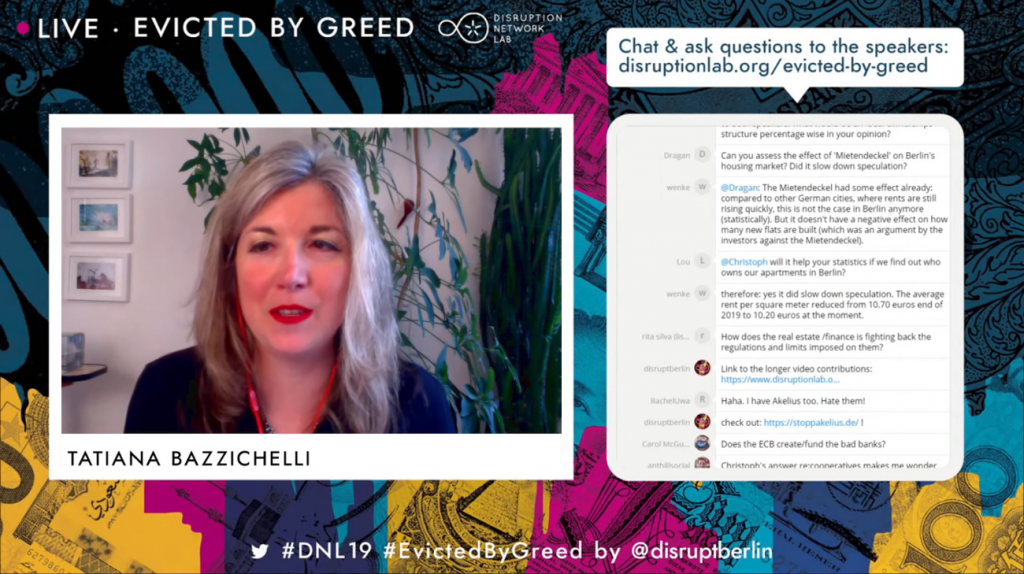
Videos of the conference are also available on YouTube.
In-depth video contributes by the speakers recorded before the conference are available here: https://www.disruptionlab.org/evicted-videos
For details of speakers and topics, please visit the event page here: https://www.disruptionlab.org/evicted-by-greed
The 20th conference of the Disruption Network Lab curated by Tatiana
Bazzichelli & Mauro Mondello is DATA CITIES: SMART TECHNOLOGIES,
TRACKING & HUMAN RIGHTS. It will take place on September 25-27 at Studio 1, Kunstquartier Bethanien, Mariannenplatz 2, 10997 Berlin. More info: https://www.disruptionlab.org/data-cities
To follow the Disruption Network Lab sign up for its Newsletter and get informed about its conferences, ongoing researches and projects.
The Disruption Network Lab is also on Twitter and Facebook.
For its closing community gathering of the year, the Disruption Network Lab organised a conference to extend and connect its 2019 programme ‘The Art of Exposing Injustice’ – with social and cultural initiatives, fostering direct participation and enhancing engagement around the topics discussed throughout the year. Transparency International Deutschland, Syrian Archive, and Radical Networks are some of the organisations and communities that have taken part on DNL activities and were directly involved in this conference on November the 30th, entitled ‘Activation: Collective Strategies to Expose Injustice’ on anti-corruption, algorithmic discrimination, systems of power, and injustice – a culmination of the meet-up programme that ran parallel to the three conferences of 2019.
The day opened with the talk ‘Untangling Complexity: Working on Anti-Corruption from the International to the Local Level,’ a conversation with Max Heywood, global outreach and advocacy coordinator for Transparency International, and Stephan Ohme, lawyer and financial expert from Transparency International Deutschland.

In the conference ‘Dark Havens: Confronting Hidden Money & Power’ (April 2019) – DNL focused its work on offshore financial systems and global networks of international corruption involving not only secretive tax havens, but also financial institutions, systems of law, governments and corporations. On the occasion, DNL hosted discussions about the Panama Papers and other relevant leaks that exposed hundreds of cases involving tax evasion, through offshore regimes. With the contribution of whistleblowers and people involved in investigations, the panels unearthed how EU institutions turn a blind eye to billions of Euros worth of wealth that disappears, not always out of sight of local tax authorities, and on how – despite, the global outrage caused by investigations and leaks – the practice of billionaires and corporations stashing their cash in tax havens is still very common.
Introducing the talk ‘Untangling Complexity,’ Disruption Network community director Lieke Ploeger asked the two members of Transparency International and its local chapter Transparency International Deutschland to touch base after a year-long cooperation with the Lab, in which they have been substantiating how, in order to expose and defeat corruption, it is necessary to make complexity transparent and simple. With chapters in more than 100 countries and an international secretariat in Berlin, Transparency International works on anti-corruption at an international and local level through a participated global activity, which is the only effective way to untangle the complexity of the hidden mechanisms of international tax evasion and corruption.
Such crimes are very difficult to detect and, as Heywood explained, transparency is too often interpreted as simple availability of documents and information. It requires instead a higher degree of participation since documents and information must be made comprehensible, singularly and in their connections. In many cases, corruption and illegal financial activities are shielded behind technicalities and solid legal bases that make them hard to be uncovered. Within complicated administrative structures, among millions of documents and terabytes of files, an investigator is asked to find evidence of wrongdoings, corruption, or tax evasion. Most of the work is about the capability to put dots together, managing to combine data and metadata to define a hidden structure of power and corruption. Like in a big puzzle, all pieces are connected. But those pieces are often so many, that just a collective effort can allow scrutiny. That is why a law that allows transparency in Berlin, on estate properties and private funds, for example, might be able to help in a case of corruption somewhere else in the world. Exactly like in the financial systems, also in anti-corruption, nothing is just local and the cooperation of more actors is essential to achieve results.

The recent case of the Country-by-Country Reporting shows the situation in Europe. It was an initiative proposed in the ‘Action Plan for Fair and Efficient Corporate Taxation‘ by the European Commission in 2015. It aimed at amending the existing legislation to require multinational companies to publicly disclose their income tax in each EU member state they work in. Not many details are supposed to be disclosed and the proposal is limited only to companies with a turnover of at least €750 million, to know how much profit they generate and how much tax they pay in each of the 28 countries. However, many are still reluctant to agree, especially those favouring the profit-shifting within the EU. Some, including Germany, worry that revealing companies’ tax and profit information publicly will give a competitive advantage to companies outside Europe that don’t have to report such information. Twelve countries voted against the new rules, all member states with low-tax environments helping to shelter the profits of the world’s biggest companies. Luxembourg is one of them. According to the International Monetary Fund – through its 600,000 citizens – the country hosts as much foreign direct investment as the USA, raising the suspicion that most of this flow goes to “empty corporate shells” designed to reduce tax liabilities in other EU countries.
Moreover, in every EU country, there are voices from the industrial establishment against this proposal. In Germany, the Foundation of Family Businesses, which despite its name guarantees the interests of big companies, as Ohme remarked, claims that enterprises are already subject to increasingly stronger social control through the continuously growing number of disclosure requirements. It complains about what is considered the negative consequences of public Country-by-Country Reporting for their businesses, stating that member states should deny their consent as it would considerably damage companies’ competitiveness, and turn the EU into a nanny state. But, apart from the expectations and the lobbying activities of the industrial élite, European citizens want multinational corporations to pay fair taxes on EU soil where the money is generated. The current fiscal regimes increase disparities, allow profit-shifting and bank secrecy. The result is that most of the fiscal burden push against less mobile tax-payers, retirees, employees, and consumers, whilst corporations and billionaires get away with their misconducts.
Transparency International encourages citizens all over the globe to carry on asking for accountability and improvements in their financial and fiscal systems without giving up. In 1997, the German government made bribes paid to foreign officials by German companies tax-deductible, and until February 1999 German companies were allowed to bribe in order to do business across the border, which was common practice, particularly in Asia and Latin America since at least the early 70s. But things have changed. Ohme is aware of the many daily scandals related to corruption and tax evasion: for this reason he considers the work of Transparency International necessary. However, he invited his audience not to describe it as a radical organisation, but as an independent one that operates on the basis of research and objective investigations.
In the last months of 2019 in Germany, the so-called Cum-Ex scandal caught the attention of international news outlets as investigators discovered a trading scheme exploiting a tax loophole on dividend payments within the German tax code. Authorities allege bankers helped investors reap billions of euros in illegitimate tax refunds, as Cum-Ex deals involved a trader borrowing a block of shares to bet against them, and then selling them on to another investor. In the end, parties on both sides of the trade could claim a refund of withholding taxes paid on the dividend, even though prosecutors contend that only a single rebate was actually due. The loophole was closed in 2012, but investigators think that in the meantime companies like Freshfields advised many banks and other participants in the financial markets to illegally profit from it.
As both Heywood and Ohme stressed, we need measures that guarantee open access to relevant information, such as the beneficial owners of assets which are held by entities, and arrangements like shell companies and trusts – that is to say, the info about individuals who ultimately control or profit from a company or estate. Experts indicate that registers of beneficial owners help authorities prosecute criminals, recover stolen assets, and deter new ones; they make it harder to hide connections to illicit flows of capital out of a national budget.
Referring to the case of the last package of measures regarding money laundering and financial transparency, under approval by the German parliament, Ohme showed a shy appreciation for the improvements, as real estate agents, gold merchants, and auction houses will be subject to tighter regulations in the future. Lawmakers complained that the US embassy and Apple tried to quash part of these new rules and that during the parliamentary debate they sought to intervene with the Chancellery to prevent a section of the law from being adopted. The attempt was related to a regulation which forces digital platforms to open their interfaces for payment services and apps, such as the payment platform ApplePay, but it did not land. Apple’s behaviour is a sign of the continuous interferences of the interests at stake when these topics are discussed.
At the end of the first talk, DNL hosted a screening of the documentary ‘Pink Hair Whistleblower’ by Marc Silver. It is an interview with Christopher Wylie, who worked for the British consulting firm Cambridge Analytica, who revealed how it was built as a system that could profile individual US voters in 2014, to target them with personalised political advertisements and influence the results of the elections. At the time, the company was owned by the hedge fund billionaire Robert Mercer and headed by Donald Trump’s key advisor, and architect of a far-right network of political influence, Steve Bannon.
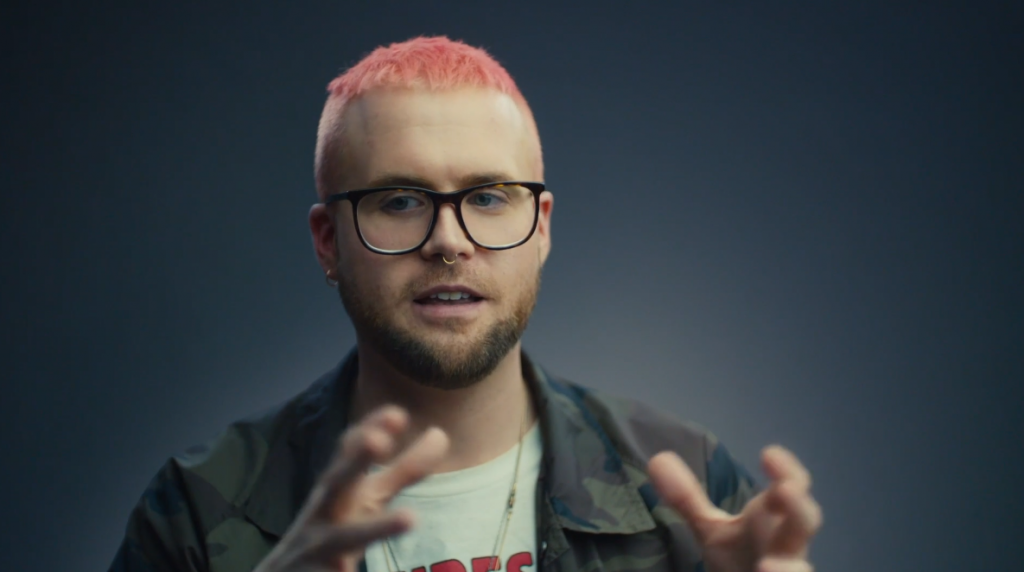
The DNL discussed this subject widely within the conference ‘Hate News: Manipulators, Trolls & Influencers’ (May 2018), trying to define the ways of pervasive, hyper-individualized, corporate-based, and illegal harvesting of personal data – at times developed in partnership with governments – through smartphones, computers, virtual assistants, social media, and online platforms, which could inform almost every aspect of social and political interactions.

With the overall theme ‘AI Traps: Automating Discrimination‘ (June 2019), DNL sought to define how artificial intelligence and algorithms reinforce prejudices and biases in society. These same issues were raised in the Activation conference, in the talk ‘An Autopsy of Online Love, Labour, Surveillance and Electricity/Energy.’ Joana Moll, artist and researcher, in conversation with DNL founder Tatiana Bazzichelli, presented her latest projects ’The Dating Brokers’ and ‘The Hidden Life of an Amazon User,’ on the hidden side of IT-interface and data harvesting.
The artist’s work moves from the challenges of the so-called networked society to a critique of social and economic practices of exploitation, which focuses on what stands behind the interface of technology and IT services, giving a visual representation of what is hidden. The fact that users do not see what happens behind the online services they use has weakened the ability that individuals and collectives have to define and protect their privacy and self-determination, getting stuck in traps built to get the best out of their conscious or unconscious contribution. Moll explains that, although most people’s daily transactions are carried out through electronic devices, we know very little of the activities that come with and beyond the interface we see and interact with. We do not know how the machine is built, and we are mostly not in control of its activities.
Her project ‘The Dating Brokers’ focuses on the current practices in the global online dating ecosystem, which are crucial to its business model but mostly opaque to its users. In 2017, Moll purchased 1 million online dating profiles from the website USDate, a US company that buys and sells profiles from all over the world. For €136, she obtained almost 5 million pictures, usernames, email addresses, details about gender, age, nationality, and personal information such as sexual orientation, private interests, profession, physical characteristics, and personality. Analysing few profiles and looking for matches online, the artist was able to define a vast network of companies and dating platforms capitalising on private information without the consent of their users. The project is a warning about the dangers of placing blind faith in big companies and raises alarming ethical and legal questions which urgently need to be addressed, as dating profiles contain intimate information on users and the exploitation and misuse of this data can have dramatic effects on their lives.
With the ongoing project ‘The Hidden Life of an Amazon User,’ Moll attempts to define the hidden side of interfaces. The artist documented what happens in the background during a simple order on the platform Amazon. Purchasing the book ‘The Life, Lessons & Rules for Success’ by Amazon founder Jeff Bezos her computer was loaded with so many scripts and requests, that she could trace almost 9,000 pages of lines of code as a result of the order and more than 87 megabytes of data running in the background of the interface. A large part of the scripts are JavaScript files, that can theoretically be employed to collect information, but it is not possible to have any idea of what each of these commands meant.

With this project, Moll describes the hidden aspects of a business model built on the monitoring and profiling of customers that encourages them to share more details, spend more time online, and make more purchases. Amazon and many other companies aggressively exploit their users as a core part of their marketing activity. Whilst buying something, users provide clicks and data for free and guarantee free labour, whose energy costs are not on the companies’ bills. Customers navigate through the user interface, as content and windows constantly load into the browser to enable interactions and record user’s activities. Every single click is tracked and monetized by Amazon, and the company can freely exploit external free resources, making a profit out of them.
The artist warns that these hidden activities of surveillance and profiling are constantly contributing to the release of CO2. This due to fact that a massive amount of energy is required to load the scripts on the users’ machine. Moll followed just the basic steps necessary to get to the end of the online order and buy the book. More clicks could obviously generate much more background activity. A further environmental cost that customers of these platforms cannot decide to stop. This aspect shall be considered for its broader and long term implications too. Scientists predict that by 2025 the information and communications technology sector might use 20 per cent of all the world’s electricity, and consequently cause up to 5.5 per cent of global carbon emissions.
Moll concluded by saying we can hope that more and more individuals will decide to avoid certain online services and live in a more sustainable way. But, trends show how a vast majority of people using these platforms and online services, are harmful, because of their hidden mechanisms, affecting people’s lives, causing environmental and socio-economic consequences. Moll suggested that these topics should be approached at the community level to find political solutions and countermeasures.

The 17th conference of the Disruption Network Lab, ‘Citizens of Evidence’ (September 2019,) was meant to explore the investigative impact of grassroots communities and citizens engaged to expose injustice, corruption, and power asymmetries. Citizen investigations use publicly available data and sources to autonomously verify facts. More and more often ordinary people and journalists work together to provide a counter-narrative to the deliberate disinformation spread by news outlets of political influence, corporations, and dark money think-tanks. In this Activation conference, in a talk moderated by Nada Bakr, the DNL project and community manager, Hadi Al Khatib, founder and Director of ’The Syrian Archive’, and artist and filmmaker Jasmina Metwaly, altogether focused on the role of open archives in the collaborative production of social justice.
The Panel ‘Archives of Evidence: Archives as Collective Memory and Source of Evidence’ opened with Jasmina Metwaly, member of Mosireen, a media activist collective that came together to document and spread images of the Egyptian Revolution of 2011. During and after the revolution, the group produced and published over 250 videos online, focusing on street politics, state violence, and labour rights; reaching millions of viewers on YouTube and other platforms. Mosireen, who in Arabic recalls a pun of the words “Egypt” and “Determination” which could be translated as “we are determined,” has been working since its birth on collective strategies to allow participation and channel the energies and pulses of the 2011 protesters into a constructive discourse necessary to keep on fighting. The Mosireen activists organised street screenings, educational workshops, production facilities, and campaigns to raise awareness on the importance of archives in the collaborative production of social justice.
In January 2011, the wind of the Tunisian Revolution reached Egyptians, who gathered in the streets to overthrow the dictatorial system. In the central Tahrir Square in Cairo, for more than three weeks, people had been occupying public spaces in a determined and peaceful protest to get social and political change in the sense of democracy and human rights enhancement.
For 5 years, since 2013, the collective has put together the platform ‘858: An Archive of Resistance’ – an archive containing 858 hours of video material from 2011, where footage is collected, annotated, and cross-indexed to be consulted. It was released on 16th January 2018, seven years after the Egyptian protests began. The material is time-stamped and published without linear narrative, and it is hosted on Pandora, an open-source tool accessible to everybody.
The documentation gives a vivid representation of the events. There are historical moments recorded at the same time from different perspectives by dozens of different cameras; there are videos of people expressing their hopes and dreams whilst occupying the square or demonstrating; there is footage of human rights violations and video sequences of military attacks on demonstrators.
In the last six years, the narrative about the 2011 Egyptian revolution has been polluted by revisionisms, mostly propaganda for the government and other parties for the purposes of appropriation. In the meantime, Mosireen was working on the original videos from the revolution, conscious of the increasing urgency of such a task. Memory is subversive and can become a tool of resistance, as the archive preserves the voices of those who were on the streets animating those historical days.
Thousands of different points of views united compose a collection of visual evidence that can play a role in preserving a memory of events. The archive is studied inside universities and several videos have been used for research on the types of weapons used by the military and the police. But what is important is that people who took part in the revolution are thankful for its existence. The archive appears as one of the available strategies to preserve people’s own narratives of the revolution and its memories, making it impermeable to manipulations. In those days and in the following months, Egypt’s public spaces were places of political ferment, cultural vitality, and action for citizens and activists. The masses were filled with creativity and rebellion. But that identity is at risk to disappear. That kind of participation and of filming is not possible anymore; public spaces are besieged. The archive cannot be just about preserving and inspiring. The collective is now looking for more videos and is determined to carry on its work of providing a counter-narrative on Egyptian domestic and international affairs, despite tightened surveillance, censorship, and hundreds of websites blocked by the government.

There are many initiatives aiming to resist forgetting facts and silencing independent voices. In 2019, the Disruption Network Lab worked on this with Hadi Al Khatib, founder and director of ‘The Syrian Archive,’ who intervened in this panel within the Activation conference. Since 2011, Al Khatib has been working on collecting, verifying, and investigating citizen-generated data as evidence of human rights violations committed by all sides in the Syrian conflict. The Syrian Archive is an open-source platform that collects, curates, and verifies visual documentation of human rights violations in Syria – preserving data as a digital memory. The archive is a means to establish a verified database of facts and represents a tool to collect evidence and objective information to put an order within the ecosystem of misinformation and the injustices of the Syrian conflict. It also includes a database of metadata information to contextualise videos, audios, pictures, and documents.
Such a project can play a central role in defining responsibilities, violations, and misconducts, and could contribute to eventual post-conflict juridical processes since the archive’s structure and methodology is supposed to meet international standards. The Syrian conflict is a bloody reality involving international actors and interests which is far from being over. International reports in 2019 indicate at least 871 attacks on vital civilian facilities with the deaths of 3,364 civilians, where one in four were children.
The platform makes sure that journalists and lawyers are able to use the verified data for their investigations and criminal case building. The work on the videos is based on meticulous attention to details, and comparisons with official sources and publicly available materials such as photos, footage, and press releases disseminated online.
The Syrian activist and archivist explained that a lot of important documents could be found on external platforms, like YouTube, that censor and erase content using AI under pressures to remove “extremist content,” purging vital human rights evidence. Social media has been recently criticized for acting too slowly when killers live-stream mass shootings, or when they allow extremist propaganda within their platforms.
DNL already focused on the consequences of automated removal, which in 2017 deleted 10 per cent of the archives documenting violence in Syria, as artificial intelligence detects and removes content – but an automated filter can’t tell the difference between ISIS propaganda and a video documenting government atrocities. The Google-owned company has already erased 200,000 videos with documental and historical relevance. In countries at war, the evidence captured on smartphones can provide a path to justice, but AI systems often mark them as inadequate violent content which consequently erases them.
Al Khatib launched a campaign to warn platforms to fix and improve their content moderation systems used to police extremist content, and to consider when they define their measures to fight misinformation and crimes, aspects like the preservation of the common memory on relevant events. Twitter, for example, has just announced a plan to remove accounts which have been inactive for six months or longer. As Al Khatib explains, this could result in a significant loss to the memory of the Syrian conflict and of other war zones, and cause the loss of evidence that could be used in justice and accountability processes. There are users who have died, are detained, or have lost access to their accounts on which they used to share relevant documents and testimonies.
In the last year, the Syrian Archive platform was replicated for Yemen and Sudan to support human rights advocates and citizen journalists in their efforts to document human rights violations, developing new tools to increase the quality of political activism, future prosecutions, human rights reporting and research. In addition to this, the Syrian Archive often organises workshops to present its research and analyses, such as the one in October within the Disruption Network Lab community programme.
The DNL often focuses on how new technologies can advance or restrict human rights, sometimes offering both possibilities at once. For example, free open technologies can significantly enhance freedom of expression by opening up communication options; they can assist vulnerable groups by enabling new ways of documenting and communicating human rights abuses. At the same time, hate speech can be more readily disseminated, technologies for surveillance purposes are employed without appropriate safeguards and impinge unreasonably on the privacy of individuals; infrastructures and online platforms can be controlled to chase and discredit minorities and free speakers. The last panel discussion closing the conference was entitled ‘Algorithmic Bias: AI Traps and Possible Escapes’, moderated by Ruth Catlow, who took the floor to introduce the two speakers and asked them to debate effective ways to define this issue and discuss possible solutions.
Ruth Catlow is co-founder and co-artistic director of Furtherfield, an art gallery in London’s Finsbury Park – home for artworks, labs, and debates based on playful collaborative art research experiences, always across distances and differences. Furtherfield diversifies the people involved in shaping emerging technologies through an arts-led approach, always looking at ways to disrupt network power of technology and culture, to engage with the urgent debates of our time and make these debates accessible, open, and participated. One of its latest projects focused on algorithmic food justice, environmental degradation, and species decline. Exploring how new algorithmic technologies could be used to create a fairer and more sustainable food system, Furtherfield worked on solutions in which culture comes before structures, and human organisation and human needs – or the needs of other living beings and living systems – are at the heart of design for technological systems.
As Catlow recalled, in the conference ‘AI Traps: Automating Discrimination’ (June 2019), the Disruption Network Lab focused on the possible countermeasures to the AI-informed decision-making potential for racial bias and reinforced through AI decision-making tools. It was an inspiring and stimulating event on inclusion, education, and diversity in tech, highlighting how algorithms are not neutral and unbiased. On the contrary, they often reflect, reinforce, and automate the current and historical biases and inequalities of society, such as social, racial, and gender prejudices. The panel within the Activation conference framed these issues in the context of the work by the speakers, Caroline Sinders and Sarah Grant.

Sinders is a machine learning design researcher and artist. In her work, she focuses on the intersections of natural language processing, artificial intelligence, abuse, online harassment, and politics in digital and conversational spaces. She presented her last study on the Intersectional Feminist AI, focusing on labour and automated computer operations.
Quoting Hyman (2017), Sinders argued that the world is going through what some are calling a Second Machine Age, in which the re-organisation of people matters as much as, if not more than, the new machines. Employees receiving a regular wage or salary have begun to disappear, replaced by independent contractors and freelancers; remuneration is calculated on the basis of time worked, output, or piecework, and paid to employees for hours worked. Labour and social rights conquered with hard, bloody fights in the last two centuries seem to be irrelevant. More and more tasks are operated through AI, which plays a big role in the revenues of big corporations. But still, machine abilities are possible just with the fundamental contribution of human work.
Sinders begins her analyses considering that human labour has become hidden inside of automation, but is still integral to that. The training of machines is a process in which human hands touch almost every part of the pipeline, making decisions. However, people who train data models are underpaid and unseen inside of this process. As Thomas Thwaites’ toaster project, a critical design project in which the artist built a commercial toaster from scratch – melting iron and building circuits and creating a new plastic shell – Sinders analyses the Artificial Intelligence economy under the lens of feminist, intersectionalism, to define how and to which extent it is possible to create an AI that respects in all its steps the principles of non-exploitation, non-bias, and non-discrimination.
Her research considers the ‘Mechanical Turks’ model, in which machines masquerade as a fully automated robot but are operated by a human. Mechanical Turk is actually a platform run by Amazon, where people execute computer-like tasks for a few cents, synonymous with low-paid digital piecework. A recent research analysed nearly 4 million tasks on Mechanical Turk performed by almost 3,000 workers found that those workers earned a median wage of about $2 an hour, whilst only 4% of workers on Mechanical Turk earned more than $7,25 an hour. Since 2005 this platform has flourished. Mechanical Turks are used to train AI systems online. Even though it is mostly systematised factory jobs, this labour falls under the gig economy, so that people employed as Mechanical Turks are considered gig workers, who have no paid breaks, holidays, and guaranteed minimum wage.
Sinder concluded that an ethical, equitable, and feminist environment is not achievable within a process based on the competition among slave labourers that discourages unions, pays a few cents per repetitive task and creates nameless and hidden labour. Such a process shall be thoughtful and critical in order to guarantee the basis for equity; it must be open to feedback and interpretation, created for communities and as a reflection of those communities. To create a feminist AI, it is necessary to define labour, data collection, and data training systems, not just by asking how the algorithm was made, but investigating and questioning them from an ethical standpoint, for all steps of the pipeline.

In her talk Grant, founder of Radical Networks, a community event and art festival for critical investigations and creative experiments around networking technology, described the three main planes online users interact with, where injustices and disenfranchisement can occur.
The first one is the control plane, which refers to internet protocols. It is the plumbing, the infrastructure. The protocol is basically a set of rules which governs how two devices communicate with each other. It is not just a technical aspect, because a protocol is a political action which basically involves exerting control over a group of people. It can also mean making decisions for the benefit of a specific group of people, so the question is our protocols but our protocols political.
The Internet Engineering Task Force (IETF) is an open standards organisation, which develops and promotes voluntary Internet standards, in particular, the standards that comprise the Internet protocol suite (TCP/IP). It has no formal membership roster and all participants and managers are volunteers, though their activity within the organisation is often funded by their employers or sponsors. The IETF was initially supported by the US government, and since 1993 has been operating as a standards-development function under the international membership-based non-profit organisation Internet Society. The IETF is controlled by the Internet and Engineering Steering Group (IESG), a body that provides final technical review of the Internet standards and manages the day-to-day activity of the IETF, setting the standards and best practices for how to develop protocols. It receives appeals of the decisions of the working groups and makes the decision to progress documents in the standards track. As Grant explained, many of its members are currently employed for major corporations such as Google, Nokia, Cisco, Mozilla. Though they serve as individuals, this issues a conflict of interests and mines independence and autonomy. The founder of Radical Networks is pessimistic about the capability of for-profit companies to be trusted on these aspects.
The second plane is the user plane, where we find the users’ experience and the interface. Here two aspects come into play: the UX design (user experience design), and the UI (user interface design). UX is the presumed interaction model which defines the process a person will experience when using a product or a website, while the UI is the actual interface, the buttons, and different fields we see online. UX and UI are supposed to serve the end-user, but it is often not like this. The interface is actually optimized for getting users to act online in ways which are not in their best interest; the internet is full of so-called dark patterns designed to mislead or trick users to do things that they might not want.
These dark patterns are part of the weaponised design dominating the web, which wilfully allows for harm of users and is implemented by designers who are not aware of or concerned about the politics of digital infrastructure, often considering their work to be apolitical and just technical. In this sense, they think they can keep design for designers only, shutting out all the other components that constitute society and this is itself a political choice. Moreover, when we consider the relation between technology and aspects like privacy, self-determination, and freedom of expression we need to think of the international human rights framework, which was built to ensure that – as society changes – the fundamental dignity of individuals remain essential. In time, the framework has demonstrated to be plastically adaptable to changing external events and we are now asked to apply the existing standards to address the technological challenges that confront us. However, it is up to individual developers to decide how to implement protocols and software, for example, considering human rights standards by design, and such choices have a political connotation.
The third level is the access plane which is what controls how users actually get online. Here, Grant used Project loon as an example to describe the importance of owning the infrastructure. Project loon by Google is an activity of the Loon LLC, an Alphabet subsidiary working on providing Internet access to rural and remote areas, bringing connectivity and coverage after natural disasters with internet-beaming balloons. As the panellist explained, it is an altruistic gesture for vulnerable populations, but companies like Google and Facebook respond to the logic of profit and we know that controlling the connectivity of large groups of populations provide power and opportunities to make a profit. Corporations with data and profilisation at the core of their business models have come to dominate the markets; many see with suspicion the desire of big companies to provide Internet to those four billions of people that at the moment are not online.
As Catlow warned, we are running the risk that the Internet becomes equal to Facebook and Google. Whilst we need communities able to develop new skills and build infrastructures that are autonomous, like the wireless mesh networks that are designed so that small devices called ‘nodes’ – commonly placed on top of buildings or in windows – can send and receive data and a WIFI signal to one another without an Internet connection. The largest and oldest wireless mesh network is the Athens Wireless Metropolitan Network, or A.W.M.N., in Greece, but we also have other successful examples in Barcelona (Guifi.net) and Berlin (Freifunk Berlin). The goal is not just counterbalancing superpowers of telecommunications and corporations, but building consciousness, participation, and tools of resistance too.

The Activation conference gathered in the Berliner Künstlerhaus Bethanien, the community around the Disruption Network Lab, to share collective approaches and tools for activating social, political, and cultural change. It was a moment to meet collectives and individuals working on alternative ways of intervening in the social dynamics and discover ways to connect networks and activities to disrupt systems of control and injustice. Curated by Lieke Ploeger and Nada Bakr, this conference developed a shared vision grounded firmly in the belief that by embracing participation and supporting the independent work of open platforms as a tool to foster participation, social, economic, cultural, and environmental transparency, citizens around the world have enormous potential to implement justice and political change, to ensure inclusive, more sustainable and equitable societies, and more opportunities for all. To achieve this, it is necessary to strengthen the many existing initiatives within international networks, enlarging the cooperation of collectives and realities engaged on these challenges, to share experiences and good practices.
Information about the 18th Disruption Network Lab Conference, its speakers, and topics are available online:
https://www.disruptionlab.org/activation
To follow the Disruption Network Lab, sign up for its newsletter and get information about conferences, ongoing research, and latest projects. The next event is planned for March 2020.
The Disruption Network Lab is also on Twitter and Facebook.
All images courtesy of Disruption Network Lab
On the 20th of September, Tatiana Bazzichelli and Lieke Ploeger opened the 17th conference of the Disruption Network Lab with CITIZENS OF EVIDENCE to explore the investigative impact of grassroots communities and citizens engaged to expose injustice, corruption, and power asymmetries.
Citizen investigations use publicly available data and sources to autonomously verify facts. More and more often ordinary people and journalists work together to provide a counter-narrative to the deliberate disinformation spread by news outlets of political influence, corporations, and dark money think-tanks. However, journalists and citizens reporting on matters in the public interest are targeted because of the role they play in ensuring an informed society. The work of independent investigation is often delegitimised by public authorities and denigrated in a wave of generalisations against ‘the elites’ and media objectivity, actually designed to undermine independent information and stifle criticism. It appears to be a global process that aims at blurring progressively the boundary between what is fake and what is real, growing to such a level that traditional mainstream media and governments seem incapable of protecting society from a tide of disinformation.
An increasingly Orwellian campaign for the purpose discredit upon them has been built for years against citizens and activists opposing the project of a controversial high-speed rail line for freight trains between Italy and France, which is considered useless and harmful. The Disruption Network Lab conference opened with the keynote GHOSTS IN THE WOODS AND UNCANNY ENTITIES: On How to Cover the Italian «NO TAV» Movement by Wu Ming 1, who spent three years among the people of the Susa Valley opposing this mega-infrastructural project.

As the moderator, author, and filmmaker Alexandra Weltz-Rombach explained, Wu Ming is a pseudonym for a group of Italian authors formed in Bologna after the experience of the Luther Blissett project. For almost 20 years the literary collective has been writing essays, meta-historical novels, and creative narrative, using often the techniques of investigative journalism. Today it is widely appreciated for its capability to deconstruct and analyse complex aspects of social and political life, challenging long-existing paradigms and traditions and synthesizing the views of different minds, to build an alternative narration on facts, inspiring unconventional critical process. Wu Ming 1 explored the Susa Valley and the woods occupied by police and wire fences, experiencing the struggle of a community in its territories, to write a history-as-novel take on the most enduring and radical environmental protest in contemporary Italy, known as No-TAV (TAV stands for Treno Alta Velocità – High Speed Train). To do so, he walked, mapped the territory, and ‘evoked ghosts’. The history of a country can be described by the history of its borders and the Susa Valley is a borderland in the mountains. Probably where Hannibal walked with his army to cross the Alps, since the early 90s it has been projected another huge tunnel inside the mountains, in a long-standing tradition of railroad-tunnels built sacrificing lives and health.
To understand the No-TAV struggle we can go back in time. To when the TAV-railway was first projected, and contextually the opposition of local communities started. But also, back in time to all the conflicts that have been fought on these mountains, which are “full of ghosts” as the author said. Wu Ming 1 explained that in literature and popular tradition, a ghost appears when there is an unresolved story, a wasted life that ended badly. Borderlands are the places where the most of ghosts are to be found. In the Susa Valley, ghosts are suppressed memories of wars and of social conflicts that shaped the territory.
Wu Ming published several works on environmental and climatic issues and wrote a lot about mountains too. Almost 78% of Italian territory is covered by mountains or hills. Their iconic representation has been at time twisted by nationalism, militarism and machismo. The Alps were “sacred borders of the fatherland” – nature to conquer, a symbol of virility and power in fascist propaganda. Today those mountains are an obstacle to economic growth; a growth that might put at risk the whole Susa Valley. Thus, instead of tackling legitimate concerns, project Stakeholders have been seeking for 20 years to delegitimize those leveling the charges against the high-speed railway, despite the masses of evidence to support their claims, using intimidation and violence against them. But the no-TAV collectives’ claims have always been proven to be right, and the project has been declining in size over time. However, the fight within the Valley is still on and the TAV-project is far from being archived.

The panel on the first day, EXPOSING ABUSES: Citizens Recording Human Rights Violations from the US to The Gambia, introduced by Michael Hornsby of Transparency International, opened with a presentation by Melissa Segura, journalist of BuzzFeed News from the US. She documented allegations proving that the Chicago police officer Reynaldo Guevara had framed dozens of innocent people for murder. The reporter put a light on forgotten judiciary cases, giving voice to families and communities affected by injustices, hit by a profound brokenness that she experienced herself when her nephew was framed and arrested years before.
A group of black and Latino mothers, aunts, and sisters knew that their beloved were innocent, but no officials wanted to take up their cause. Segura met these women after they had been fighting for decades in search of justice. They began when the journalist was at her elementary school: “at the time they had already gathered in a team, collecting data and writing spreadsheets on Lotus” she recalled. They had no chance to be heard, no PR, no lobby, no support from media were available to them. Segura realized soon that the story she had to cover wasn´t just the conviction of a 19-year-old-boy sentenced in 1999 with 110 years of prison for a murder he did not commit. It was also about the community of women that were fighting for justice, it was about their lives.
She learnt soon that her sources were able to cover their own stories much better than how she could, showing her new paths to the truth. The journalist dedicated time to building a trusting relationship with them, giving full reassurance that their story would be fairly reported. After an intense three-year investigation, she succeeded in wearing down a key witness to testify, cracking the wall of impunity. This process, she said, “did not expose the harm of people, but tried to connect to it.”
Reynaldo Guevara has been beating up people, framing them, extorting false confessions and false witnesses for years. Since publishing Segura’s articles, seven innocent men have been freed, and dozens more convictions are under review.
In the context of the major movements that draw attention on issues such as injustice and police violence targeting specific communities and minorities in the US, policy and data analyst Samuel Sinyangwe decided to join the work of justice activist groups formed after the 2014 police shooting of Michael Brown in Ferguson, Missouri. He is now part of the Police Scorecard project, and of the Campaign Zero independent platform he co-founded, designed to facilitate and guarantee the collection of data on these violations. Sinyangwe explained that, as of today, the US government has implemented neither collections of data on police misconducts, violence and killings, nor public database of disciplined police officers. In his view, US law enforcement agencies have failed to provide even basic information about the lives they have taken, in a country where at least three people are killed by police every day and black people are 3 times more probable to end up victims of brutal use of force by the police.
The independent observatory built by Sinyangwe seems to be quite effective. It is described as the most comprehensive accounting of people killed by police since 2013 in the US. A report from the US Bureau of Justice Statistics estimated that approximately 1,200 people were killed by police between June 2015 and May 2016. The database identified 1.179 people killed by police over this same time period. These estimates suggest that it was able to capture 98% of the total number of police killings that occurred. Sinyangwe hopes these data will be used to provide greater transparency and accountability for police departments as part of the ongoing campaign to end police violence in black and Latino communities, leading to a change of policies.
With data able to map the situation in the US, it has also been possible to make comparisons and drew analyses. The Campaign Zero researches show that there is a whole false narrative about criminality rates, based on numbers that just mirror a system based on different federal policies regarding police forces, and that levels of violent crime in US cities do not determine rates of police violence.
According to data, cities with the same density of population have very different rates of violence, and very different rules regulating the activity of police agents. Starting from this, Sinyangwe and his team decided to look for different policy documents from different police department. These policies determine how and when a local policeman is authorized to use force. With a closer look, the Campaign Zero team could easily determine that there is no federal standard. Some documents live a grey area, others discourage the use of force, and particularly of deadly force, limiting it to the most dangerous scenarios after all lesser means of use of force have failed. Some seem to openly encourage it instead.

The group listed eight types of restrictions in the use of force to be found in these policies, consisting of escalators that aim at excluding, as far as possible, the use of violence. Comparisons show that a combination of these restrictions, when put in place, can produce a large reduction in police violence. Policies combining restrictions predicted indeed significantly lower rate of deathly force.
Data about unarmed people killed by police in major American cities show that black people are three times more likely to be killed by police than white people (2013-2018). Movements such as Black Lives Matter started also because of this. Another problem is that it is extremely difficult to hold US police members accountable.
Sinyangwe underlined how it is necessary to research the components that predict police violence, and that can help hold officers accountable, to be sure that they are enforced by police departments.
Police union contracts – for example – can be considered an obstacle on the way to accountability and transparency. It is extremely rare to have a policeman convicted for a crime in the US. It is a systematic fact and it cannot be reduced just to the individuals, who are acting using brutal and deathful force. It is a matter of lack of training, lack of policies enhancing non-violent solutions, but there is also legislation that protects policemen from legal consequences. It is not easy even to sue a US policeman, as they are shielded by qualified immunity and often by confidential police records, limiting how officers are investigated and disciplined. As of today, this makes impossible to identify and punish misbehaviours, abuses, and responsibilities in most cases. According to Mapping Police Violence, a research collaborative collecting comprehensive data on police killings to quantify the impact of US police violence in communities that Sinyangwe set up, 99% of cases in 2015 have not resulted in any officer involved being convicted for a crime.
The Campaign Zero platform is designed to be a tool able to enhance participation, foster accountability and transparency. It is an instrument to prevent killings and it calls for the adoption of a comprehensive package of urgent policy solutions – informed by data, research and human rights principles – that can change the way police serve communities.
The last panellist of the day was the participatory video facilitator from the UK, Gareth Benest, who presented the “Giving Voice to Victims of Grand Corruption in The Gambia” participatory video project. It is an initiative implemented on behalf of Transparency International in reaction to “The Great Gambia Heist” investigations by OCCRP (Organized Crime and Corruption Reporting Project) revealed in March 2019, which allowed those affected by grand corruption to share their stories and present their truths in carefully edited video messages, and to give voice to those Gambians who are deprived from access to basic health, education, agriculture, and portable drinking water.
In Gambia, a truth and reconciliation commission has begun to investigate rights abuses during the 22-year-long dictatorship of Yahya Jammeh ended in 2017. OCCRP has exposed for the first time how the corrupted dictator and his associates plundered nearly 1 billion US$ of timber resources and Gambia’s public funds. Thousands of documents dated between 2011 and 2016, including government correspondence, contracts, and legal documents, bank records, internal investigations able to define in detail the level of corruption and impunity of the Gambian system.
After the end of Jammeh’s rule, authorities have declared they will shed light on corruption, extrajudicial killings, torture, and other human rights violations. It is an important process of reconciliation, but still the voices of the marginalized and rural citizens are not heard. ‘Giving Voice to Victims of Grand Corruption in The Gambia’ was meant to facilitate a process with Gambian community members to express their perspectives on local problems and ideas, translating them into a film.
Benest explained how such a project is supposed to enable these communities to focus on the issues they are affected by and move towards changing their circumstances.
The participatory video is a technique that has been used to fight injustice in different contexts for many years. Benest recalled recent projects involving a community displaced by diamond-mining, young people excluded from poverty eradication strategies, widows made landless by customary leaders, and island residents threatened with forced evictions by land grabbers. In his work, the facilitator encourages equal participation and rotation of rules within the team. Participants control every aspect of the video making, from the process to the final result. Self-directed and self-organised videos become a communication tool that allows participant to build a dialogue for positive change.

The second day of the Disruption Network Lab conference opened with the keynote speech of Matthew Caruana Galizia, WHAT INDEPENDENT INVESTIGATORS DON’T USUALLY DISCLOSE, in which he addressed issues freelancers investigating high-level corruption face in silence and isolation, often with tragic consequences. The journalist, in conversation with Crina Boros, talked about the background of his mother, the Maltese reporter and blogger Daphne Caruana Galizia, who was killed on the 16th of October 2017, outlining the risks and the outcomes of her dangerous and brave work.
Her murder had been planned in detail for a long time. Killers were arrested, but the mandators haven’t been identified yet, and the criminal investigation is not moving forward. Daphne Galizia’s family is pushing the issue internationally and within Malta, knowing that without doing something this case would just disappear from news headlines without solution. Anti-corruption investigative journalists are arrested, threatened, and killed everywhere. People just vanish, and no justice is done.
For the 15 years before her death, Daphne Caruana Galizia had been appearing in 65 court cases filed against her. Her bank account was frozen; she was a victim of media campaigns against her; and she was sued by politicians, businessmen, and other journalists too. Her son recalled when he was nine that their dog was found slaughtered, then the front door of their house was burnt down. Later on, one of their dogs was shot, and another poisoned. Threats and violence continued until their whole house was set on fire. No investigation was ever effectively put in place to find out the perpetrators of these crimes, though the journalist and her family had always pressed charges against unknown.
It is hard to be confronted with the pain and memories of personal events on a stage in front of an audience, but the issue of justice is too urgent. Even if talking about her gets more and more difficult every time, Matthew is travelling the world to keep fighting and demand justice for his mother.
Matthew had spent the last years working with his mother. The International corruption revealed by the Panama Papers – on which they were investigating – was not cause of resignations and public assumption of responsibility in Malta. Involved politicians and news outlets attacked with all available means independent journalists covering the cases. The pressure on Daphne intensified in such a way, that she was sued 30 times just in the last year before her death. In those moments she kept repeating to his son Matthew that, no matter how hopeless the situation, there is an urgency to strive to make corruption and responsibilities publicly known. The Maltese blogger was not naive, she was well aware that there was the risk of getting killed, as it happened to Anna Stepanowna Politkowskaja and many colleagues all over the world. But she did not give in.
Reviewing his mother’s life, Matthew mentioned a further aspect to consider: Daphne had to use much of her time and money to defend herself inside trials against her, which were long and very expensive. She had passion and abilities. She was so talented that she could publish a magazine about food, architecture, and design – on which she spent just a couple of days a month – to earn money enough to carry on with her independent investigation work, and pay for her legal defence.
When there is a whole system against you, you need very good lawyers, you need expertise, you need money to pay for it. The Maltese blogger spent a whole career overcoming the obstacles of a corrupted system and she self-sustained economically, making sacrifices. Although all this, still, his son Matthew and her family are convinced that the solution must come through the judicial way, using available legal instruments, and making pressure on EU institutions at the highest levels. That is why Matthew Caruana Galizia asks everybody for commitment in a demand of radical change. Malta is part of the European Union, as he keeps on repeating.

Someone has been trying to silence Daphne for years before her murder. They must have gotten to the conclusion that the only way to shut her up was an assassination, for the purpose to cancel her stories with her, as her son Matthew sadly commented. To avoid this happening, several newspapers and investigative organisations joined the «Daphne Project» a global consortium of 18 international media including Reuters, The Guardian, and Le Monde, to continue the work of the Maltese journalist. They are led by the group Forbidden Stories, whose mission is to continue the work of silenced journalists. They stand together because they think that even if you kill a journalist like Caruana Galizia, her investigations cannot be buried with her. Thanks to the Daphne Project, and the courage and determination of Daphne Caruana Galizia’s family, her investigation lives on.
Matthew stressed the fact that it’s not about the future of one politician, or of a specific criminal group. It is about the future of Malta and the EU. Journalists who defend democracy are alone when they face the repercussions of what they do. It is necessary to make sure that when there are outcomes due to effective journalism, a society trained to react and self-organise can pick up the investigative work, defend independent investigation, and ask for political accountability within a public discussion. In Malta, nothing of this ever happened, and Daphne became more isolated.
Grassroot citizens organisations are fundamental to boost activism inside local communities and demand for justice. In cases like Daphne’s, no one is going to do it if not organised citizens, together with independent journalists and organisations. Many killed journalists had neither a family nor an organisation that could fight on for them. Maltese Police seem to have never developed professional skills to effectively work on this kind of criminal cases, and the few results from recent years were from the FBI in the USA. Criminals within a system that guarantees impunity can easily develop better skills.
Moreover, in Malta, investigations have a very poor rate of success and in Daphne’s case, we just know how she was murdered. But the political atmosphere, in which this murder matured, has been untouched for these last two years, and the journalist’s family is worried the official inquiry that just started in the country is neither independent nor impartial. Members of the Board of Inquiry, they claim, have conflicts of interests at different levels, either because they were part of previous investigations or because they have ties to subjects who may be investigated now.

In the last panel of the conference, as Bazzichelli explained, the discussion focused on the connection between grassroots investigations and data analysis, and how it is possible to make sensitive data accessible without restriction and open them to the public, facilitating the publication of large datasets.
M C McGrath and Brennan Novak, introduced by moderator Shannon Cunningham, presented a tool designed to enable the publishing of data in searchable archives and the sorting through large datasets. The group builds free software to collect and analyse open data from a variety of sources. They work with investigative journalists and human rights organisations to turn that into useful, actionable knowledge. Their Transparency Toolkit is accessible to activists and citizen journalists, as well as those who lack resources or technical skills. Until a few years ago only big media organisations with particularly good technical resources could set up such instrumentation. The two IT experts decided to increase the use and the impact of open information, considering participation as a key factor to reduce the difficulties caused by relying only on media outlets or single journalists to cover complex facts or analyse large datasets.
As M C McGrath and Novak explained, Transparency Toolkit uses open data “to watch the watchers” and to hold powerful individuals and groups accountable. At the moment, their primary focus is investigating surveillance and human rights abuses, like in the case of the Hacking Team leaks in July 2015.
Hacking Team is an Italian company specialising in surveillance software and in very effective Trojans able to slip into computers and smartphones, allowing a secret and total surveillance. Four years ago, 400 GB of their data was anonymously published online, showing how the IT company had been working for authoritarian governments with questionable human rights records, to ensure they can use such software to spy on activists, journalists, and political opponents, in countries like Morocco, Dubai, Ethiopia, Mexico and Sudan. Transparency Toolkit mirrored the full Hacking Team dataset to make it more available to journalists and security researchers investigating these issues. It released a searchable archive of 200GB of emails categorized by companies, countries, events, and other subjects discussed.
Other important projects from the Transparency Toolkit team are the Surveillance Industry Index (SII) developed together with Privacy International (a searchable archive featuring over 1500 brochures about surveillance technology, data on over 520 surveillance companies, and nearly 500 reported exports of surveillance technologies), the Snowden Document Search (the first comprehensive database of Snowden documents initiated which aims to preserve its historical impact), and ICWATCH – a platform born to collect and analyse resumes of people working in the intelligence community, contractors, the military, and intelligence. These resumes are useful for uncovering new surveillance programs, learning more about known codewords, identifying which companies help with which surveillance programs, examining trends in the intelligence community, and more. ICWATCH provides a collection of over 100,000 of these resumes from LinkedIn, Indeed, and other public sources, and now searchable with a search engine called LookingGlass.
The last part of this panel was than dedicated to the Dictator Alert project, a website that tracks the planes of authoritarian regimes all over the world. Available networks censor the information about planes of intelligence, military, authorities, and heads of state. This project, run by Emmanuel Freudenthal and François Pilet with support from OCCRP, began as an open-source computer program to identify planes belonging to dictators flying over Geneva. The program mined data from a network of antennas used by plane spotters and shared its alerts via Twitter. Today, Dictator Alert uses data from ADSB-Exchange, as well as several antennas installed by the team of researchers themselves. The details of each plane captured by the antennas are compared with a list of aircrafts registered or regularly used by authoritarian regimes. When a match is found, a message is published on the website.
Freudenthal presented the methodology of acquiring information behind Dictator Alert. Some people in the audience disagreed with the panellists, arguing that a reductive definition for ‘dictator’ might questionably influence the outcomes of the project, considering that some elected leaders from countries listed as democracies are also responsible for crimes, secrets, and human rights violations. The investigative journalist responded by explaining that Dictator Alert is orientated using the Democracy Index published by The Economist. The Index appeared first in 2006, categorising countries as full democracies, flawed democracies, hybrid regimes, and authoritarian regimes, based on 60 indicators grouped in different categories, measuring pluralism, civil liberties, and political culture.
The Disruption Network Lab organised the workshop Berlin’s Sky, An Afternoon Investigation on the day following the 17th Conference. Participants gathered in the former Berliner airport Tempelhofer Feld to conduct guided research using antennas and laptops to track the sky and spot anomalies above the city.

The conference closed with the investigation by Forensic Architecture – Horizontal Verification and the Socialised Production of Evidence. Team member Robert Trafford presented the organisation founded to investigate human rights violations using a range of techniques, flanking classical investigation methods including open-source investigation video analysis, spatial and architectural practice, and digital modelling. They work with and on behalf of communities who have been affected by state and military violence, producing evidence for legal forums, human rights organisations, investigative reporters and media, as well as for arts and cultural institutions.
In Trafford´s analyses, conflict, violence, and human rights violations have become heavily mediatised and because of the “open source revolution” and smartphones, facts are often documented and relayed to the world by fragments of video material. Media sometimes report about these facts in ways which seem to make them less clear, instead of allowing better understanding. Forensic Architecture is in part a set of technical and theoretical tools for unpacking those mediatised facts, to access the truth which often exists behind and between the fragments of files that are released or leaked, to prove human rights violations. It relies on the prevalence of open source video material and tries to put an order in the fake-news and post-truth communication, offering a new model for collectively and collaboratively constructing truths. Trafford pointed out how people today, who seem to be widely rejecting the idea of institutions that they might previously have trusted to assemble facts and information, are still able to accomplish this delicate task. Often truth seems to be created elsewhere, possibly behind a wall of closed sources. The Internet and the consequent open-source revolution exploded the stability of that classic system of information, and those institutions are no longer providing truths around which people are willing or able to orient themselves. For better or worse, the vertical has been supplanted by the horizontal, Trafford said.
As those institutions falter, there is a certain breed of political actors – largely from populist and far-right parties – that have been gaining mediatic and institutional power all over the world for the last five years, encouraging the public to believe that our societies are soaked in misinformation, and that there is no possibility of reaching out and acquiring reliable facts we can all agree on and orient ourselves with.
More and more often, online and offline, we read of individuals saying that we should not trust traditional news outlets or institutions that encourage us to believe that they can guarantee independent and free information. It is under this cover of equivocation and uncertainties that the human rights violations of the 21st century are being carried out and subsequently concealed.

Forensic Architecture’s challenge is to expose this misrepresentation of things, and to offer a kind of counter truth to official versions of relevant facts. Its researchers collect little grains, clues they find inside videos, pictures, and articles that try to organise in certain ways, reassembling them into an independent analysis. By using different perspectives into ongoing practice in which the development of facts and evidence is socialized, the project encourages open and horizontal verification.
The moderator of this last session of the conference, Laurie Treffers, mentioned the idea of counter forensics. By integrating and working across different forms of knowledge, and across different institutions and disciplines – which may at times appear like they have nothing in common or that they speak in entirely different registers – horizontal verification is about unifying those for reasons of mutual protection, mutual security, and mutual reinforcement.
Trafford gave examples of Forensic Architecture’s work, such as working closely with the Gaza-based Al Mezan Center for Human Rights, the Tel Aviv-based Gisha Legal Center for Freedom of Movement, and the Adalah Legal Center for Arab Minority Rights in Haifa, when they examined the environmental and legal implications of the Israeli practice of aerial spraying of herbicides along the Gaza border.
To this end, the investigation sought to define if and how airborne herbicides travel into Gaza; how far into its territories they entered; what concentration of herbicide and what damage to the farmland on the Gazan side of the border can be calculated. The analysis of several first-hand videos, collected in the field, revealed that aerial spraying by commercial crop-dusters flying on the Israeli side of the border generally mobilises the wind to carry the chemicals into the Gaza Strip at damaging concentrations. This is a constant primary effect.
The videos used for the investigations supported the testimonies of farmers that, prior to spraying, the Israeli military uses the smoke from a burning tire to confirm the westerly direction of the wind, thereby carrying the herbicides from Israel into Gaza.
Forensic Architecture modelled the Israeli flight paths and geo-located them, compared metadata and video material, and engaged fluid dynamics experts from the University of London to look at what the potential distribution of those chemicals would be from the heights that the plane was flying, in the wind conditions that could be calculated. The investigation proves that each spray leaves behind a unique destructive signature.
“Along with the regular bulldozing and flattening of residential and farmland, aerial herbicide spraying is one part of a slow process of ‘desertification’, that has transformed a once lush and agriculturally active border zone into parched ground, cleared of vegetation,” Trafford said.
Analyses of the evidence derived from vegetation on the ground, civilian testimony, and the environmental elements mobilized in the spraying event showed that the Israeli practice of aerial fumigation at times when the wind is blowing into Gaza causes damage to farmland hundreds of meters inside the fields.

Once again, the Disruption Network Lab created a forum for discussion, to define the role of citizens in making a change in the information sphere, highlighting local and international stories, tools, and tactics for social change built on courageous grassroots reporting and investigations. The Disruption Network Lab invited guests to challenge laws that effectively criminalise journalism and whistleblowing. The conference went beyond the usual dichotomy between journalists and activists, official media and independent media, and opened up a dialogue among different expertise to discuss and present opportunities of collaboration to report misinformation, corruption, abuse, power asymmetries, and injustice.
CITIZENS OF EVIDENCE presented experts working on anti-corruption, investigative journalism, data policy, political activism, open source intelligence, video storytelling, whistleblowing, and truth-telling, who shared community-based stories to increase awareness on sensitive subjects. Bottom-up approaches and methods that include the community in the development of solutions appear to be fundamental. Projects that capacitate collectives, minorities, and marginalized communities, to develop and exploit tools to systematic combat inequalities, injustices, and impunity are to be enhanced.
Moreover, on the 29th of October, the CPJ published the 2019 Global Impunity Index, putting a spotlight on countries where journalists are slain and their killers go free. During the 10-year index period, 318 journalists were murdered for their work worldwide and no perpetrators have been successfully prosecuted in 86% of those cases. Last year, CPJ recorded complete impunity in 85% of cases. Historically, this number has been closer to 90%. All participants at the conference expressed their concern about this situation.
It is important to doubt and require a double-check over relevant news, as governments and private corporations have proved too often, that they prefer secret and manipulation to transparency and accountability. It is also important to verify constantly if media outlets, or a single journalist, are actually independent. But this shall not be used to weaken independent information and undermine the principles of particular constitutional importance regarded as ‘higher law’ on which it is based. Journalists and citizen reporters are already alone in their work.

CITIZENS OF EVIDENCE was curated by Tatiana Bazzichelli, developed in cooperation with Transparency International. It was the third in Disruption Network Lab’s 2019 series ‘The Art of Exposing Injustice’. Videos of the conference are also available on YouTube. For details of speakers and topics, please visit the event page here: https://www.disruptionlab.org/citizens-of-evidence.
To follow the Disruption Network Lab, sign up for its newsletter with information on conferences, ongoing researches, and projects. You may also find the organisation on Twitter and Facebook.
The next Disruption Network Lab event ‘ACTIVATION – COLLECTIVE STRATEGIES TO EXPOSE INJUSTICE’ is planned for November 30th, in Kunstquartier Bethanien Berlin. More info here: https://www.disruptionlab.org/activation
Image Credit:
Elena Veronese for Disruption Network Lab
Featured Image:
Graphic courtesy of Disruption Network Lab
On the day of the General Data Protection Law (GDPR) going into effect in Europe, on the 25th of May, the Disruption Network Lab opened its 13th conference in Berlin entitled “HATE NEWS: Manipulators, Trolls & Influencers”. The two-day event looked into the consequences of online opinion manipulation and strategic hate speech. It investigated the technological responses to these phenomena in the context of the battle for civil rights.
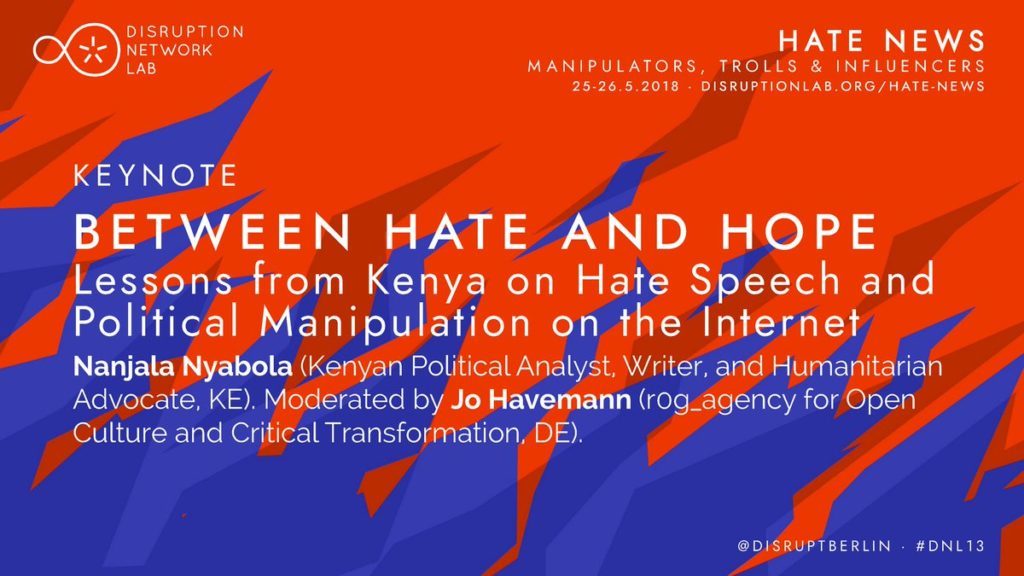
The conference began with Jo Havemann presenting #DefyHateNow, a campaign by r0g_agency for open culture and critical transformation, a community peace-building initiative aimed at combating online hate speech and mitigating incitement to offline violence in South Sudan. More than ten years ago, the bulk of African countries’ online ecosystems consisted of just a few millions of users, whilst today’s landscape is far different. This project started as a response to how social media was used to feed the conflicts that exploded in the country in 2013 and 2016. It calls to mobilize individuals and communities for civic action against hate speech and social media incitement to violence in South Sudan. Its latest initiative is the music video #Thinkbe4uclick, a new awareness campaign specifically targeted at young people.
In Africa, hate campaigns and manipulation techniques have been causing serious consequences for much longer than a decade. The work of #DefyHateNow counters a global challenge with local solutions, suggesting that what is perceived in Europe and the US as a new problem should instead be considered in its global dimension. This same point of view was suggested by the keynote speaker of the day, Nanjala Nyabola, writer and political analyst based in Nairobi. Focusing on social media and politics in the digital age, the writer described Kenya´s recent history as widely instructive, warning that manipulation and rumours can not only twist or influence election results but drive conflicts feeding violence too.
The reliance on rumours and fake news was the principal reason that caused the horrifying escalation of violence following the Kenyan 2007 general election. More than 1,000 people were killed and 650,000 displaced in a crisis triggered by accusations of election fraud. The violence that followed unfolded fast, with police use of brutal force against non-violent protesters causing most of the fatalities. The outbreak of violence was largely blamed on ethnic clashes inflamed by hate speech. It consisted of revenge attacks for massacres supposedly carried out against ethnic groups in remote areas of the country. Unverified rumours about facts that had not taken place. Misinformation and hate were broadcast over local vernacular radio stations and with SMS campaigns, inciting the use of violence, animating different groups against one another.
The general election in 2013 was relatively peaceful. However, ethnic tensions continued to grow across the whole country and ethnic driven political intolerance appeared increasingly on social media, used mainly by young Kenyans. Online manipulation and disinformation proliferated on social media again before and after the 2017 general election campaign.
Nyabola explained that nowadays the media industry in Kenya is more lucrative than in most other African regions, which could be considered a positive aspect, suggesting that within Kenya the press is free. Instead a majority media companies depend heavily on government advertising revenue, which in turn is used as leverage by authorities to censor antagonistic coverage. It should be no wonder Kenyans appear to be more reliant on rumours now than in 2007. People are increasingly distrustful of traditional media. The high risk of manipulation by media campaigns and a duopoly de facto on the distribution of news, has led to the use of social media as the principle reliable source of information. It is still too early to have a clear image of the 2017 election in terms of interferences affecting its results, but Nyabola directly experienced how misinformation and manipulation present in social media was a contributing factor feeding ethnic angst.
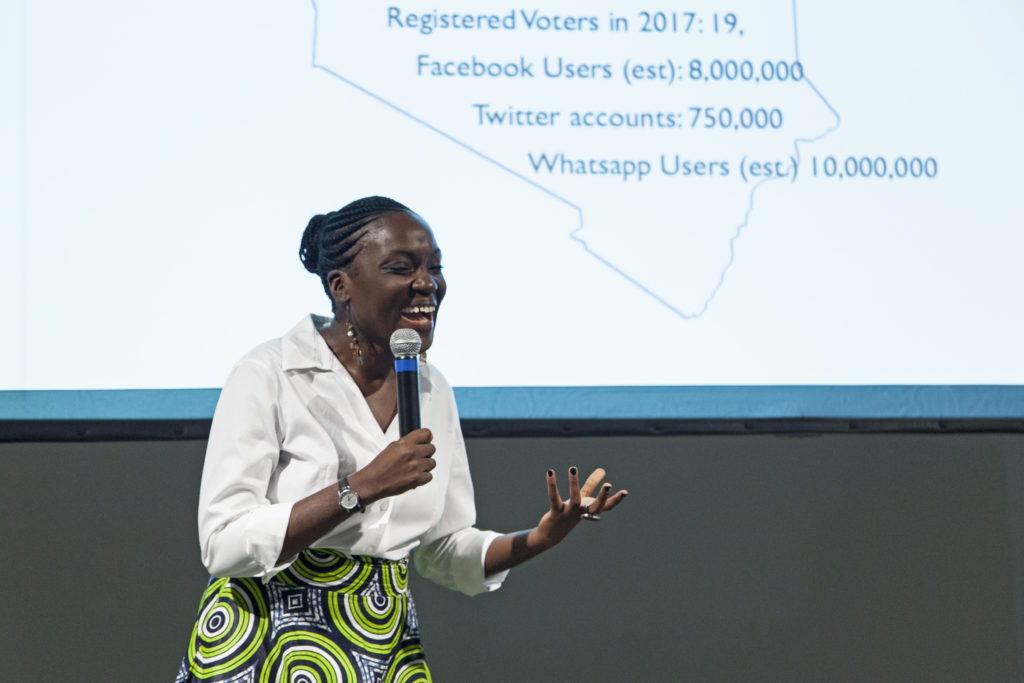
Rafiki, the innovative Kenyan film presented at the Cannes Film Festival, is now the subject of controversy over censorship due to its lesbian storyline. Nyabola is one of the African voices expressing the intention to support the movie’s distribution. “As something new and unexpected, this movie might make certain people within the country feel uncomfortable,” she said, “but it cannot be considered a vehicle for hate, promoting homosexuality in violation of moral values.” It is essential not to confuse actual hate speech with something labelled as hate speech to discredit it. Hate speech is intended to offend, insult, intimidate, or threaten an individual or group based on an attribute, such as sexual orientation, religion, colour, gender, or disability. The writer from Nairobi reminded the audience that when we talk about hate speech, it is important to focus on how it makes people feel and what it wants to accomplish. We should always consider that we regulate hate speech since it creates a condition in which social, political and economic violence is fed, affecting how we think about groups and individuals (and not just because it is offensive).
Nyabola indicated few key factors that she considers able to increase the consequences of hate speech and manipulation on social media. Firstly, information travels fast and can remain insulated. Whilst Twitter is a highly public space where content and comments flow freely, Facebook is a platform where you connect just with a smaller group of people, mostly friends, and WhatsApp is based on groups limited to a small number of contacts. The smaller the interaction sphere is, the harder it is for fact-checkers to see when and where rumours and hate speech go viral. It is difficult to find and stop them and their impact can be calculated just once they have already spread quickly and widely. Challenges which distinguish offline hate speech and manipulation from online ones are also related to the way information moves today among people supporting each other without a counterpart and without anyone being held to account.
Nowadays Kenya boasts an increasingly technological population, though not all rural areas have as yet been able to benefit from the country being one of the most connected ones in sub-Saharan Africa. In this context, reports indicate that since 2013 the British consulting firm Cambridge Analytica had been working in the country to interfere with elections, organizing conventions, orchestrating campaigns to sway the electorate away from specific candidates. It shall be no surprise that the reach of Cambridge Analytica extended well beyond United Kingdom and USA. In her speech, Nyabola expressed her frustration as she sees that western media focus their attention on developing countries just when they fear a threat of violence coming from there, ignoring that the rest of the world is also a place for innovation and decision making too.
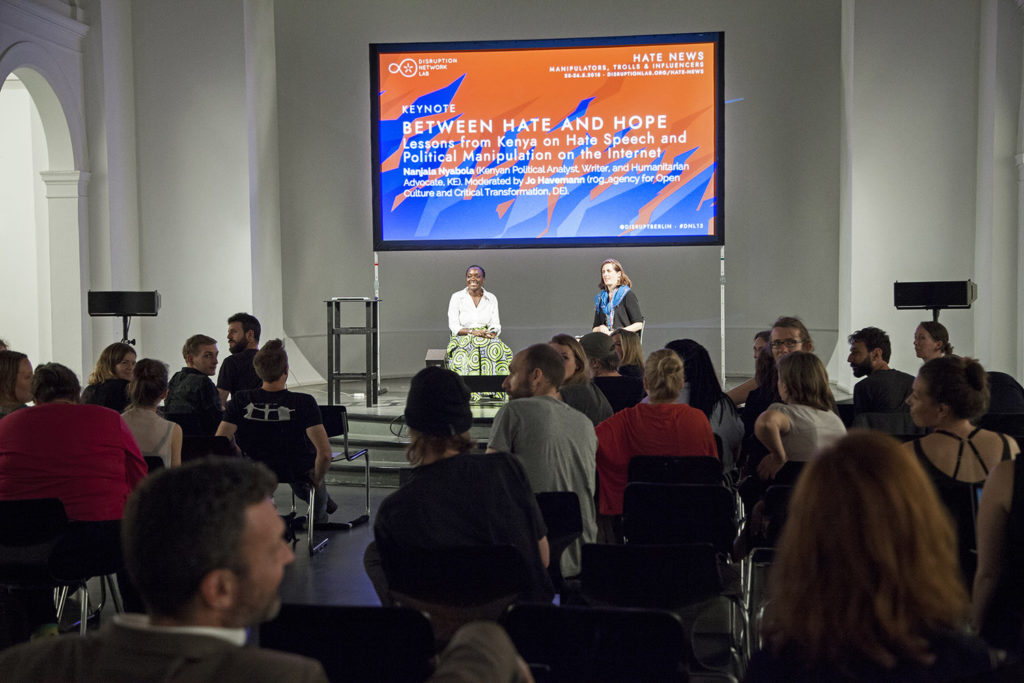
Kenya has one of the highest rates of Internet penetration in Africa with millions of active Kenyan Facebook and Twitter accounts. People using social media are a growing minority and they are learning how to defeat misinformation and manipulation. For them social media can become an instrument for social change. In the period of last year’s election none of the main networks covered news related to female candidates until the campaigns circulating on social media could no longer be ignored. These platforms are now a formidable tool in Kenya used to mobilize civil society to accomplish social, gender and economic equality. This positive look is hindered along the way by the reality of control and manipulation.
Most of the countries globally currently have no effective legal regulation to safeguard their citizens online. The GDPR legislation now in force in the EU obliges publishers and companies to comply with stricter rules within a geographic area when it comes to privacy and data harvesting. In Africa, national institutions are instead weaker, and self-regulation is often left in the hands of private companies. Therefore, citizens are even more vulnerable to manipulation and strategic hate speech. In Kenya, which still doesn’t have an effective data protection law, users have been subject to targeted manipulation. “The effects of such a polluted ecosystem of misinformation has affected and changed personal relationships and lives for good,” said the writer.
On social media, without regulations and control, hatred and discriminations can produce devastating consequences. Kenya is just one of the many countries experiencing this. Hate speech blasted on Facebook at the start of the Rohingya crisis in Myanmar. Nyabola criticized that, as in many other cases, the problem was there for all, but the company was not able to combat the spread of ethnic based discrimination and hate speech.
Moving from the interconnections of traditional and online media in Kenyan misinformation ecosystem, the second part of the day focused on privacy implications of behavioural profiling on social media, covering the controversy about Cambridge Analytica. The Friday’s panel opened with the analyses of David Carroll, best known as the professor who filed a lawsuit against Cambridge Analytica in the UK to gain a better understanding of what data the company had collected about him and to what purpose. When he got access to his voter file from the 2016 U.S. election, he realized the company had been secretly profiling him. Carroll was the first person to receive and publish his file, finding out that Cambridge Analytica held personal data on the vast majority of registered voters in the US. He then requested the precise details on how these were obtained, processed and used. After the British consulting firm refused to disclose, he decided to pursue a court case instead.
As Carroll is a U.S. citizen, Cambridge Analytica took for granted that he had neither recourse under federal U.S. legislation, nor under UK data protection legislation. They were wrong. The legal challenge in British court case that centred on Cambridge Analytica’s compliance with the UK Data Protection Act of 1998 could be applied because Carroll’s data was processed in the United Kingdom. The company filed for bankruptcy not long after it was revealed that it used the data of 87 million Facebook users to profile and manipulate them, likely in contravention of UK law. Professor Carroll could never imagine that his activity would demolish the company.
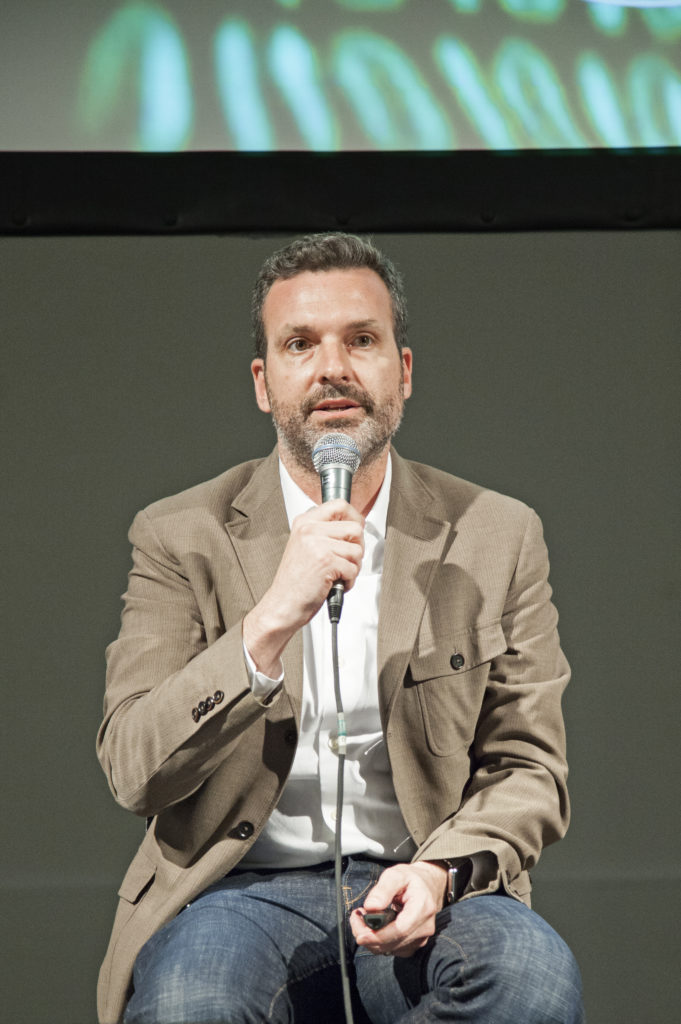
Cambridge Analytica, working with an election management firm called SCL Group, appears to have been a propaganda machine master, able to manipulate voters through the combination of psychometric data. It exploited Facebook likes and interactions above all. Its technique disguised attempts at political manipulation since they were integrated in the online environment.
Carroll talked about how technology and data were used to influence elections and popular voting for the first time in countries like USA and UK, whereas for a much longer time international campaign promoters were hired to act on an international scale. In Carroll’s opinion Cambridge Analytica was an ‘oil spill’ moment. It was an epiphany, a sudden deep understanding of what was happening on a broader scale. It made people aware of the threat to their privacy and the fact that many other companies harvest data.
Since 2012 Facebook and Google have been assigning a DoubleClick ID to users, attaching it to their accounts, de-anonymizing and tracking every action. It is an Ad-tracker that gives companies and advertisers the power to measure impressions and interactions with their campaigns. It also allows third-party platforms to set retargeting ads after users visit external websites, integrated with cookies, accomplishing targeted profiling at different levels. This is how the AdTech industry system works. Carroll gave a wide description of how insidious such a technique can be. When a user downloads an app to his smartphone to help with sport and staying healthy, it will not be a secret that what was downloaded is the product of a health insurance or a bank, to collect data of potential customers, to profile and acquire knowledge about individuals and groups. Ordinary users have no idea about what is hidden under the surface of their apps. Thousands of companies are synchronizing and exchanging their data, collected in a plethora of ways, and used to shape the messages that they see, building up a tailor-made propaganda that would not be recognizable, for example, as a political aid. This mechanism works in several ways and for different purposes: to sell a product, to sell a brand or to sell a politician.
In this context, Professor Carroll welcomed the New European GDPR legislation to improve the veracity of the information on the internet to create a safer environment. In his dissertation, Carroll explained that the way AdTech industry relates to our data now contaminates the quality of our lives, as singles and communities, affecting our private sphere and our choices. GDPR hopefully giving consumers more ownership over their data, constitutes a relevant risk for companies that don’t take steps to comply. In his analyses the U.S. professor pointed out how companies want users to believe that they are seriously committed to protecting privacy and that they can solve all conflicts between advertising and data protection. Carroll claimed though that they are merely consolidating their power to an unprecedented rate. Users have never been as exposed as they are today.
Media companies emphasize the idea that they are able to collect people’s data for good purposes and that – so far – it cannot be proved this activity is harmful. The truth is that these companies cannot even monitor effectively the Ads appearing on their platforms. A well-known case is the one of YouTube, accused of showing advertisements from multinational companies like Mercedes on channels promoting Nazis and jihad propaganda, who were monetizing from these ads.
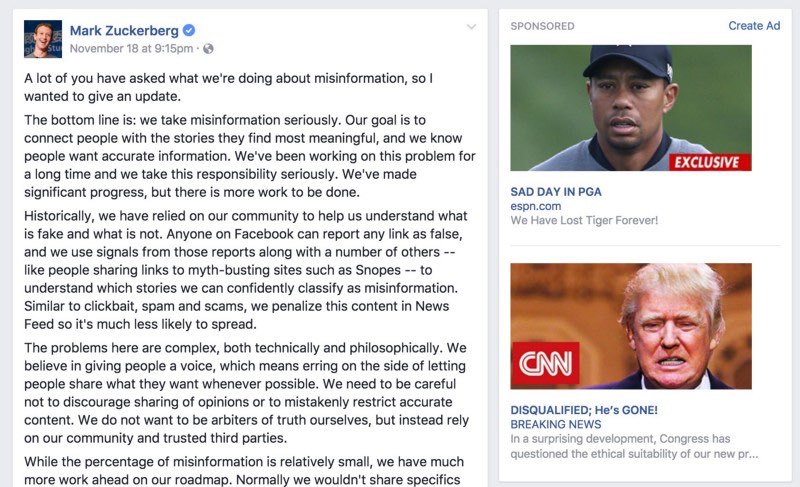
Carroll then focused on the industry of online advertisement and what he called “the fraud of the AdTech industry.” Economic data and results from this sector are unreliable and manipulated, as there are thousands of computers loading ads and making real money communicating to each other. This generates nowadays a market able to cheat the whole economy about 11 billion dollar a year. It consists of bots and easy clicks tailor-made for a user. The industries enabled this to happen and digital advertising ecosystem has evolved leading to an unsafe and colluded environment.
Alphabet and Facebook dominate the advertising business and are responsible for the use of most trackers. Publishers as well as AdTech platforms have the ability to link person-based identifiers by way of login and profile info.
Social scientists demonstrated that a few Facebook likes can be enough to reveal and accurately predict individual choices and ideas. Basic digital records are so used to automatically estimate a wide range of personal attributes and traits that are supposed to be part of a private sphere, like sexual orientation, religious beliefs, or political belonging. This new potential made politicians excited and they asked external companies to harvest data in order to generate a predictive model to exploit. Cambridge Analytica’s audience-targeting methodology was for several years “export-controlled by the British government”. It was classified as weapon by the House of Commons, at a weapons-grade communications tactics. It is comprehensible then that companies using this tech can easily sell their ability to influence voters and change the course of elections, polarizing the people using social networks.
The goal of such a manipulation and profiling is not to persuade everybody, but to increase the likelihood that specific individuals will react positively and engage with certain content, becoming part of the mechanism and feeding it. It is something that is supposed to work not for all but just for some of the members of a community. To find that small vulnerable slice of the U.S. population, for example, Cambridge Analytica had to profile a huge part of the electorate. By doing this it apparently succeeded in determining the final results, guiding and determining human behaviours and choices.
Bernd Fix, hacker veteran of the Chaos Computer Club in Germany, entered the panel conversation describing the development from the original principle of contemporary cybernetics, in order to contextualize the uncontrollable deviated system of Cambridge Analytica. He represented the cybernetic model as a control theory, by which a monitor compares what is happening into a system with a standard value representing what should be happening. When necessary, a controller adjusts the system’s behaviour accordingly to again reach that standard expected by the monitor. In his dissertation, Fix explained how this model, widely applied in interdisciplinary studies and fields, failed as things got more complex and it could not handle a huge amount of data in the form of cybernetics. Its evolution is called Machine Learning (or Artificial Intelligence), which is based on the training of a model (algorithm) to massive data sets to make predictions. Traditional IT has made way for the intelligence-based business model, which is now dominating the scene.
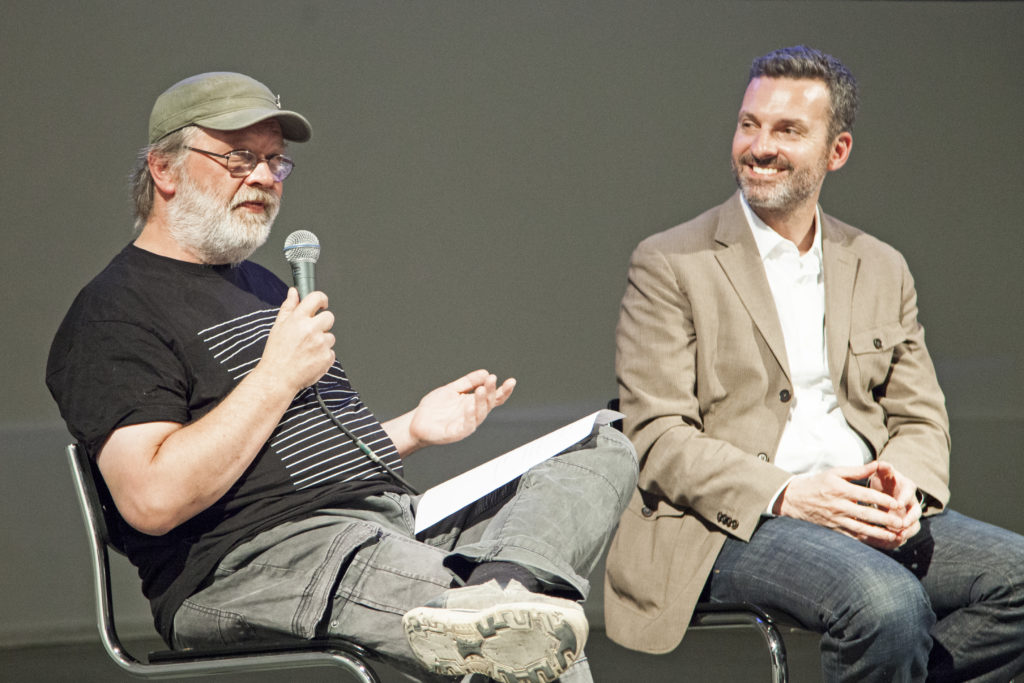
Machine learning can prognosticate with high accuracy what it is asked to, but – as the hacker explained – it is not possible to determine how the algorithm achieved the result. Nowadays most of our online environment works through algorithms that are programmed to fulfil their master’s interests, whereas big companies collect and analyse data to maximize their profit. All the services they provide, apparently for free, cost users their privacy. Thanks to the predictive model, they can create needs which convinces users to do something by subtle manipulating their perspective. Most of the responsibilities are on AdTech and social media companies, as they support a business model that is eroding privacy, rights and information. The challenge is now to make people understand that these companies do not act in their interest and that they are just stealing data from them to build up a psychometric profile to exploit.
The hacker reported eventually the scaring case of China’s platform “social credit,” designed to cover every aspect of online and offline existence and wanted by the national authorities. It is supposed to monitor each person and catalogue eventual “infractions and misbehaviours” using an algorithm to integrate them into a single score that rates the subjective fidelity into accepted social standards. A complex kind of ultimate social control, still in its prototype stages, but that could become part of our global future where socio-political regulation and control are governed by cybernetic regulatory circuits. Fix is not convinced that regulation can be the solution: to him, binding private actors and authorities to specific restriction as a way to hold them accountable is useless if people are not aware of what is going on. Most people around us are plugged into this dimension where the bargain of data seems to be irrelevant and the Big Three – Google, Facebook and Amazon – are allowed to self-determine the level of privacy. People are too often happy consumers who want companies to know their lives.
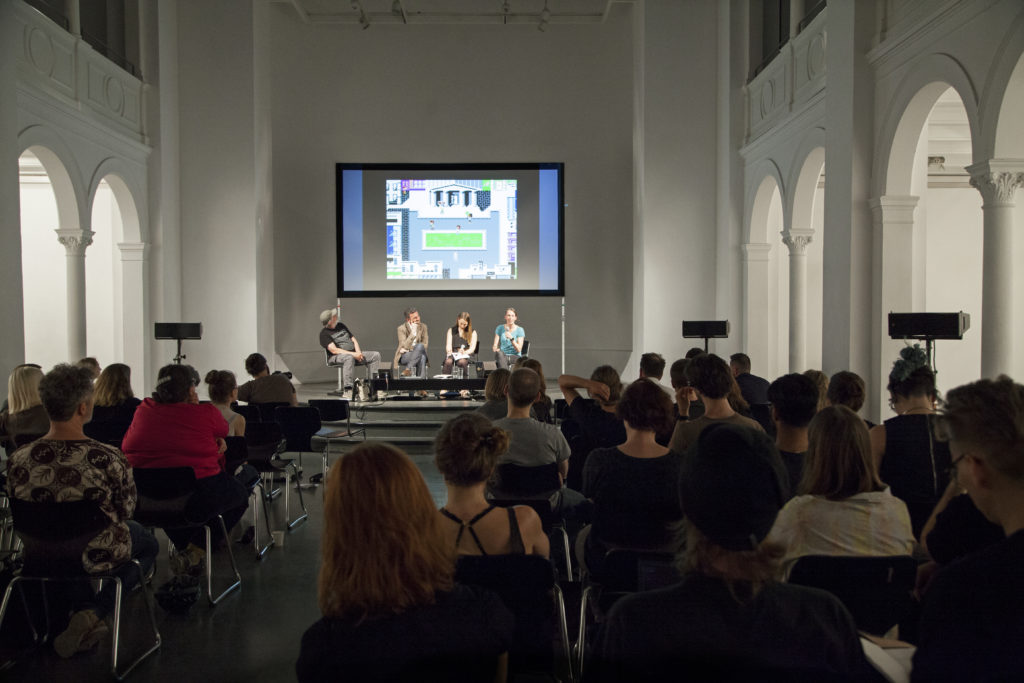
The last panellist of the afternoon was the artist and researcher Marloes de Valk, who co-developed a video game for old 1986 Nintendo consoles, which challenges the player to unveil, recognize and deconstruct techniques used to manipulate public opinion. The player faces the Propaganda Machine, level after level, to save the planet.
“Acid rains are natural phenomena”, “passive smoke doesn’t affect the health,” “greenhouse´s effects are irrelevant.” Such affirmations are a scientific aberration nowadays, but in the ‘80s there were private groups and corporations struggling to make them look like legitimate theorizations. The artist from Nederland analysed yesterday´s and today’s media landscape and, basing her research on precise misinformation campaigns, she succeeded in defying how propaganda has become more direct, maintaining all its old characteristics. De Valk looked, for example, for old documents from the American Tobacco Institute, for U.S. corporations‘leaked documents and also official articles from the press of the ´80s.
What remains is a dark-humoured game whose purpose is that of helping people to orientate inside the world of misinformation and deviated interests that affects our lives today. Where profit and lobbyism can be hidden behind a pseudoscientific point of view or be the reason rumours are spread around. The artist and researcher explained that what you find in the game represents the effects of late capitalism, where self-regulation together with complacent governments, that do not protect their citizens, shape a world where there is not room for transparency and accountability.
In the game, players get in contact with basic strategies of propaganda like “aggressively disseminate the facts you manufactured” or “seek allies: create connections, also secret ones”. The device used to play, from the same period of the misinformation campaigns, is an instrument that reminds with a bit of nostalgia where we started, but also where we are going. Things did not change from the ‘80s and corporations still try to sell us their ready-made opinion, to make more money and concentrate more power.
New international corporations like Facebook have refined their methods of propaganda and are able to create induced needs thus altering the representation of reality. We need to learn how to interact with such a polluted dimension. De Valk asked the audience to consider official statements like “we want to foster and facilitate free and open democratic debate and promote positive change in the world” (Twitter) and “we create technology that gives people the power to build community and bring the world closer together” (Facebook). There is a whole narrative built to emphasize their social relevance. By contextualising them within recent international events, it is possible to broad the understanding of what these companies want and how they manipulate people to obtain it.
What is the relation between deliberate spread of hate online and political manipulation?
As part of the Disruption Network Lab thematic series “Misinformation Ecosystems” the second day of the Conference investigated the ideology and reasons behind hate speech, focusing on stories of people who have been trapped and affected by hate campaigns, violence, and sexual assault both online and offline. The keynote event was introduced by Renata Avila, international lawyer from Guatemala and a digital rights advocate. Speaker was Andrea Noel, journalist from Mexico, “one of the most dangerous countries in the world for reporters and writers, with high rates of violence against women” as Avila remembered.
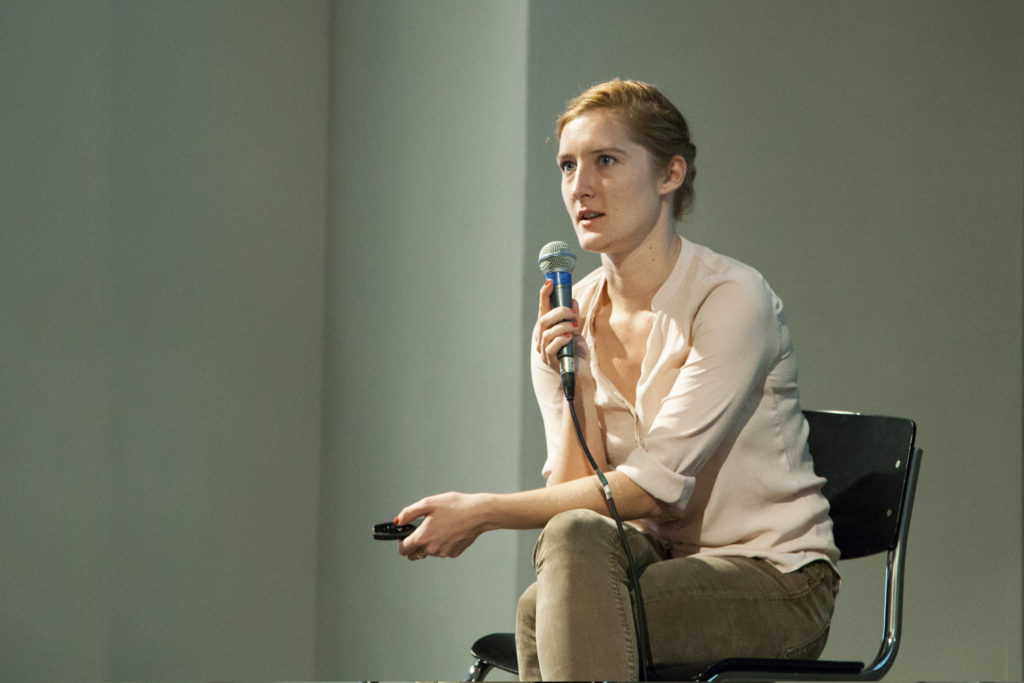
Noel has spent the last two years studying hate speech, fake news, bots, trolls and influencers. She decided to use her personal experience to focus on the correlation between misinformation and business, criminal organizations and politics. On March 8, 2016 it was International Women’s Day, and when Noel became a victim of a sexual assault. Whilst she was walking down the street in La Condesa (Mexico City) a man ran after her, suddenly lifted up her dress, and pulled her underwear down. It all lasted about 3 seconds.
As the journalist posted on twitter the surveillance footage of the assault commenting: “If anyone recognizes this idiot please identify him,” she spent the rest of the evening and the following morning facing trolls, who supported the attacker. In one day her name became trend topic on twitter on a national level, in a few days the assault was international news. She became so subject of haters and target of a misogynistic and sexist campaign too, which forced her to move abroad as the threat became concrete and her private address was disclosed. Trolls targeted her with the purpose of intimidating her, sending rape and death threats, pictures of decapitated heads, machetes and guns.
In Mexico women are murdered, abused and raped daily. They are victims of family members, husbands, authorities, criminals and strangers. Trolls are since ever active online promoting offensive hashtags, such as #MujerGolpeadaMujerFeliz, which translates as ‘a beaten woman is a happy woman’. It is a spectrum of the machismo culture affecting also many Latin American countries and the epidemic of gender-based violence and sexual assault.
Facts can be irrelevant against a torrent of abuse and hate toward journalists. Noel also received hundreds of messages telling her that there was a group of famous pranksters named “master trolls” that used to assault people on the streets in that same way, to make clicks and money out of it. Noel found out that they became best known for pulling down people’s pants and underwear in public, and that this brought them directly to popular tv shows. A profitable and growing business.
The journalist decided to face her trolls one by one and later realized that they were mostly part of an organized activity, not from a TV show but from a political group targeting her, a fact that made everything way more intricate. In two years she “got to know her trolls” as she said, and she studied their ecosystem. The description of the whole story is available on podcast Reply All.
Moving from her story, Noel focused in her second part of dissertation on the relation linking together trolls, criminal organizations, political and social manipulation. She described how, by using algorithms, bots and trolls, it is possible to generate political and election related postings on Facebook and Twitter that go viral. Manipulation comes also by weaponizing memes to propel hate speech and denigration, creating false campaigns to distract public attention from real news like corruption and atrocious cartel crimes.
Marginal voices and fake news can be spread by inflating the number of retweets and shares. Hashtags and trends are part of orchestrated system, where publishers and social media are not held in account for the fraud. Automated or semi-automated accounts, which manipulate public opinion by boosting the popularity of online posts and amplifying rumours. There is a universe of humans acting like bots, controlling hundreds of fake accounts.
Noel is particularly critical against Twitter. Its legal team expressed their engagement facing this “new major problem and novel threats”. The journalist hypothesized that the company had been well aware of the issue since 2010 but decided not to intervene to weed out organized groups manipulating its environment. Moreover, they knew that organized campaigns of discredit can water down the impact of real grassroot spontaneous protests and movements.
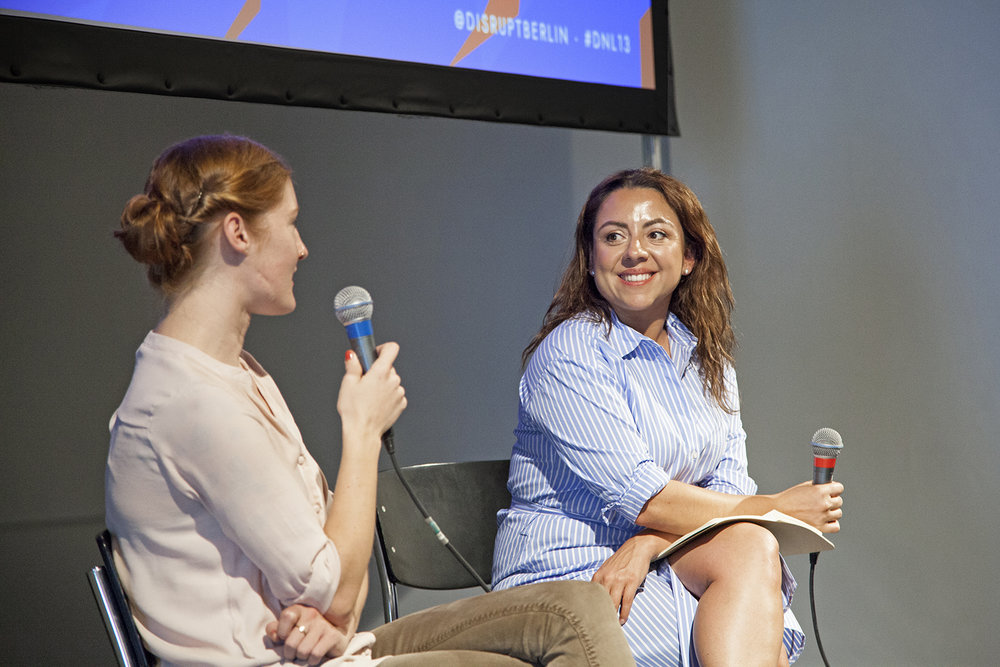
These manipulation techniques are responsible for digitally swaying the 2016 election toward the candidate Peña Nieto, organizing an army of thousands of bots to artificially generate trends on Twitter. Trends on this social media move up and down based on the number of tweets in a topic or hashtag related to the speed of sharing or retweeting. Trolls and bots can easily control the trending topic mechanism with their intense spamming activity.
Noel reported that false stories are shared via WhatsApp too, they are difficult to track and the most challenging to debunk. Her portrayal of social media and information market is not different from the description on the first day of the Conference by the writer Najala Nyabola.
To see the future of social media manipulation in politics we need to look at Mexico. All parties in Mexico have used bots to promote their own campaigns, journalists and opponents are overwhelmed with meaningless spam and denigrating hashtags. Offline, media landscape across Mexico is not free and organised crime has been using propaganda and manipulation to further its own aims. President Peña Nieto’s administration spent hundreds of millions of dollars on advertising, making media dependent and colluded. This system suppresses investigative articles and intimidates reporters.
The next general election is scheduled for July 1st. Andrea Noel warned that manipulation, trolls and bots are already irreversibly polluting the debate, in a country where more than 100 candidates have already been murdered (at the time of the Conference) and a history of corruption makes media and authorities unreliable in the eyes of people.
As a response, universities and NGOs formed an anti-fake news initiative called “Verificado” a platform that encourages people to forward stories found on social media using the hashtag #QuieroQueVerifiquen, ‘I want you to verify this’. The researchers of this project answer with fact-checking and publish their findings online. When asked, Noel expressed appreciation for the efforts of organizations and civil society. However, she is becoming increasingly disillusioned. She can see no immediate prospect of finding solutions able to slow or halt the impact of misinformation and hate speech online. In her opinion projects like Verificado can be easily hijacked. On the other side genuine social media campaigns are still an effective tool in the hands of civil society but the lack of trust in media fed by corruption often undermines all efforts to mobilize society, leading the public to routinely dismiss initiative to fight injustice.
When asked about the possibility to shut down social networks as a solution, Noel could not say she did not think of it. A first step could be to oblige media like Twitter and Facebook to guarantee users a safe environment where the economic interest comes after the need of a hate speech and manipulation free environment. The way they operate confirms they are content platforms and as such media entities they lack of transparency and accountability. These companies shirk their obligation for publishing responsibly. They should be held to account when they spin lies and allow groups to act unethically or against target single or communities.
The program of the second day continued with the presentation of the documentary The Cleaners, by Hans Block and Moritz Riesewieck, a project started in 2013 and in the cinemas at the time of the Conference. Initially, the authors wanted to learn more about the removal of pedo-pornographic content and sexualised images of children on Facebook. Social networks have largely pledged to work harder to identify and remove illegal, offensive and improper content, to limit violations and deny hate speech. But how does it work? Who decides what shall be cancelled and on what basis? These questions arose frequently during the first part of the Hate News conference and the German authors could answer it in relation to the social media Facebook, subject of their documentary.
The choice about what shall and what shall not belong the internet is a subjective one. Content moderators, who censor postings and content on platforms like Facebook, have indeed a controversial and central role. Their work is subject to almost no open scrutiny. However, it shapes attitudes and trends of both individuals and social groups, impacting the public discourse and the cultural dialectic. When a social network decides to censor content and delate videos about the effects of drone bombings, since by showing civilian victims Daesh builds its propaganda, it makes a choice that affects the narration of events and the perception of facts.
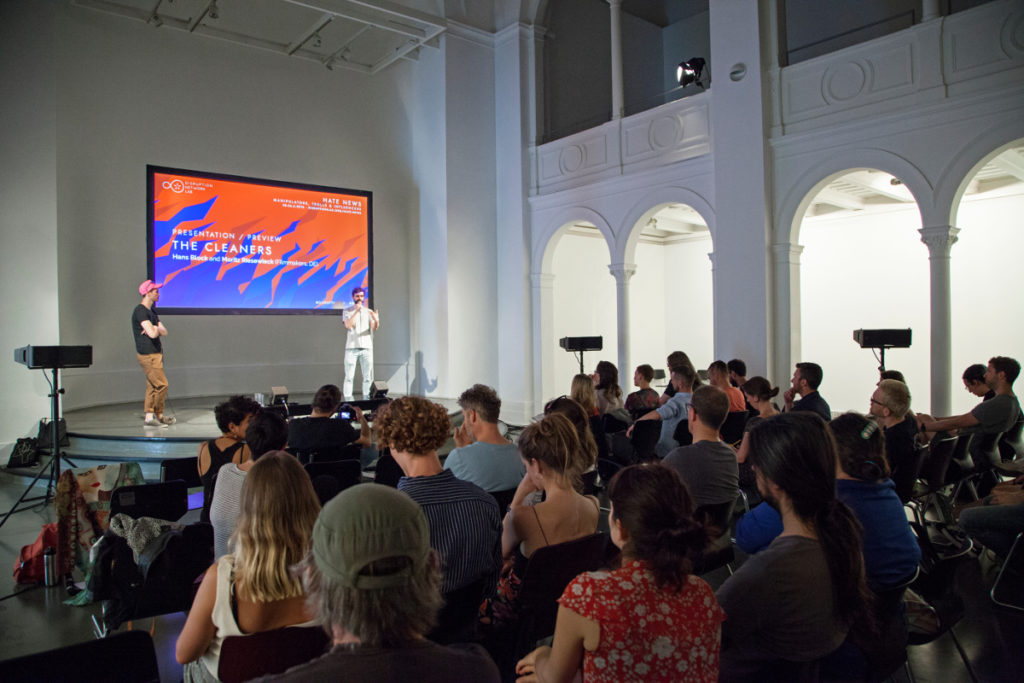
Investigating how the social media platform Facebook polices online content, and the direct impact of these decisions on the users’ interactions, Block and Riesewieck ended up in the Manila, where Facebook boasts its biggest department for content moderation, with more than 10,000 contractors. The Cleaners shows how this platform sees its responsibilities, both toward people moderating and censoring the content and its users. Based on interviews with Philippine content moderators at work, the documentary contributes to the debate about the public responsibilities of social media and online platforms for publishing, from political manipulation and propaganda to data protection.
Humans are still the first line of content moderation and they suffer horrible consequences and traumas for they see daily the worst of the web. Companies like Facebook have developed algorithms and artificial-intelligence tools able to work as a first level, but the most of this technology cannot substitute human capabilities. Certain content moderators describe themselves as custodians of moral values, as their work turns into decisions that can shape social media and consequently society. There are indeed countries where people consider Facebook as the Internet, ignoring that the world wide web is much more than that social media.
The authors go beyond, showing that Manila cleaners are influenced by their cultural background and social believes. They build a parallel between Philippines’ Catholicism and discourse about universal enslavement of humans to God and sacrifice, photographed in the years of the government of Rodrigo Duterte, controversial president who is leading a war against drugs and moral corruption, made of extrajudicial killings and a violent, abusive approach.
Despite denials by the company, cleaners in Manila also moderate Europeans’ posts and they are trained for that. A single world, a historical reference, together with a picture can make all the difference between an innocent joke and hate speech. Whilst memes can be used as weapons, for example by the alt-right groups or by reactionary movements against gender equality, cleaners have just few seconds to decide between removing and keeping a content, checking more than 35,000 images per day. The authors of the documentary explained how it is almost impossible for them to contextualize content. As a result, there is almost no control over their work, as a team leader can just proof 3% of what a cleaner does.
The last panel closing the conference on the second day was moderated by the curator, artist and writer Margarita Tsomou. American independent online harassment researcher Caroline Sinders focused her dissertation on online protests and political campaigns in the frame of the hate speech discourse. She recalled recent events able to pollute the public debate by creating chaotic and misleading messages to enhance a reactionary anti-progressive culture. Misogyny thrives on social media and hatred of women and entrenched prejudice against them are everywhere in the Internet. Fake online campaigns are often subtly orchestrated targeting women.
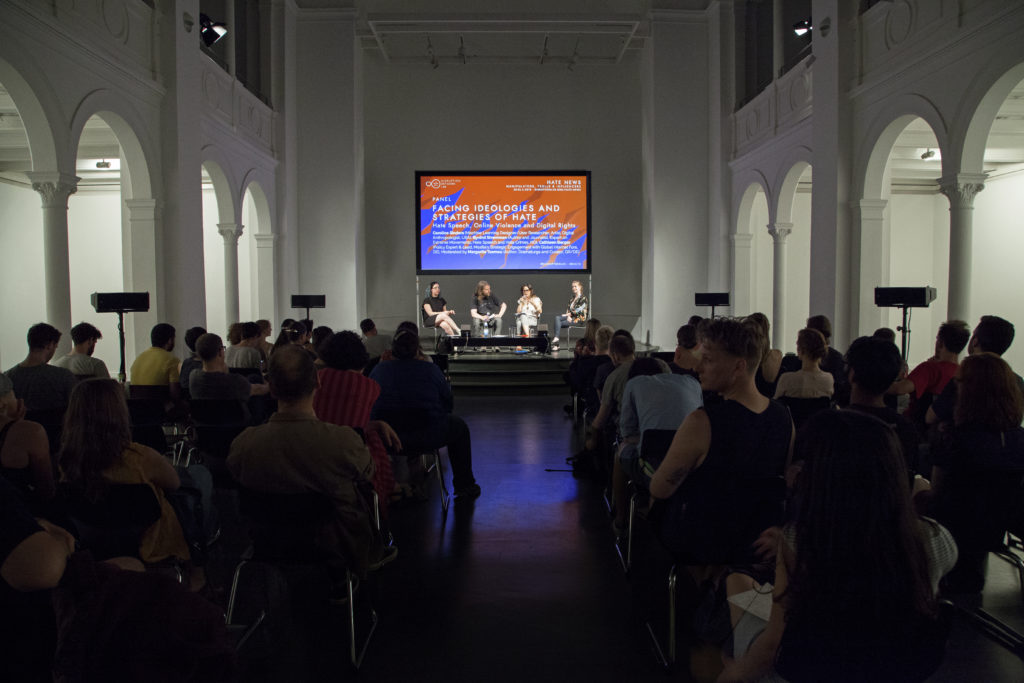
In 2014 on social networks appeared an organised action associated with the hashtag #EndFathersDay, presented as a feminist political campaign to eradicate the celebration of Father’s Day as a “celebration of patriarchy and oppression”. That campaign had nothing to do with feminism and grassroots movements, it was a harassment campaign against women, a fake with manipulated images and hundreds of trolls to feed a sentiment of hatred and hostility against activists for civil rights and equality.
It is not the only case of its genre. The #Gamergate campaign, that in 2014 targeted several women from the video game industry (on Twitter, Reddit, 4chan, and 8chan) falls into this context. The campaign was not immediately perceived as a harassment instrument due to attempts of making it appear as a movement against political correctness and bad journalistic ethics. It was though a misogynistic reactionary campaign against female game developers, that soon revealed its true face as right-wing sexist backlash. Under this hashtag women were indeed victims of doxing, threats of rape and death.
Sinders explained that in the last several years we have seen a shift from a sectorial market to a global dimension where we are all potentially identifiable as gamers. Video games and gaming culture are now mainstream. People are continuously connected to all kind of devices that enable the global gaming industry to generate more than 100 billion dollar every year. The Gamergate controversy reopened the debate that gaming is a world for (white) males, pointing out how the video game industry has a diversity problem, as sexism, racial and gender discrimination in video game culture appear to be a constant factor.
A relevant aspect of the controversy is related to how trolls organised and tried to reframe the narrative of the harassment campaign. Instead of a misogynistic and violent action, they claimed it was about journalistic integrity and candid reviewing, thus denouncing a collusion between the press and feminists and social critics. Most of the trolls and supporters were anonymous, ensuring that the campaign be defined merely by the harassment they have committed against women and as a reaction to what they reported as the increasing influence of feminism on video game culture.
Sinders concluded her speech explaining that organised actions and campaigns like those described above are structured on precise tactics and harassment techniques that have already entered in our vocabulary. Words like doxing, swatting, sealioning and dogpiling are neologisms that describe strategies of hate speech and harassment nowadays common.
The Norwegian journalist Øyvind Strømmen, author and managing editor of Hate Speech International, has extensively researched and written about how extreme right movements and religious fundamentalism are able to build an effective communication online and use the web as an infrastructure to strategically enhance their activities. He joined the panel explaining that despite his intense international activity, he has never been subjected to harassment and death threats like his female colleagues, whilst he finds daily-organised activities to sow hatred and intolerance to repress women.
Cathleen Berger, former International cyber policy coordination staff at the German Foreign Office and currently lead of Mozilla’s strategic engagement with global Internet fora, closed the conference with an analyses of the new German NetzDG legislation, defined by media as an extreme example of efforts by governments to make social media liable for what circulates on their pages. The law was adopted at the end of 2017 to combat illegal and harmful content on social media platforms. It is defined also as anti-hate-speech law as it was written in the historical context of the refugees’ mass migration to Europe and the new neo-nazi propaganda from political formations like the Alternative for Germany (AfD). At the time, fake news and racist material were shared online on several mainstream channels for the first time, with relevant impact on public opinion.
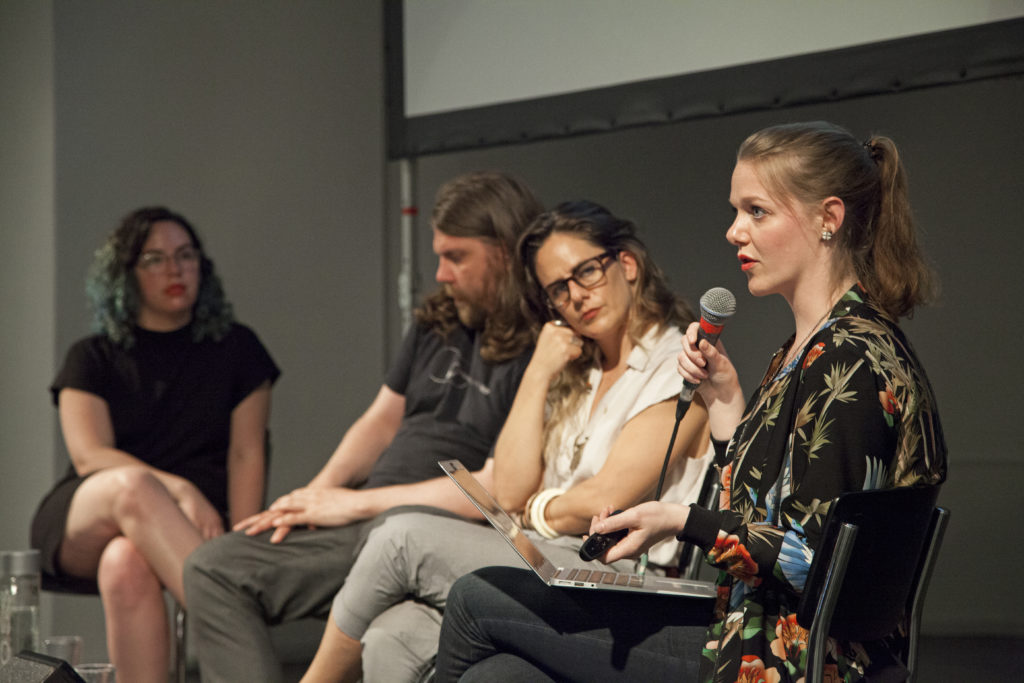
The new German law requires social media companies to provide users with a wide-ranging complaints structure to make sure that discriminatory and illegal posts can quickly be reported. It is left to social media platforms to decide if a certain reported content represents a promotion of or an incitement to terrorism, child abuse, hate or discrimination of any kind.
The law forces social media to act quickly too. Under NetzDG, social media platforms with more than 2 million users in Germany have 24 hours to remove posts reported by users for being illegal. Facebook, Twitter and YouTube seem to be the law’s main focus. Failure to comply with the law carries a fine up to € 50 million.
The German government’s Network Enforcement Act has been criticised for its risks of controversial inadvertent censorship, limiting legitimate expressions of opinion and free speech. Once again private companies, that are neither judges nor any kind of public authority, have the power to decide whether reported content is in fact unlawful.
All credit is due to Tatiana Bazzichelli and the Disruption Network Lab, who provided once again a forum for discussion and exchange of information that provokes awareness on matters of particular concern from the different perspectives of the guests – especially women – able to photograph with their international activities and their researches several topical issues.
This 13th Conference (https://www.disruptionlab.org/hate-news/) was a valid opportunity to discuss and rationalise the need for civil society to remain globally vigilant against new forms of hate speech, manipulation and censorship. Ideological reasons behind hate speech and online manipulation are on the table and the framing is clear enough to hold online media and publishing companies accountable for the spread of frauds, falsehood and discrimination within their networks.
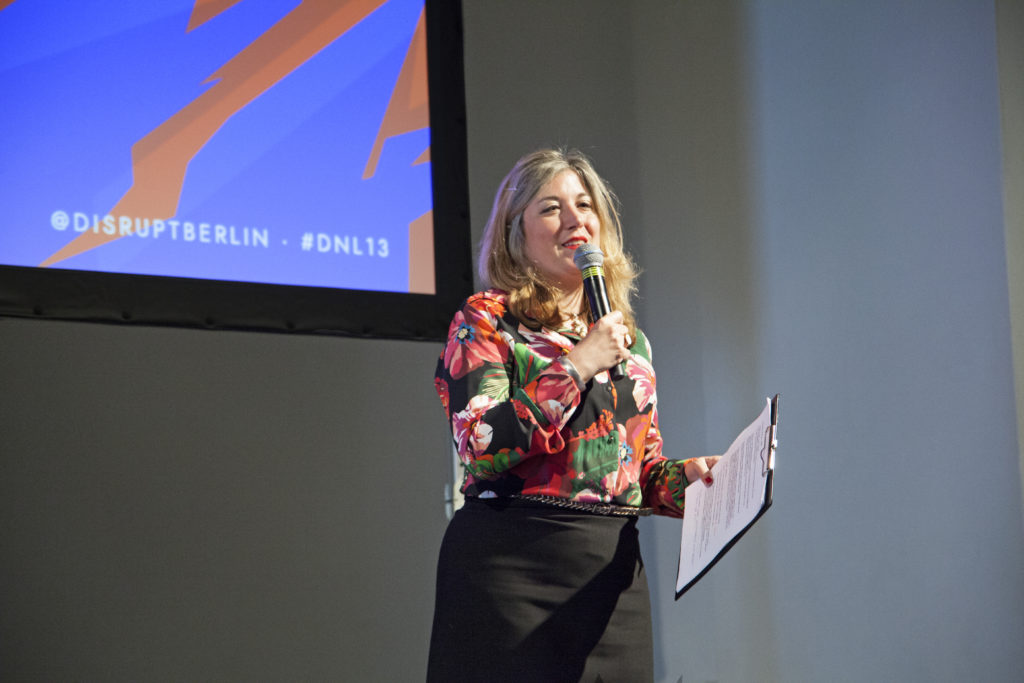
Companies like Facebook and Twitter have demonstrated their inability to recognise real threats and appear to be thinking of profit and control without considering the repercussions that their choices have. However, we are delegating them the power to define what is legal and what is not. Their power of censorship shapes society, interfering with fundamental rights and freedoms, feeding conflicts and polarization. This legal response to hate speech and manipulation in the context of the battle for privacy and civil rights is completely inadequate.
Propaganda and hate speech have historically been tools used in all countries to influence decision making and to manipulate and scare public opinion. Forms of intrusive persuasion that use rumours or manipulation to influence people’s choices, beliefs and behaviours are now occupying the web too. Individuals should be able to give due value to their online interactions, focusing on the risks that they run when they click on something. There is too little awareness of how companies, aggressive trolls, criminals, private groups and advertisers subtly manipulate online environment for political and economic interest.
Such a corrupted online ecosystem – where almost nothing of what we meet can be trusted and where individuals and communities are exposed to private interest – generates often hate campaigns targeting women and minorities, normalising crimes, reactionary gender stereotyping and deplorable cultural customs. As all speakers suggested, Cyber-ethnography can be a worthwhile tool as an online research method to study communities and cultures created through computer-mediated social interaction. It could be helpful to study local online exchanges and find local solutions. By researching available data from its microcosmos, it is possible to prevent ethnic, socioeconomic, and political conflicts linked to the online activity of manipulators, destructive trolls and influential groups, to disrupt the insularity of closed media and unveil the economic and political interest behind them.
HATE NEWS: Manipulators, Trolls & Influencers
May 25-26, 2018 – Kunstquartier Bethanien, Berlin
disruptionlab.org/hate-news/
Info about the 13th Disruption Network Lab Conference, its speakers and thematic is available online here:
https://www.disruptionlab.org/hate-news
To follow the Disruption Network Lab sign up for its Newsletter and get informed about its Conferences, ongoing researches and projects. The next Disruption Network Lab event is planned for September. Make sure you don´t miss it!
The Disruption Network Lab is also on Twitter and Facebook
Photocredits: Maria Silvano for Disruption Network Lab
TERROR FEEDS: Inside the Fear Machine, took place in Berlin November 24-25 2017, and was an analysis of ISIS and its media strategy, the meaning of cyber jihad, and why people enroll as foreign fighters. The 12th conference of the Disruption Network Lab was directed by Tatiana Bazzichelli. Studio 1, Mariannenplatz 2, 10997 Berlin.
Curated by Tatiana Bazzichelli and investigative journalist Mauro Mondello. In cooperation with Kunstraum Kreuzberg /Bethanien, SPEKTRUM and Supermarkt Berlin. Funded by the Reva & David Logan Foundation (grant provided by NEO Philanthropy), the Mozilla Foundation, the Bertha Foundation and the Checkpoint Charlie Foundation. Supported by: the Radicalisation Awareness Network (RAN). In collaboration with the Alexander von Humboldt Institute for Internet and Society (HIIG). Media Partners: ExBerliner, Furtherfield.
To analyse the operational methodology of ISIS means to understand terrorism beyond general terms and not only in reference to the Islamist group. It has updated its strategies during the years, making communication a decisive element of its system. ISIS has shown us how it is possible today, through the networking and the fluidity of information exist runs and build a structure, on several levels and far from a geographically fixed dimension. We are used to thinking about such situations in traditional ways when we refer to paramilitary organisations, and not in such elusive terms where the enemies are so difficult to control, and very difficult to identify. The Terror Feeds conference, has made it possible for us to focus on how terrorism is conducted, in how electronic jihad and strategic messaging affects the worldwide public opinion, both in the west and in the Arab world, representing a new icon of “global jihad”.
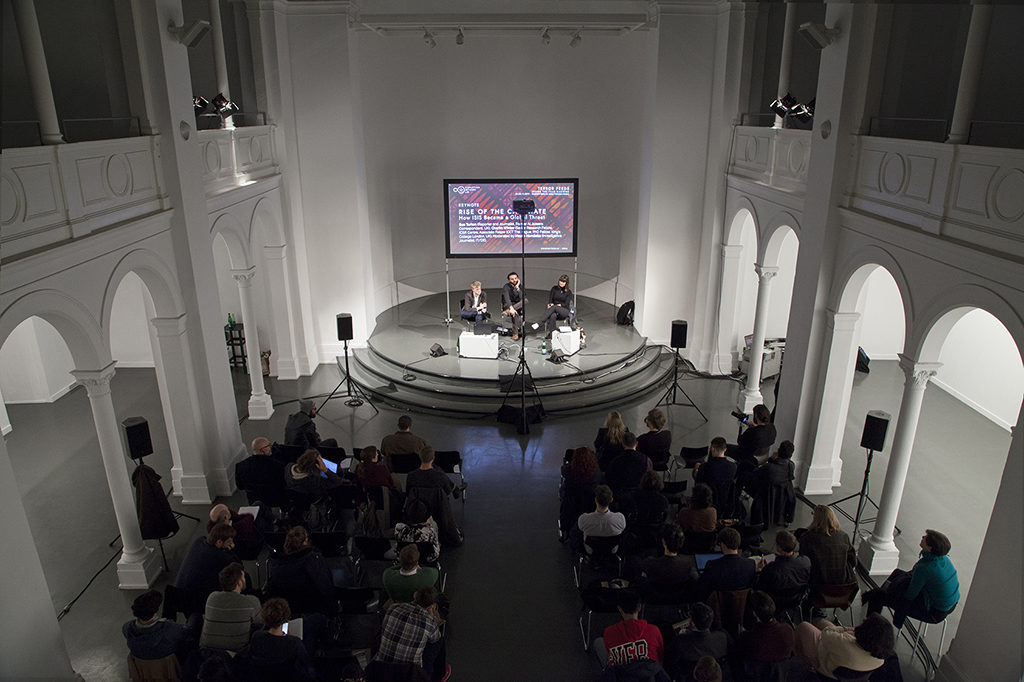
It is a fact that the territories which were once dominated by ISIS have now collapsed and are fragmenting into smaller, chaotic forms of inter-connected, spurious networks, scattered in the rural parts of Iraq and Syria. Nevertheless the group will go on and transform into something else, adapting its strategy.
“ISIS seems to have taken its foot off the official media pedal and is now instead, putting more effort into the logistics side of its insurgent equation”, said Charlie Winter, researcher at King’s College London, during the first panel of the Disruption Network Lab conference. “This change is part of a shift prefigured by the organisation’s changing emphasis on Hijrah, the act of travelling to the caliphate to join the Islamic State. On one side, Hijrah is still promoted but ISIS no longer prioritises this form of recruitment”.
During his speech at the conference, Charlie Winter focused on the importance of propaganda for ISIS, and how their production and dissemination is at times considered to be even more important than the military side of the Jihad itself. Winter says, the caliphate message is entirely non-spontaneous and based on three principles: a coherent, positive and alternative narrative; a rejection-based counter-speech operations; the launching of occasional, carefully calibrated media “projectiles”. The mainstream is considered as an effective weapon that can exceed the power of the most powerful bombs.
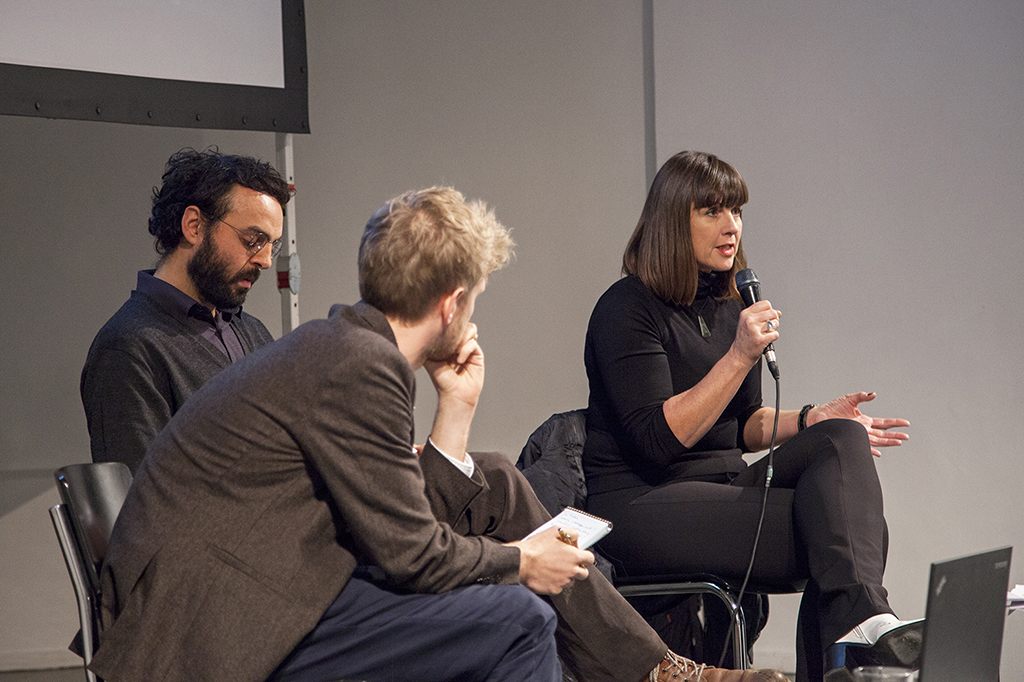
Sue Turton, former Al Jazeera correspondent, writer and journalist, explained during her speech at the conference that ISIS strength is built on its capacity to reach through its propaganda, at people sitting at home eating their dinner with the aim to transform these viewers into ISIS fighters, wherever they are in world. “In some way, ISIS is exciting and gives these individuals the feeling that they’re doing something right and that they accomplish something for their faith.”
“Isis has an extensive network of media experts and social media accounts”, said Dlshad Othman, security engineer and speaker of the Keynote. Focused on the so called Cyber Jihad, “ISIS, has been able to hack government websites and carry out attacks on thousands of Syrian activists social networking accounts, to develop malware, as well as hack the White House website. Cyber Jihad is an organised branch of the ISIS’s military strategy and has been able to be used as a main element to reinforce its structure. Cyber Jihad started with doing very simple malware and then increased its level right up to a very well organised phishing campaign.”
Another way to understand how ISIS works is to look at the documents relating to the ISIS administration. “The records sometimes can say more about Isis than the propaganda it releases everyday”, says Jihad-Intel Research Fellow at the Middle East Forum, Aymenn al-Tamimi. The reach and wide “impact and influence, of ISIS media development over time, is pretty clear,” and you can see this reflected in “how many other military groups are trying to emulate the ISIS media strategy in Syria, today .”
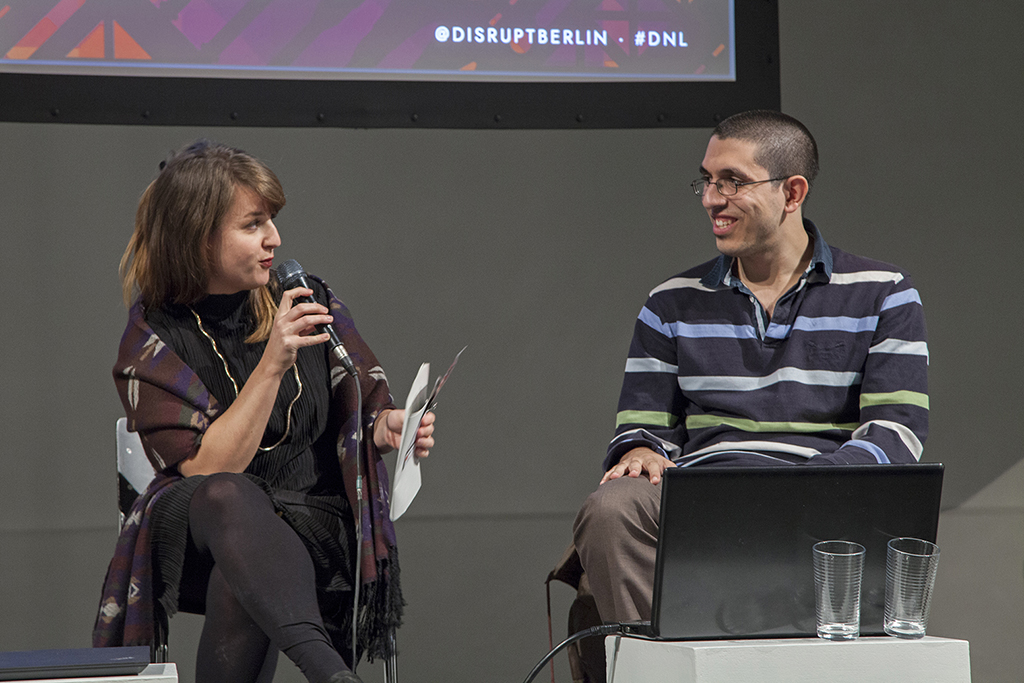
ISIS marked a new path especially concerning the recruitment of fighters, demanding Muslims across the world to swear allegiance and migrate to a territory under its control, and also demanded that other jihadist groups worldwide accept its supposed, supreme authority. “In order to understand ISIS – points out Saud al-Zaid, Scholar of Islamic Studies, Berlin Graduate School of Muslim Cultures and speaker at the Disruption Network Lab conference during the keynote Radicalized: the franchise of terror – “it is crucial to make a difference among individuals, societies and cultures in the ISIS world and to start focusing on what they all have in common, that of course is, first of all, support for the terrorist group”. Al-Zaid concentrate on the distinctions, in terms of conflict, between Native and Foreign fighters. “It is not so easy to distinguish, for example, between a guy from Falluja, Iraq, and another one from Yemen,” Sayd al-Zaid during his speech at Terror Feeds conference. In the words of Peter Van Ostayen, also a speaker during the Radicalized: the franchise of terror keynote, “half of jihad is media”. For Van Ostayen, Historian and Arabist, PhD candidate at KU Leuven, “half of jihad is social media, especially in the recruitment, as we can see exploring the recruitment process of Belgian foreign fighters: more than 600 Belgian individuals joined or tried to join ISIS in Iraq and Syria”.
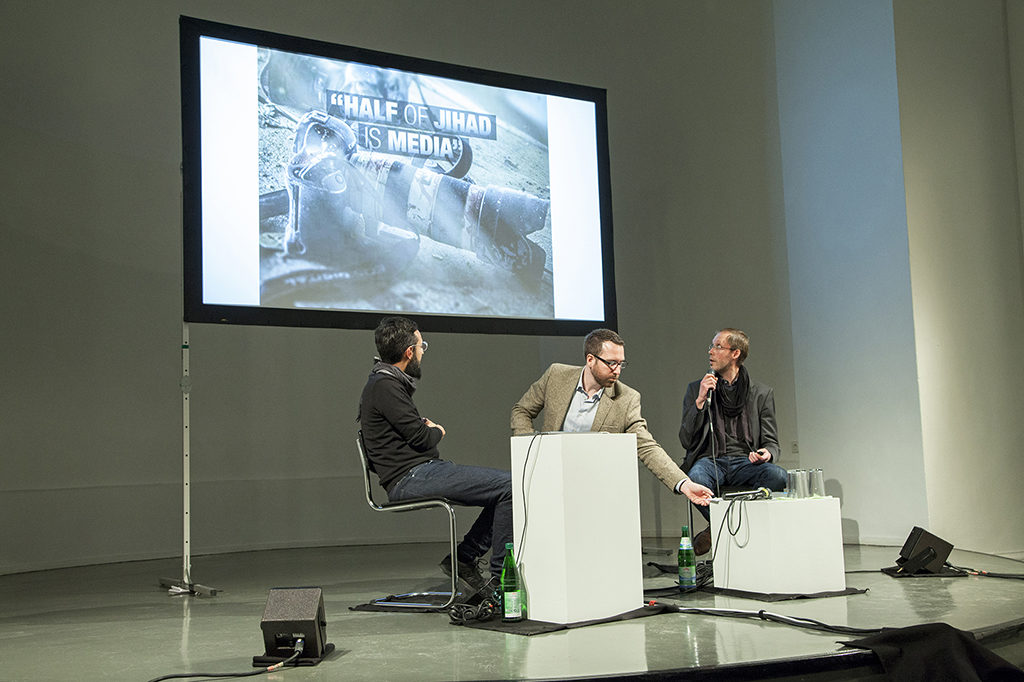
Counter-extremism strategies and prevention also are an issue to consider in the context of increased public fear about homegrown terrorism. “Initially our prevention strategy was not focused on schools and teachers, but engaging with civil society, mainly trying to prevent young people, entirely from Muslim communities, from becoming extremist” – explained Tufyal Choudhury, Assistant Professor at the University of Durham Law School in England, during the Prevention and Prejudice panel – “Than the government changed in 2010, so Prevent policy changed too, in two important ways: Prevent was not anymore focused on all forms of extremism and was not just concentrated on violent radicalization, but also on extreme ideology. Of course this created another issue: we needed to understand what non violent extremism was”. Michéle Hassen, Working Group Leader at RAN, Radicalisation Awareness Network, also a speaker during the Prevention panel, stated that “we’ve not a problem with the concept of radicalisation, but it is different when radicalisation leads to hate crimes and terrorism.” For Sindyan Qasem, Research Associate at the University of Münster, Centre for Islamic Theology, the question about Prevention and Radicalisation is how do vague conceptualisation of radicalisation and extremism lead to the infringement of human rights. “I personally think that preventive measures against islamic extremism are almost always based on ideology, so the educational measures and countering extremism in schools is based on giving alternatives to the ideology of islamic extremism”.
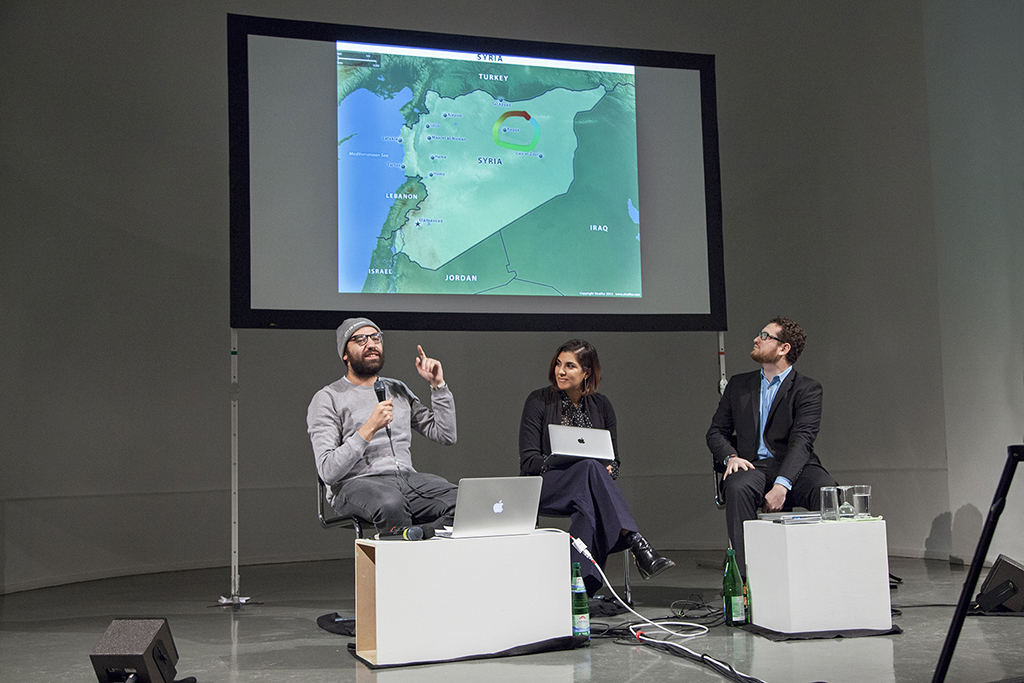
Among the goals of the conference was to focus on the territorial challenges provoked by ISIS. In this sense, Abdalaziz Alhamza co-founder of the blog Raqqa Is Being Slaughtered Silently and Media Activist, shared the experience of living in a Raqqa under ISIS control, trying to resist and documenting the daily life in the “Islamic Caliphate”. “ISIS prevented all media organisations to cover the conflict, so it was very important to show what was going on,” explained Alhamza. “ISIS did mistakes that we were able to analyse and spread to others. Although, most people just had ISIS propaganda and they slowly started believing in it, so we decided to target everyone. Most of the people had no internet access, so we went speaking with people, we went to schools, we went to Arab communities, to tell them what was going on”. During the same keynote, “Fractured Lands: confronting the Islamic State”, Aaron Zelin, Founder of Jihadology.net and Richard Borow Fellow at the Washington Institute, explained how IS got from no territorial control to full territorial control. “The so-called Caliphate Project was the idea to establish an Islamic State upon prophetic methodology and based on their interpretation of sharia’a, the Islamic law – said Zelin – they also wanted to build a global network of members and supporters, overthrowing the post-World War II American international system. It’s important to understand how they built their structure in Iraq and Syria because it is a guide to their development or regression in other areas, like Philippines, or Libya or Somalia or maybe Europe in 15 or 20 years, considering the polarization that is happening in the european society”.
Despite the rout of the Islamic State last year and steady Syrian government advances in territories controlled by the group, a mis-perception has grown abroad that Islamic State (and Syrian war), is winding down. Instead, the carnage is reaching a new peak in Iraq and Syria: much of the world cheered the collapse of Islamic State caliphate, but that victory just cleared the way for a new stage of the conflict, with IS ready to come back again.
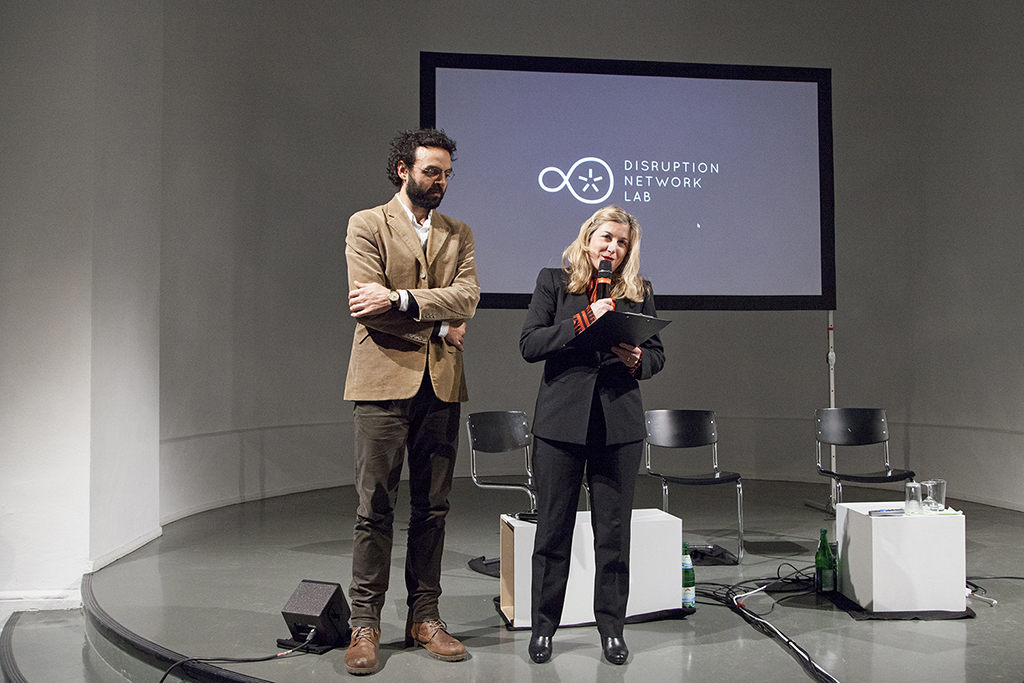
Photos by Maria Silvano for Disruption Network Lab.
More info about Disruption Network Lab:
disruptionlab.org – @disruptberlin